NTN Tapered Roller Bearing
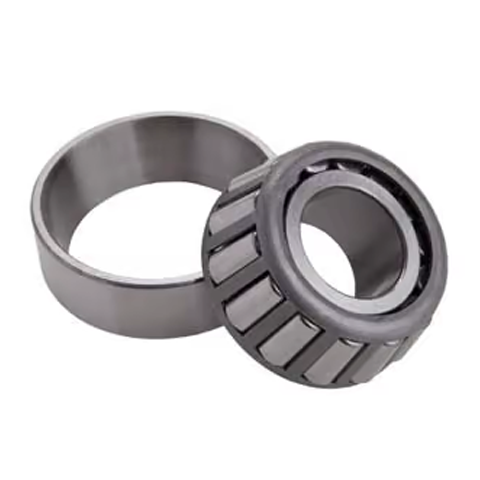
NTN NTN 32214U Single Row Tapered Roller Bearing, D=70mm
NTN 32214U Single Row Tapered Roller Bearing (Inside Dia - 70mm, Outside Dia - 125mm) SPECIFICATIONS Type of Product : Single Row Tapered Roller Bearing Inside Diameter (d) (mm) : 70 Outside Diameter D (mm) : 125 Width Dia mm : 31 Model No : 32214U 1. Types, design features, and characteristics Tapered roller bearings are designed so the tapered vertex of the raceway surfaces of the inner and outer rings and rollers converge at one point on the centerline of the bearing (see Fig. 1).The tapered rollers are guided by the compound force of the inner and outer raceway surfaces which keep the rollers pressed up against the large rib on the inner ring.A large variety of these bearings, including single, double, and four row arrangements, are available in both metric and inch series. Each type and associated characteristics are shown in Table 1. For four-row tapered roller bearings, see section “C. Special application bearings.” Table 1 Tapered roller bearing types and characteristics Type Characteristics Single row taperedroller bearings (1) There are both metric and inch series adhering to the standards shown in the following table. Dimension series *Dimension series previously not covered by 3XX are regulated under JIS B 1512; dimensions previously missing from 3XX will henceforth use the bearing number. (2) In addition to the standard design, there are also medium contact angle and large contact angle types, denoted by the contact angle codes at the end of the part numbers (C and D, respectively). (3) Subunits Tapered roller bearings can be disassembled into parts: the inner ring, rollers, and cage (collectively known as the “CONE”) and the outer ring (known as the “CUP”). These are the bearing’s “subunits”. Subunit dimensions are standardized under ISO or ABMA standards, and unified subunits are interchangeable within each dimensional standard. However, high precision grade bearings are generally not interchangeable, and these subunits must be used by assembling only subunits with identical manufacturing numbers.Aside from any cautionary notes that may appear, the single row tapered roller bearings listed in the dimension tables have subunits standardized for both metric and inch systems (including J series). (Refer to Fig. 2) Single row taperedroller bearings (4) These bearings are constructed to have a high capacity for radial loads, axial loads, and combined loads. The larger the contact angle, the greater the axial load capacity. When a pure radial load is applied to a tapered roller bearing, an induced load in the axial direction is also generated, so these bearings are generally used in pairs.(5) Single row tapered roller bearings are separable, so both the inner and outer rings can be used with tight fits. (6) Tapered roller bearings are also manufactured with flanges attached to the outer rings. For more details, contact NTN Engineering. (Refer to Fig. 3) Duplex tapered roller bearings (1) When two single-row tapered roller bearings are to be used in combination, the bearing clearance and preload are adjusted by the inner ring spacer or the outer ring spacer (see Fig. 4).(2) A product number and a combination code are indicated on inner rings, outer rings, and spacers. Parts displaying the same number and code must be used in combination.(3) See A-96 Table 8.14 for the axial internal clearance. Double row taperedroller bearings (1) Back-to-back arrangement (using double row outer rings) and face-to-face arrangement (using double row inner rings) are both available. The assemblies have been adjusted so that each type's internal clearance values are fixed. Only parts with identical manufacturing numbers can be used and they must be assembled according to their code numbers. (Refer to Fig. 5)(2) See A-96 Table 8.14 for the axial internal clearance of double-row and duplex bearings. 2. Standard cage type In general, pressed cages (see Fig. 6) are used in tapered roller bearings. For large sized bearings, machined or pin type cages may also be used, while resin cages may also be used for smaller sized bearings. 3. Allowable misalignment In order to avoid edge loading and potential for premature failure, the maximum allowable misalignment based on bearing series can be found below.The allowable misalignment of combined bearings is influenced by the load center position, so please consult NTN Engineering.• Single row (standard) …………… 1/ 2 000• Single row (ULTAGE) …………… 1/ 600 4. Precautions If bearing load is light during operation, or if the ratio of axial to radial load for duplex and double row bearings exceeds the value of e, slipping may develop between the rollers and raceway surface, sometimes resulting in smearing. The mass of rollers and cages particularly tends to be large for large tapered roller bearings. For additional details, please contact NTN Engineering.In tapered roller bearings, the cage may protrude beyond the inner and/or outer ring side faces. Care should be taken when designing the housing and shaft to ensure contact with the cage does not occur.
$46.78
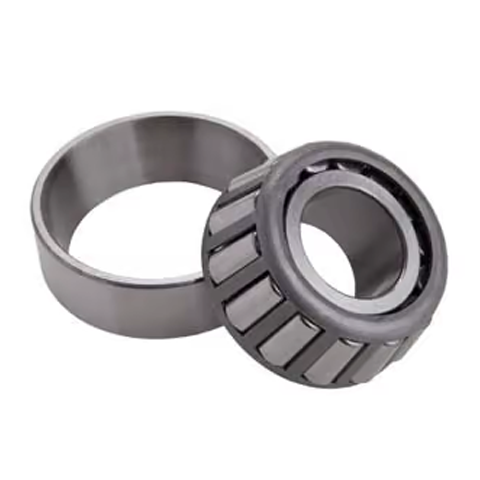
NTN NTN 4T-32306 Single Row Tapered Roller Bearing, D=30mm
NTN 4T-32306 Single Row Tapered Roller Bearing (Inside Dia - 30mm, Outside Dia - 72mm) SPECIFICATIONS Type of Product : Single Row Tapered Roller Bearing Inside Diameter (d) (mm) : 30 Outside Diameter D (mm) : 72 Width Dia mm : 27 Model No : 4T-32306 1. Types, design features, and characteristics Tapered roller bearings are designed so the tapered vertex of the raceway surfaces of the inner and outer rings and rollers converge at one point on the centerline of the bearing (see Fig. 1).The tapered rollers are guided by the compound force of the inner and outer raceway surfaces which keep the rollers pressed up against the large rib on the inner ring.A large variety of these bearings, including single, double, and four row arrangements, are available in both metric and inch series. Each type and associated characteristics are shown in Table 1. For four-row tapered roller bearings, see section “C. Special application bearings.” Table 1 Tapered roller bearing types and characteristics Type Characteristics Single row taperedroller bearings (1) There are both metric and inch series adhering to the standards shown in the following table. Dimension series *Dimension series previously not covered by 3XX are regulated under JIS B 1512; dimensions previously missing from 3XX will henceforth use the bearing number. (2) In addition to the standard design, there are also medium contact angle and large contact angle types, denoted by the contact angle codes at the end of the part numbers (C and D, respectively). (3) Subunits Tapered roller bearings can be disassembled into parts: the inner ring, rollers, and cage (collectively known as the “CONE”) and the outer ring (known as the “CUP”). These are the bearing’s “subunits”. Subunit dimensions are standardized under ISO or ABMA standards, and unified subunits are interchangeable within each dimensional standard. However, high precision grade bearings are generally not interchangeable, and these subunits must be used by assembling only subunits with identical manufacturing numbers.Aside from any cautionary notes that may appear, the single row tapered roller bearings listed in the dimension tables have subunits standardized for both metric and inch systems (including J series). (Refer to Fig. 2) Single row taperedroller bearings (4) These bearings are constructed to have a high capacity for radial loads, axial loads, and combined loads. The larger the contact angle, the greater the axial load capacity. When a pure radial load is applied to a tapered roller bearing, an induced load in the axial direction is also generated, so these bearings are generally used in pairs.(5) Single row tapered roller bearings are separable, so both the inner and outer rings can be used with tight fits. (6) Tapered roller bearings are also manufactured with flanges attached to the outer rings. For more details, contact NTN Engineering. (Refer to Fig. 3) Duplex tapered roller bearings (1) When two single-row tapered roller bearings are to be used in combination, the bearing clearance and preload are adjusted by the inner ring spacer or the outer ring spacer (see Fig. 4).(2) A product number and a combination code are indicated on inner rings, outer rings, and spacers. Parts displaying the same number and code must be used in combination.(3) See A-96 Table 8.14 for the axial internal clearance. Double row taperedroller bearings (1) Back-to-back arrangement (using double row outer rings) and face-to-face arrangement (using double row inner rings) are both available. The assemblies have been adjusted so that each type's internal clearance values are fixed. Only parts with identical manufacturing numbers can be used and they must be assembled according to their code numbers. (Refer to Fig. 5)(2) See A-96 Table 8.14 for the axial internal clearance of double-row and duplex bearings. 2. Standard cage type In general, pressed cages (see Fig. 6) are used in tapered roller bearings. For large sized bearings, machined or pin type cages may also be used, while resin cages may also be used for smaller sized bearings. 3. Allowable misalignment In order to avoid edge loading and potential for premature failure, the maximum allowable misalignment based on bearing series can be found below.The allowable misalignment of combined bearings is influenced by the load center position, so please consult NTN Engineering.• Single row (standard) …………… 1/ 2 000• Single row (ULTAGE) …………… 1/ 600 4. Precautions If bearing load is light during operation, or if the ratio of axial to radial load for duplex and double row bearings exceeds the value of e, slipping may develop between the rollers and raceway surface, sometimes resulting in smearing. The mass of rollers and cages particularly tends to be large for large tapered roller bearings. For additional details, please contact NTN Engineering.In tapered roller bearings, the cage may protrude beyond the inner and/or outer ring side faces. Care should be taken when designing the housing and shaft to ensure contact with the cage does not occur.
$20.80
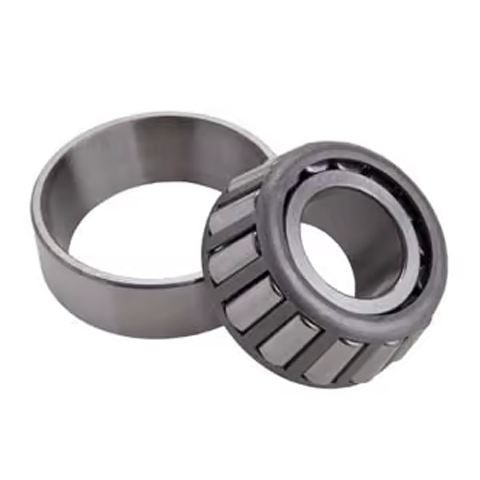
NTN NTN 4T-32305 Single Row Tapered Roller Bearing, D=25mm
NTN 4T-32305 Single Row Tapered Roller Bearing (Inside Dia - 25mm, Outside Dia - 62mm) SPECIFICATIONS Type of Product : Single Row Tapered Roller Bearing Inside Diameter (d) (mm) : 25 Outside Diameter D (mm) : 62 Width Dia mm : 24 Model No : 4T-32305 1. Types, design features, and characteristics Tapered roller bearings are designed so the tapered vertex of the raceway surfaces of the inner and outer rings and rollers converge at one point on the centerline of the bearing (see Fig. 1).The tapered rollers are guided by the compound force of the inner and outer raceway surfaces which keep the rollers pressed up against the large rib on the inner ring.A large variety of these bearings, including single, double, and four row arrangements, are available in both metric and inch series. Each type and associated characteristics are shown in Table 1. For four-row tapered roller bearings, see section “C. Special application bearings.” Table 1 Tapered roller bearing types and characteristics Type Characteristics Single row taperedroller bearings (1) There are both metric and inch series adhering to the standards shown in the following table. Dimension series *Dimension series previously not covered by 3XX are regulated under JIS B 1512; dimensions previously missing from 3XX will henceforth use the bearing number. (2) In addition to the standard design, there are also medium contact angle and large contact angle types, denoted by the contact angle codes at the end of the part numbers (C and D, respectively). (3) Subunits Tapered roller bearings can be disassembled into parts: the inner ring, rollers, and cage (collectively known as the “CONE”) and the outer ring (known as the “CUP”). These are the bearing’s “subunits”. Subunit dimensions are standardized under ISO or ABMA standards, and unified subunits are interchangeable within each dimensional standard. However, high precision grade bearings are generally not interchangeable, and these subunits must be used by assembling only subunits with identical manufacturing numbers.Aside from any cautionary notes that may appear, the single row tapered roller bearings listed in the dimension tables have subunits standardized for both metric and inch systems (including J series). (Refer to Fig. 2) Single row taperedroller bearings (4) These bearings are constructed to have a high capacity for radial loads, axial loads, and combined loads. The larger the contact angle, the greater the axial load capacity. When a pure radial load is applied to a tapered roller bearing, an induced load in the axial direction is also generated, so these bearings are generally used in pairs.(5) Single row tapered roller bearings are separable, so both the inner and outer rings can be used with tight fits. (6) Tapered roller bearings are also manufactured with flanges attached to the outer rings. For more details, contact NTN Engineering. (Refer to Fig. 3) Duplex tapered roller bearings (1) When two single-row tapered roller bearings are to be used in combination, the bearing clearance and preload are adjusted by the inner ring spacer or the outer ring spacer (see Fig. 4).(2) A product number and a combination code are indicated on inner rings, outer rings, and spacers. Parts displaying the same number and code must be used in combination.(3) See A-96 Table 8.14 for the axial internal clearance. Double row taperedroller bearings (1) Back-to-back arrangement (using double row outer rings) and face-to-face arrangement (using double row inner rings) are both available. The assemblies have been adjusted so that each type's internal clearance values are fixed. Only parts with identical manufacturing numbers can be used and they must be assembled according to their code numbers. (Refer to Fig. 5)(2) See A-96 Table 8.14 for the axial internal clearance of double-row and duplex bearings. 2. Standard cage type In general, pressed cages (see Fig. 6) are used in tapered roller bearings. For large sized bearings, machined or pin type cages may also be used, while resin cages may also be used for smaller sized bearings. 3. Allowable misalignment In order to avoid edge loading and potential for premature failure, the maximum allowable misalignment based on bearing series can be found below.The allowable misalignment of combined bearings is influenced by the load center position, so please consult NTN Engineering.• Single row (standard) …………… 1/ 2 000• Single row (ULTAGE) …………… 1/ 600 4. Precautions If bearing load is light during operation, or if the ratio of axial to radial load for duplex and double row bearings exceeds the value of e, slipping may develop between the rollers and raceway surface, sometimes resulting in smearing. The mass of rollers and cages particularly tends to be large for large tapered roller bearings. For additional details, please contact NTN Engineering.In tapered roller bearings, the cage may protrude beyond the inner and/or outer ring side faces. Care should be taken when designing the housing and shaft to ensure contact with the cage does not occur.
$17.44
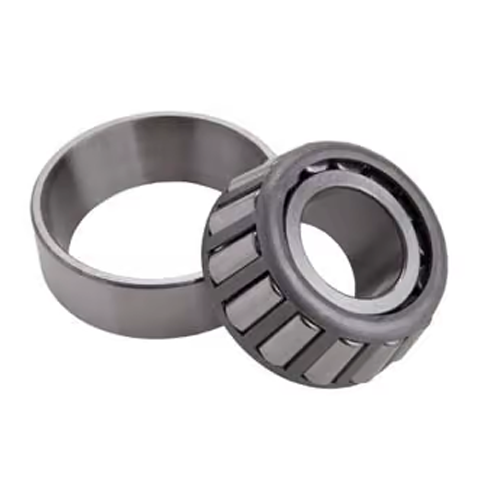
NTN NTN 4T-32304 Single Row Tapered Roller Bearing, D=20mm
NTN 4T-32304 Single Row Tapered Roller Bearing (Inside Dia - 20mm, Outside Dia - 52mm) SPECIFICATIONS Type of Product : Single Row Tapered Roller Bearing Inside Diameter (d) (mm) : 20 Outside Diameter D (mm) : 52 Width Dia mm : 21 Model No : 4T-32304 1. Types, design features, and characteristics Tapered roller bearings are designed so the tapered vertex of the raceway surfaces of the inner and outer rings and rollers converge at one point on the centerline of the bearing (see Fig. 1).The tapered rollers are guided by the compound force of the inner and outer raceway surfaces which keep the rollers pressed up against the large rib on the inner ring.A large variety of these bearings, including single, double, and four row arrangements, are available in both metric and inch series. Each type and associated characteristics are shown in Table 1. For four-row tapered roller bearings, see section “C. Special application bearings.” Table 1 Tapered roller bearing types and characteristics Type Characteristics Single row taperedroller bearings (1) There are both metric and inch series adhering to the standards shown in the following table. Dimension series *Dimension series previously not covered by 3XX are regulated under JIS B 1512; dimensions previously missing from 3XX will henceforth use the bearing number. (2) In addition to the standard design, there are also medium contact angle and large contact angle types, denoted by the contact angle codes at the end of the part numbers (C and D, respectively). (3) Subunits Tapered roller bearings can be disassembled into parts: the inner ring, rollers, and cage (collectively known as the “CONE”) and the outer ring (known as the “CUP”). These are the bearing’s “subunits”. Subunit dimensions are standardized under ISO or ABMA standards, and unified subunits are interchangeable within each dimensional standard. However, high precision grade bearings are generally not interchangeable, and these subunits must be used by assembling only subunits with identical manufacturing numbers.Aside from any cautionary notes that may appear, the single row tapered roller bearings listed in the dimension tables have subunits standardized for both metric and inch systems (including J series). (Refer to Fig. 2) Single row taperedroller bearings (4) These bearings are constructed to have a high capacity for radial loads, axial loads, and combined loads. The larger the contact angle, the greater the axial load capacity. When a pure radial load is applied to a tapered roller bearing, an induced load in the axial direction is also generated, so these bearings are generally used in pairs.(5) Single row tapered roller bearings are separable, so both the inner and outer rings can be used with tight fits. (6) Tapered roller bearings are also manufactured with flanges attached to the outer rings. For more details, contact NTN Engineering. (Refer to Fig. 3) Duplex tapered roller bearings (1) When two single-row tapered roller bearings are to be used in combination, the bearing clearance and preload are adjusted by the inner ring spacer or the outer ring spacer (see Fig. 4).(2) A product number and a combination code are indicated on inner rings, outer rings, and spacers. Parts displaying the same number and code must be used in combination.(3) See A-96 Table 8.14 for the axial internal clearance. Double row taperedroller bearings (1) Back-to-back arrangement (using double row outer rings) and face-to-face arrangement (using double row inner rings) are both available. The assemblies have been adjusted so that each type's internal clearance values are fixed. Only parts with identical manufacturing numbers can be used and they must be assembled according to their code numbers. (Refer to Fig. 5)(2) See A-96 Table 8.14 for the axial internal clearance of double-row and duplex bearings. 2. Standard cage type In general, pressed cages (see Fig. 6) are used in tapered roller bearings. For large sized bearings, machined or pin type cages may also be used, while resin cages may also be used for smaller sized bearings. 3. Allowable misalignment In order to avoid edge loading and potential for premature failure, the maximum allowable misalignment based on bearing series can be found below.The allowable misalignment of combined bearings is influenced by the load center position, so please consult NTN Engineering.• Single row (standard) …………… 1/ 2 000• Single row (ULTAGE) …………… 1/ 600 4. Precautions If bearing load is light during operation, or if the ratio of axial to radial load for duplex and double row bearings exceeds the value of e, slipping may develop between the rollers and raceway surface, sometimes resulting in smearing. The mass of rollers and cages particularly tends to be large for large tapered roller bearings. For additional details, please contact NTN Engineering.In tapered roller bearings, the cage may protrude beyond the inner and/or outer ring side faces. Care should be taken when designing the housing and shaft to ensure contact with the cage does not occur.
$15.66
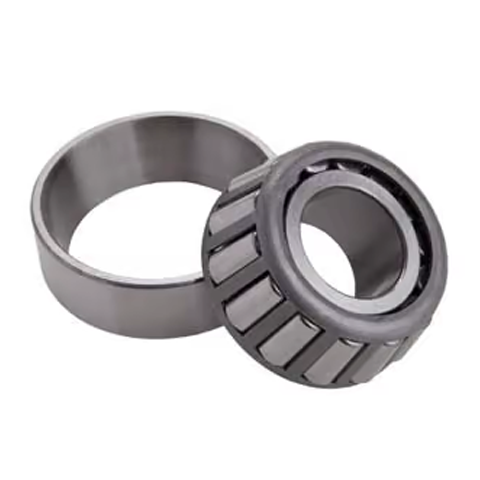
NTN NTN 4T-32211 Single Row Tapered Roller Bearing, D=55mm
NTN 4T-32211 Single Row Tapered Roller Bearing (Inside Dia - 55mm, Outside Dia - 100mm) SPECIFICATIONS Type of Product : Single Row Tapered Roller Bearing Inside Diameter (d) (mm) : 55 Outside Diameter D (mm) : 100 Width Dia mm : 27.06 Model No : 4T-32211 1. Types, design features, and characteristics Tapered roller bearings are designed so the tapered vertex of the raceway surfaces of the inner and outer rings and rollers converge at one point on the centerline of the bearing (see Fig. 1).The tapered rollers are guided by the compound force of the inner and outer raceway surfaces which keep the rollers pressed up against the large rib on the inner ring.A large variety of these bearings, including single, double, and four row arrangements, are available in both metric and inch series. Each type and associated characteristics are shown in Table 1. For four-row tapered roller bearings, see section “C. Special application bearings.” Table 1 Tapered roller bearing types and characteristics Type Characteristics Single row taperedroller bearings (1) There are both metric and inch series adhering to the standards shown in the following table. Dimension series *Dimension series previously not covered by 3XX are regulated under JIS B 1512; dimensions previously missing from 3XX will henceforth use the bearing number. (2) In addition to the standard design, there are also medium contact angle and large contact angle types, denoted by the contact angle codes at the end of the part numbers (C and D, respectively). (3) Subunits Tapered roller bearings can be disassembled into parts: the inner ring, rollers, and cage (collectively known as the “CONE”) and the outer ring (known as the “CUP”). These are the bearing’s “subunits”. Subunit dimensions are standardized under ISO or ABMA standards, and unified subunits are interchangeable within each dimensional standard. However, high precision grade bearings are generally not interchangeable, and these subunits must be used by assembling only subunits with identical manufacturing numbers.Aside from any cautionary notes that may appear, the single row tapered roller bearings listed in the dimension tables have subunits standardized for both metric and inch systems (including J series). (Refer to Fig. 2) Single row taperedroller bearings (4) These bearings are constructed to have a high capacity for radial loads, axial loads, and combined loads. The larger the contact angle, the greater the axial load capacity. When a pure radial load is applied to a tapered roller bearing, an induced load in the axial direction is also generated, so these bearings are generally used in pairs.(5) Single row tapered roller bearings are separable, so both the inner and outer rings can be used with tight fits. (6) Tapered roller bearings are also manufactured with flanges attached to the outer rings. For more details, contact NTN Engineering. (Refer to Fig. 3) Duplex tapered roller bearings (1) When two single-row tapered roller bearings are to be used in combination, the bearing clearance and preload are adjusted by the inner ring spacer or the outer ring spacer (see Fig. 4).(2) A product number and a combination code are indicated on inner rings, outer rings, and spacers. Parts displaying the same number and code must be used in combination.(3) See A-96 Table 8.14 for the axial internal clearance. Double row taperedroller bearings (1) Back-to-back arrangement (using double row outer rings) and face-to-face arrangement (using double row inner rings) are both available. The assemblies have been adjusted so that each type's internal clearance values are fixed. Only parts with identical manufacturing numbers can be used and they must be assembled according to their code numbers. (Refer to Fig. 5)(2) See A-96 Table 8.14 for the axial internal clearance of double-row and duplex bearings. 2. Standard cage type In general, pressed cages (see Fig. 6) are used in tapered roller bearings. For large sized bearings, machined or pin type cages may also be used, while resin cages may also be used for smaller sized bearings. 3. Allowable misalignment In order to avoid edge loading and potential for premature failure, the maximum allowable misalignment based on bearing series can be found below.The allowable misalignment of combined bearings is influenced by the load center position, so please consult NTN Engineering.• Single row (standard) …………… 1/ 2 000• Single row (ULTAGE) …………… 1/ 600 4. Precautions If bearing load is light during operation, or if the ratio of axial to radial load for duplex and double row bearings exceeds the value of e, slipping may develop between the rollers and raceway surface, sometimes resulting in smearing. The mass of rollers and cages particularly tends to be large for large tapered roller bearings. For additional details, please contact NTN Engineering.In tapered roller bearings, the cage may protrude beyond the inner and/or outer ring side faces. Care should be taken when designing the housing and shaft to ensure contact with the cage does not occur.
$26.76
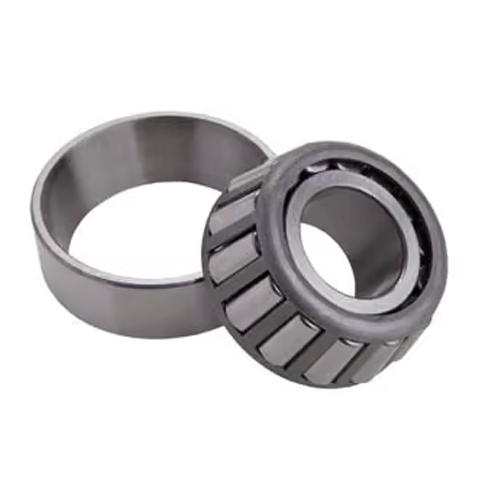
NTN NTN 4T-32209 Single Row Tapered Roller Bearing, D=45mm
NTN 4T-32209 Single Row Tapered Roller Bearing (Inside Dia - 45mm, Outside Dia - 85mm) SPECIFICATIONS Type of Product : Single Row Tapered Roller Bearing Inside Diameter (d) (mm) : 45 Outside Diameter D (mm) : 85 Width Dia mm : 23 Model No : 4T-32209 1. Types, design features, and characteristics Tapered roller bearings are designed so the tapered vertex of the raceway surfaces of the inner and outer rings and rollers converge at one point on the centerline of the bearing (see Fig. 1).The tapered rollers are guided by the compound force of the inner and outer raceway surfaces which keep the rollers pressed up against the large rib on the inner ring.A large variety of these bearings, including single, double, and four row arrangements, are available in both metric and inch series. Each type and associated characteristics are shown in Table 1. For four-row tapered roller bearings, see section “C. Special application bearings.” Table 1 Tapered roller bearing types and characteristics Type Characteristics Single row taperedroller bearings (1) There are both metric and inch series adhering to the standards shown in the following table. Dimension series *Dimension series previously not covered by 3XX are regulated under JIS B 1512; dimensions previously missing from 3XX will henceforth use the bearing number. (2) In addition to the standard design, there are also medium contact angle and large contact angle types, denoted by the contact angle codes at the end of the part numbers (C and D, respectively). (3) Subunits Tapered roller bearings can be disassembled into parts: the inner ring, rollers, and cage (collectively known as the “CONE”) and the outer ring (known as the “CUP”). These are the bearing’s “subunits”. Subunit dimensions are standardized under ISO or ABMA standards, and unified subunits are interchangeable within each dimensional standard. However, high precision grade bearings are generally not interchangeable, and these subunits must be used by assembling only subunits with identical manufacturing numbers.Aside from any cautionary notes that may appear, the single row tapered roller bearings listed in the dimension tables have subunits standardized for both metric and inch systems (including J series). (Refer to Fig. 2) Single row taperedroller bearings (4) These bearings are constructed to have a high capacity for radial loads, axial loads, and combined loads. The larger the contact angle, the greater the axial load capacity. When a pure radial load is applied to a tapered roller bearing, an induced load in the axial direction is also generated, so these bearings are generally used in pairs.(5) Single row tapered roller bearings are separable, so both the inner and outer rings can be used with tight fits. (6) Tapered roller bearings are also manufactured with flanges attached to the outer rings. For more details, contact NTN Engineering. (Refer to Fig. 3) Duplex tapered roller bearings (1) When two single-row tapered roller bearings are to be used in combination, the bearing clearance and preload are adjusted by the inner ring spacer or the outer ring spacer (see Fig. 4).(2) A product number and a combination code are indicated on inner rings, outer rings, and spacers. Parts displaying the same number and code must be used in combination.(3) See A-96 Table 8.14 for the axial internal clearance. Double row taperedroller bearings (1) Back-to-back arrangement (using double row outer rings) and face-to-face arrangement (using double row inner rings) are both available. The assemblies have been adjusted so that each type's internal clearance values are fixed. Only parts with identical manufacturing numbers can be used and they must be assembled according to their code numbers. (Refer to Fig. 5)(2) See A-96 Table 8.14 for the axial internal clearance of double-row and duplex bearings. 2. Standard cage type In general, pressed cages (see Fig. 6) are used in tapered roller bearings. For large sized bearings, machined or pin type cages may also be used, while resin cages may also be used for smaller sized bearings. 3. Allowable misalignment In order to avoid edge loading and potential for premature failure, the maximum allowable misalignment based on bearing series can be found below.The allowable misalignment of combined bearings is influenced by the load center position, so please consult NTN Engineering.• Single row (standard) …………… 1/ 2 000• Single row (ULTAGE) …………… 1/ 600 4. Precautions If bearing load is light during operation, or if the ratio of axial to radial load for duplex and double row bearings exceeds the value of e, slipping may develop between the rollers and raceway surface, sometimes resulting in smearing. The mass of rollers and cages particularly tends to be large for large tapered roller bearings. For additional details, please contact NTN Engineering.In tapered roller bearings, the cage may protrude beyond the inner and/or outer ring side faces. Care should be taken when designing the housing and shaft to ensure contact with the cage does not occur.
$18.76
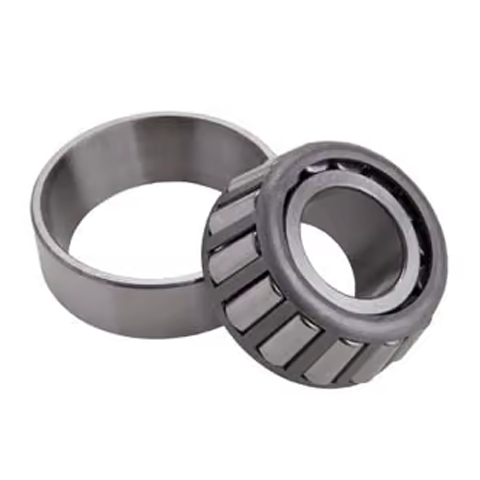
NTN NTN 4T-32208 Single Row Tapered Roller Bearing, D=40mm
NTN 4T-32208 Single Row Tapered Roller Bearing (Inside Dia - 40mm, Outside Dia - 80mm) SPECIFICATIONS Type of Product : Single Row Tapered Roller Bearing Inside Diameter (d) (mm) : 40 Outside Diameter D (mm) : 80 Width Dia mm : 23 Model No : 4T-32208 1. Types, design features, and characteristics Tapered roller bearings are designed so the tapered vertex of the raceway surfaces of the inner and outer rings and rollers converge at one point on the centerline of the bearing (see Fig. 1).The tapered rollers are guided by the compound force of the inner and outer raceway surfaces which keep the rollers pressed up against the large rib on the inner ring.A large variety of these bearings, including single, double, and four row arrangements, are available in both metric and inch series. Each type and associated characteristics are shown in Table 1. For four-row tapered roller bearings, see section “C. Special application bearings.” Table 1 Tapered roller bearing types and characteristics Type Characteristics Single row taperedroller bearings (1) There are both metric and inch series adhering to the standards shown in the following table. Dimension series *Dimension series previously not covered by 3XX are regulated under JIS B 1512; dimensions previously missing from 3XX will henceforth use the bearing number. (2) In addition to the standard design, there are also medium contact angle and large contact angle types, denoted by the contact angle codes at the end of the part numbers (C and D, respectively). (3) Subunits Tapered roller bearings can be disassembled into parts: the inner ring, rollers, and cage (collectively known as the “CONE”) and the outer ring (known as the “CUP”). These are the bearing’s “subunits”. Subunit dimensions are standardized under ISO or ABMA standards, and unified subunits are interchangeable within each dimensional standard. However, high precision grade bearings are generally not interchangeable, and these subunits must be used by assembling only subunits with identical manufacturing numbers.Aside from any cautionary notes that may appear, the single row tapered roller bearings listed in the dimension tables have subunits standardized for both metric and inch systems (including J series). (Refer to Fig. 2) Single row taperedroller bearings (4) These bearings are constructed to have a high capacity for radial loads, axial loads, and combined loads. The larger the contact angle, the greater the axial load capacity. When a pure radial load is applied to a tapered roller bearing, an induced load in the axial direction is also generated, so these bearings are generally used in pairs.(5) Single row tapered roller bearings are separable, so both the inner and outer rings can be used with tight fits. (6) Tapered roller bearings are also manufactured with flanges attached to the outer rings. For more details, contact NTN Engineering. (Refer to Fig. 3) Duplex tapered roller bearings (1) When two single-row tapered roller bearings are to be used in combination, the bearing clearance and preload are adjusted by the inner ring spacer or the outer ring spacer (see Fig. 4).(2) A product number and a combination code are indicated on inner rings, outer rings, and spacers. Parts displaying the same number and code must be used in combination.(3) See A-96 Table 8.14 for the axial internal clearance. Double row taperedroller bearings (1) Back-to-back arrangement (using double row outer rings) and face-to-face arrangement (using double row inner rings) are both available. The assemblies have been adjusted so that each type's internal clearance values are fixed. Only parts with identical manufacturing numbers can be used and they must be assembled according to their code numbers. (Refer to Fig. 5)(2) See A-96 Table 8.14 for the axial internal clearance of double-row and duplex bearings. 2. Standard cage type In general, pressed cages (see Fig. 6) are used in tapered roller bearings. For large sized bearings, machined or pin type cages may also be used, while resin cages may also be used for smaller sized bearings. 3. Allowable misalignment In order to avoid edge loading and potential for premature failure, the maximum allowable misalignment based on bearing series can be found below.The allowable misalignment of combined bearings is influenced by the load center position, so please consult NTN Engineering.• Single row (standard) …………… 1/ 2 000• Single row (ULTAGE) …………… 1/ 600 4. Precautions If bearing load is light during operation, or if the ratio of axial to radial load for duplex and double row bearings exceeds the value of e, slipping may develop between the rollers and raceway surface, sometimes resulting in smearing. The mass of rollers and cages particularly tends to be large for large tapered roller bearings. For additional details, please contact NTN Engineering.In tapered roller bearings, the cage may protrude beyond the inner and/or outer ring side faces. Care should be taken when designing the housing and shaft to ensure contact with the cage does not occur.
$16.76
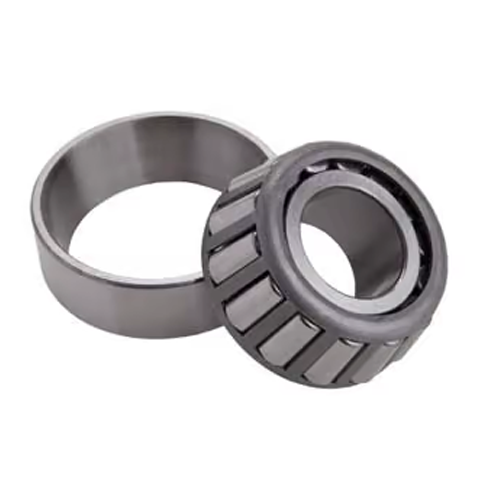
NTN NTN 4T-32207 Single Row Tapered Roller Bearing, D=35mm
NTN 4T-32207 Single Row Tapered Roller Bearing (Inside Dia - 35mm, Outside Dia - 72mm) SPECIFICATIONS Type of Product : Single Row Tapered Roller Bearing Inside Diameter (d) (mm) : 35 Outside Diameter D (mm) : 72 Width Dia mm : 23 Model No : 4T-32207 1. Types, design features, and characteristics Tapered roller bearings are designed so the tapered vertex of the raceway surfaces of the inner and outer rings and rollers converge at one point on the centerline of the bearing (see Fig. 1).The tapered rollers are guided by the compound force of the inner and outer raceway surfaces which keep the rollers pressed up against the large rib on the inner ring.A large variety of these bearings, including single, double, and four row arrangements, are available in both metric and inch series. Each type and associated characteristics are shown in Table 1. For four-row tapered roller bearings, see section “C. Special application bearings.” Table 1 Tapered roller bearing types and characteristics Type Characteristics Single row taperedroller bearings (1) There are both metric and inch series adhering to the standards shown in the following table. Dimension series *Dimension series previously not covered by 3XX are regulated under JIS B 1512; dimensions previously missing from 3XX will henceforth use the bearing number. (2) In addition to the standard design, there are also medium contact angle and large contact angle types, denoted by the contact angle codes at the end of the part numbers (C and D, respectively). (3) Subunits Tapered roller bearings can be disassembled into parts: the inner ring, rollers, and cage (collectively known as the “CONE”) and the outer ring (known as the “CUP”). These are the bearing’s “subunits”. Subunit dimensions are standardized under ISO or ABMA standards, and unified subunits are interchangeable within each dimensional standard. However, high precision grade bearings are generally not interchangeable, and these subunits must be used by assembling only subunits with identical manufacturing numbers.Aside from any cautionary notes that may appear, the single row tapered roller bearings listed in the dimension tables have subunits standardized for both metric and inch systems (including J series). (Refer to Fig. 2) Single row taperedroller bearings (4) These bearings are constructed to have a high capacity for radial loads, axial loads, and combined loads. The larger the contact angle, the greater the axial load capacity. When a pure radial load is applied to a tapered roller bearing, an induced load in the axial direction is also generated, so these bearings are generally used in pairs.(5) Single row tapered roller bearings are separable, so both the inner and outer rings can be used with tight fits. (6) Tapered roller bearings are also manufactured with flanges attached to the outer rings. For more details, contact NTN Engineering. (Refer to Fig. 3) Duplex tapered roller bearings (1) When two single-row tapered roller bearings are to be used in combination, the bearing clearance and preload are adjusted by the inner ring spacer or the outer ring spacer (see Fig. 4).(2) A product number and a combination code are indicated on inner rings, outer rings, and spacers. Parts displaying the same number and code must be used in combination.(3) See A-96 Table 8.14 for the axial internal clearance. Double row taperedroller bearings (1) Back-to-back arrangement (using double row outer rings) and face-to-face arrangement (using double row inner rings) are both available. The assemblies have been adjusted so that each type's internal clearance values are fixed. Only parts with identical manufacturing numbers can be used and they must be assembled according to their code numbers. (Refer to Fig. 5)(2) See A-96 Table 8.14 for the axial internal clearance of double-row and duplex bearings. 2. Standard cage type In general, pressed cages (see Fig. 6) are used in tapered roller bearings. For large sized bearings, machined or pin type cages may also be used, while resin cages may also be used for smaller sized bearings. 3. Allowable misalignment In order to avoid edge loading and potential for premature failure, the maximum allowable misalignment based on bearing series can be found below.The allowable misalignment of combined bearings is influenced by the load center position, so please consult NTN Engineering.• Single row (standard) …………… 1/ 2 000• Single row (ULTAGE) …………… 1/ 600 4. Precautions If bearing load is light during operation, or if the ratio of axial to radial load for duplex and double row bearings exceeds the value of e, slipping may develop between the rollers and raceway surface, sometimes resulting in smearing. The mass of rollers and cages particularly tends to be large for large tapered roller bearings. For additional details, please contact NTN Engineering.In tapered roller bearings, the cage may protrude beyond the inner and/or outer ring side faces. Care should be taken when designing the housing and shaft to ensure contact with the cage does not occur.
$15.84
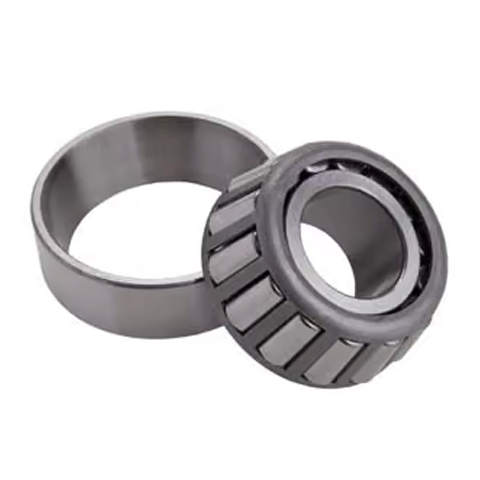
NTN NTN 4T-32205 Single Row Tapered Roller Bearing, D=25mm
NTN 4T-32205 Single Row Tapered Roller Bearing (Inside Dia - 25mm, Outside Dia - 52mm) SPECIFICATIONS Type of Product : Single Row Tapered Roller Bearing Inside Diameter (d) (mm) : 25 Outside Diameter D (mm) : 52 Width Dia mm : 18 Model No : 4T-32205 1. Types, design features, and characteristics Tapered roller bearings are designed so the tapered vertex of the raceway surfaces of the inner and outer rings and rollers converge at one point on the centerline of the bearing (see Fig. 1).The tapered rollers are guided by the compound force of the inner and outer raceway surfaces which keep the rollers pressed up against the large rib on the inner ring.A large variety of these bearings, including single, double, and four row arrangements, are available in both metric and inch series. Each type and associated characteristics are shown in Table 1. For four-row tapered roller bearings, see section “C. Special application bearings.” Table 1 Tapered roller bearing types and characteristics Type Characteristics Single row taperedroller bearings (1) There are both metric and inch series adhering to the standards shown in the following table. Dimension series *Dimension series previously not covered by 3XX are regulated under JIS B 1512; dimensions previously missing from 3XX will henceforth use the bearing number. (2) In addition to the standard design, there are also medium contact angle and large contact angle types, denoted by the contact angle codes at the end of the part numbers (C and D, respectively). (3) Subunits Tapered roller bearings can be disassembled into parts: the inner ring, rollers, and cage (collectively known as the “CONE”) and the outer ring (known as the “CUP”). These are the bearing’s “subunits”. Subunit dimensions are standardized under ISO or ABMA standards, and unified subunits are interchangeable within each dimensional standard. However, high precision grade bearings are generally not interchangeable, and these subunits must be used by assembling only subunits with identical manufacturing numbers.Aside from any cautionary notes that may appear, the single row tapered roller bearings listed in the dimension tables have subunits standardized for both metric and inch systems (including J series). (Refer to Fig. 2) Single row taperedroller bearings (4) These bearings are constructed to have a high capacity for radial loads, axial loads, and combined loads. The larger the contact angle, the greater the axial load capacity. When a pure radial load is applied to a tapered roller bearing, an induced load in the axial direction is also generated, so these bearings are generally used in pairs.(5) Single row tapered roller bearings are separable, so both the inner and outer rings can be used with tight fits. (6) Tapered roller bearings are also manufactured with flanges attached to the outer rings. For more details, contact NTN Engineering. (Refer to Fig. 3) Duplex tapered roller bearings (1) When two single-row tapered roller bearings are to be used in combination, the bearing clearance and preload are adjusted by the inner ring spacer or the outer ring spacer (see Fig. 4).(2) A product number and a combination code are indicated on inner rings, outer rings, and spacers. Parts displaying the same number and code must be used in combination.(3) See A-96 Table 8.14 for the axial internal clearance. Double row taperedroller bearings (1) Back-to-back arrangement (using double row outer rings) and face-to-face arrangement (using double row inner rings) are both available. The assemblies have been adjusted so that each type's internal clearance values are fixed. Only parts with identical manufacturing numbers can be used and they must be assembled according to their code numbers. (Refer to Fig. 5)(2) See A-96 Table 8.14 for the axial internal clearance of double-row and duplex bearings. 2. Standard cage type In general, pressed cages (see Fig. 6) are used in tapered roller bearings. For large sized bearings, machined or pin type cages may also be used, while resin cages may also be used for smaller sized bearings. 3. Allowable misalignment In order to avoid edge loading and potential for premature failure, the maximum allowable misalignment based on bearing series can be found below.The allowable misalignment of combined bearings is influenced by the load center position, so please consult NTN Engineering.• Single row (standard) …………… 1/ 2 000• Single row (ULTAGE) …………… 1/ 600 4. Precautions If bearing load is light during operation, or if the ratio of axial to radial load for duplex and double row bearings exceeds the value of e, slipping may develop between the rollers and raceway surface, sometimes resulting in smearing. The mass of rollers and cages particularly tends to be large for large tapered roller bearings. For additional details, please contact NTN Engineering.In tapered roller bearings, the cage may protrude beyond the inner and/or outer ring side faces. Care should be taken when designing the housing and shaft to ensure contact with the cage does not occur.
$15.96
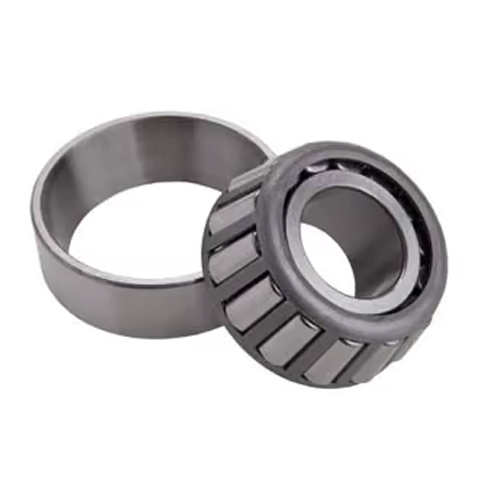
NTN NTN 4T-32204 Single Row Tapered Roller Bearing, D=20mm
NTN 4T-32204 Single Row Tapered Roller Bearing (Inside Dia - 20mm, Outside Dia - 47mm) SPECIFICATIONS Type of Product : Single Row Tapered Roller Bearing Inside Diameter (d) (mm) : 20 Outside Diameter D (mm) : 47 Width Dia mm : 18 Model No : 4T-32204 1. Types, design features, and characteristics Tapered roller bearings are designed so the tapered vertex of the raceway surfaces of the inner and outer rings and rollers converge at one point on the centerline of the bearing (see Fig. 1).The tapered rollers are guided by the compound force of the inner and outer raceway surfaces which keep the rollers pressed up against the large rib on the inner ring.A large variety of these bearings, including single, double, and four row arrangements, are available in both metric and inch series. Each type and associated characteristics are shown in Table 1. For four-row tapered roller bearings, see section “C. Special application bearings.” Table 1 Tapered roller bearing types and characteristics Type Characteristics Single row taperedroller bearings (1) There are both metric and inch series adhering to the standards shown in the following table. Dimension series *Dimension series previously not covered by 3XX are regulated under JIS B 1512; dimensions previously missing from 3XX will henceforth use the bearing number. (2) In addition to the standard design, there are also medium contact angle and large contact angle types, denoted by the contact angle codes at the end of the part numbers (C and D, respectively). (3) Subunits Tapered roller bearings can be disassembled into parts: the inner ring, rollers, and cage (collectively known as the “CONE”) and the outer ring (known as the “CUP”). These are the bearing’s “subunits”. Subunit dimensions are standardized under ISO or ABMA standards, and unified subunits are interchangeable within each dimensional standard. However, high precision grade bearings are generally not interchangeable, and these subunits must be used by assembling only subunits with identical manufacturing numbers.Aside from any cautionary notes that may appear, the single row tapered roller bearings listed in the dimension tables have subunits standardized for both metric and inch systems (including J series). (Refer to Fig. 2) Single row taperedroller bearings (4) These bearings are constructed to have a high capacity for radial loads, axial loads, and combined loads. The larger the contact angle, the greater the axial load capacity. When a pure radial load is applied to a tapered roller bearing, an induced load in the axial direction is also generated, so these bearings are generally used in pairs.(5) Single row tapered roller bearings are separable, so both the inner and outer rings can be used with tight fits. (6) Tapered roller bearings are also manufactured with flanges attached to the outer rings. For more details, contact NTN Engineering. (Refer to Fig. 3) Duplex tapered roller bearings (1) When two single-row tapered roller bearings are to be used in combination, the bearing clearance and preload are adjusted by the inner ring spacer or the outer ring spacer (see Fig. 4).(2) A product number and a combination code are indicated on inner rings, outer rings, and spacers. Parts displaying the same number and code must be used in combination.(3) See A-96 Table 8.14 for the axial internal clearance. Double row taperedroller bearings (1) Back-to-back arrangement (using double row outer rings) and face-to-face arrangement (using double row inner rings) are both available. The assemblies have been adjusted so that each type's internal clearance values are fixed. Only parts with identical manufacturing numbers can be used and they must be assembled according to their code numbers. (Refer to Fig. 5)(2) See A-96 Table 8.14 for the axial internal clearance of double-row and duplex bearings. 2. Standard cage type In general, pressed cages (see Fig. 6) are used in tapered roller bearings. For large sized bearings, machined or pin type cages may also be used, while resin cages may also be used for smaller sized bearings. 3. Allowable misalignment In order to avoid edge loading and potential for premature failure, the maximum allowable misalignment based on bearing series can be found below.The allowable misalignment of combined bearings is influenced by the load center position, so please consult NTN Engineering.• Single row (standard) …………… 1/ 2 000• Single row (ULTAGE) …………… 1/ 600 4. Precautions If bearing load is light during operation, or if the ratio of axial to radial load for duplex and double row bearings exceeds the value of e, slipping may develop between the rollers and raceway surface, sometimes resulting in smearing. The mass of rollers and cages particularly tends to be large for large tapered roller bearings. For additional details, please contact NTN Engineering.In tapered roller bearings, the cage may protrude beyond the inner and/or outer ring side faces. Care should be taken when designing the housing and shaft to ensure contact with the cage does not occur.
$6.72
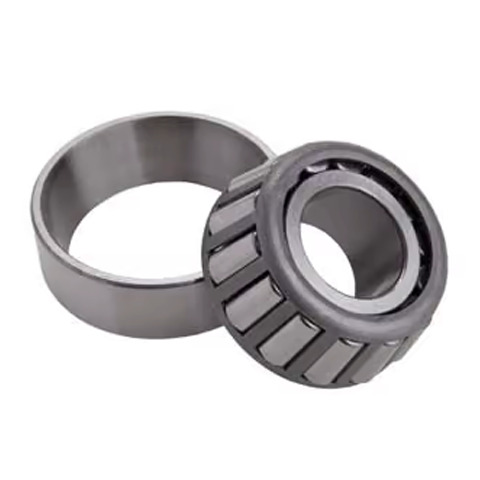
NTN NTN 4T-32011X Single Row Tapered Roller Bearing, D=55mm
NTN 4T-32011X Single Row Tapered Roller Bearing (Inside Dia - 55mm, Outside Dia - 90mm) SPECIFICATIONS Type of Product : Single Row Tapered Roller Bearing Inside Diameter (d) (mm) : 55 Outside Diameter D (mm) : 90 Width Dia mm : 23 Model No : 4T-32011X 1. Types, design features, and characteristics Tapered roller bearings are designed so the tapered vertex of the raceway surfaces of the inner and outer rings and rollers converge at one point on the centerline of the bearing (see Fig. 1).The tapered rollers are guided by the compound force of the inner and outer raceway surfaces which keep the rollers pressed up against the large rib on the inner ring.A large variety of these bearings, including single, double, and four row arrangements, are available in both metric and inch series. Each type and associated characteristics are shown in Table 1. For four-row tapered roller bearings, see section “C. Special application bearings.” Table 1 Tapered roller bearing types and characteristics Type Characteristics Single row taperedroller bearings (1) There are both metric and inch series adhering to the standards shown in the following table. Dimension series *Dimension series previously not covered by 3XX are regulated under JIS B 1512; dimensions previously missing from 3XX will henceforth use the bearing number. (2) In addition to the standard design, there are also medium contact angle and large contact angle types, denoted by the contact angle codes at the end of the part numbers (C and D, respectively). (3) Subunits Tapered roller bearings can be disassembled into parts: the inner ring, rollers, and cage (collectively known as the “CONE”) and the outer ring (known as the “CUP”). These are the bearing’s “subunits”. Subunit dimensions are standardized under ISO or ABMA standards, and unified subunits are interchangeable within each dimensional standard. However, high precision grade bearings are generally not interchangeable, and these subunits must be used by assembling only subunits with identical manufacturing numbers.Aside from any cautionary notes that may appear, the single row tapered roller bearings listed in the dimension tables have subunits standardized for both metric and inch systems (including J series). (Refer to Fig. 2) Single row taperedroller bearings (4) These bearings are constructed to have a high capacity for radial loads, axial loads, and combined loads. The larger the contact angle, the greater the axial load capacity. When a pure radial load is applied to a tapered roller bearing, an induced load in the axial direction is also generated, so these bearings are generally used in pairs.(5) Single row tapered roller bearings are separable, so both the inner and outer rings can be used with tight fits. (6) Tapered roller bearings are also manufactured with flanges attached to the outer rings. For more details, contact NTN Engineering. (Refer to Fig. 3) Duplex tapered roller bearings (1) When two single-row tapered roller bearings are to be used in combination, the bearing clearance and preload are adjusted by the inner ring spacer or the outer ring spacer (see Fig. 4).(2) A product number and a combination code are indicated on inner rings, outer rings, and spacers. Parts displaying the same number and code must be used in combination.(3) See A-96 Table 8.14 for the axial internal clearance. Double row taperedroller bearings (1) Back-to-back arrangement (using double row outer rings) and face-to-face arrangement (using double row inner rings) are both available. The assemblies have been adjusted so that each type's internal clearance values are fixed. Only parts with identical manufacturing numbers can be used and they must be assembled according to their code numbers. (Refer to Fig. 5)(2) See A-96 Table 8.14 for the axial internal clearance of double-row and duplex bearings. 2. Standard cage type In general, pressed cages (see Fig. 6) are used in tapered roller bearings. For large sized bearings, machined or pin type cages may also be used, while resin cages may also be used for smaller sized bearings. 3. Allowable misalignment In order to avoid edge loading and potential for premature failure, the maximum allowable misalignment based on bearing series can be found below.The allowable misalignment of combined bearings is influenced by the load center position, so please consult NTN Engineering.• Single row (standard) …………… 1/ 2 000• Single row (ULTAGE) …………… 1/ 600 4. Precautions If bearing load is light during operation, or if the ratio of axial to radial load for duplex and double row bearings exceeds the value of e, slipping may develop between the rollers and raceway surface, sometimes resulting in smearing. The mass of rollers and cages particularly tends to be large for large tapered roller bearings. For additional details, please contact NTN Engineering.In tapered roller bearings, the cage may protrude beyond the inner and/or outer ring side faces. Care should be taken when designing the housing and shaft to ensure contact with the cage does not occur.
$18.05
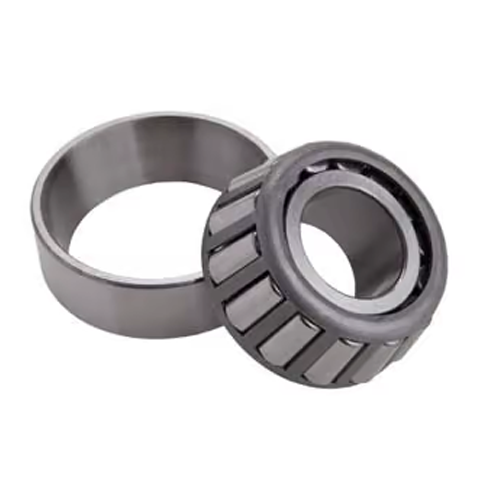
NTN NTN 4T-32010X Single Row Tapered Roller Bearing, D=50mm
NTN 4T-32010X Single Row Tapered Roller Bearing (Inside Dia - 50mm, Outside Dia - 80mm) SPECIFICATIONS Type of Product : Single Row Tapered Roller Bearing Inside Diameter (d) (mm) : 50 Outside Diameter D (mm) : 80 Width Dia mm : 21.64 Model No : 4T-32010X 1. Types, design features, and characteristics Tapered roller bearings are designed so the tapered vertex of the raceway surfaces of the inner and outer rings and rollers converge at one point on the centerline of the bearing (see Fig. 1).The tapered rollers are guided by the compound force of the inner and outer raceway surfaces which keep the rollers pressed up against the large rib on the inner ring.A large variety of these bearings, including single, double, and four row arrangements, are available in both metric and inch series. Each type and associated characteristics are shown in Table 1. For four-row tapered roller bearings, see section “C. Special application bearings.” Table 1 Tapered roller bearing types and characteristics Type Characteristics Single row taperedroller bearings (1) There are both metric and inch series adhering to the standards shown in the following table. Dimension series *Dimension series previously not covered by 3XX are regulated under JIS B 1512; dimensions previously missing from 3XX will henceforth use the bearing number. (2) In addition to the standard design, there are also medium contact angle and large contact angle types, denoted by the contact angle codes at the end of the part numbers (C and D, respectively). (3) Subunits Tapered roller bearings can be disassembled into parts: the inner ring, rollers, and cage (collectively known as the “CONE”) and the outer ring (known as the “CUP”). These are the bearing’s “subunits”. Subunit dimensions are standardized under ISO or ABMA standards, and unified subunits are interchangeable within each dimensional standard. However, high precision grade bearings are generally not interchangeable, and these subunits must be used by assembling only subunits with identical manufacturing numbers.Aside from any cautionary notes that may appear, the single row tapered roller bearings listed in the dimension tables have subunits standardized for both metric and inch systems (including J series). (Refer to Fig. 2) Single row taperedroller bearings (4) These bearings are constructed to have a high capacity for radial loads, axial loads, and combined loads. The larger the contact angle, the greater the axial load capacity. When a pure radial load is applied to a tapered roller bearing, an induced load in the axial direction is also generated, so these bearings are generally used in pairs.(5) Single row tapered roller bearings are separable, so both the inner and outer rings can be used with tight fits. (6) Tapered roller bearings are also manufactured with flanges attached to the outer rings. For more details, contact NTN Engineering. (Refer to Fig. 3) Duplex tapered roller bearings (1) When two single-row tapered roller bearings are to be used in combination, the bearing clearance and preload are adjusted by the inner ring spacer or the outer ring spacer (see Fig. 4).(2) A product number and a combination code are indicated on inner rings, outer rings, and spacers. Parts displaying the same number and code must be used in combination.(3) See A-96 Table 8.14 for the axial internal clearance. Double row taperedroller bearings (1) Back-to-back arrangement (using double row outer rings) and face-to-face arrangement (using double row inner rings) are both available. The assemblies have been adjusted so that each type's internal clearance values are fixed. Only parts with identical manufacturing numbers can be used and they must be assembled according to their code numbers. (Refer to Fig. 5)(2) See A-96 Table 8.14 for the axial internal clearance of double-row and duplex bearings. 2. Standard cage type In general, pressed cages (see Fig. 6) are used in tapered roller bearings. For large sized bearings, machined or pin type cages may also be used, while resin cages may also be used for smaller sized bearings. 3. Allowable misalignment In order to avoid edge loading and potential for premature failure, the maximum allowable misalignment based on bearing series can be found below.The allowable misalignment of combined bearings is influenced by the load center position, so please consult NTN Engineering.• Single row (standard) …………… 1/ 2 000• Single row (ULTAGE) …………… 1/ 600 4. Precautions If bearing load is light during operation, or if the ratio of axial to radial load for duplex and double row bearings exceeds the value of e, slipping may develop between the rollers and raceway surface, sometimes resulting in smearing. The mass of rollers and cages particularly tends to be large for large tapered roller bearings. For additional details, please contact NTN Engineering.In tapered roller bearings, the cage may protrude beyond the inner and/or outer ring side faces. Care should be taken when designing the housing and shaft to ensure contact with the cage does not occur.
$15.77
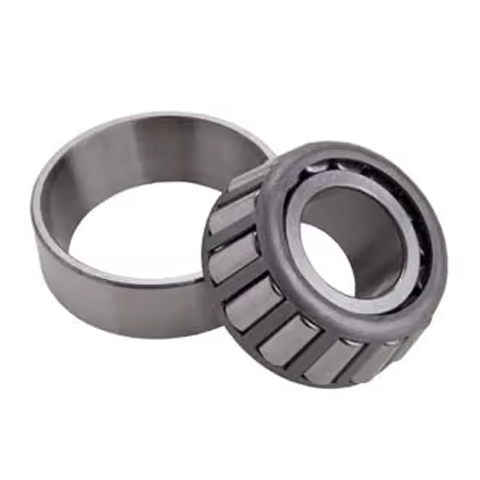
NTN NTN 4T-32008X Single Row Tapered Roller Bearing, D=40mm
NTN 4T-32008X Single Row Tapered Roller Bearing (Inside Dia - 40mm, Outside Dia - 68mm) SPECIFICATIONS Type of Product : Single Row Tapered Roller Bearing Inside Diameter (d) (mm) : 40 Outside Diameter D (mm) : 68 Width Dia mm : 19 Model No : 4T-32008X 1. Types, design features, and characteristics Tapered roller bearings are designed so the tapered vertex of the raceway surfaces of the inner and outer rings and rollers converge at one point on the centerline of the bearing (see Fig. 1).The tapered rollers are guided by the compound force of the inner and outer raceway surfaces which keep the rollers pressed up against the large rib on the inner ring.A large variety of these bearings, including single, double, and four row arrangements, are available in both metric and inch series. Each type and associated characteristics are shown in Table 1. For four-row tapered roller bearings, see section “C. Special application bearings.” Table 1 Tapered roller bearing types and characteristics Type Characteristics Single row taperedroller bearings (1) There are both metric and inch series adhering to the standards shown in the following table. Dimension series *Dimension series previously not covered by 3XX are regulated under JIS B 1512; dimensions previously missing from 3XX will henceforth use the bearing number. (2) In addition to the standard design, there are also medium contact angle and large contact angle types, denoted by the contact angle codes at the end of the part numbers (C and D, respectively). (3) Subunits Tapered roller bearings can be disassembled into parts: the inner ring, rollers, and cage (collectively known as the “CONE”) and the outer ring (known as the “CUP”). These are the bearing’s “subunits”. Subunit dimensions are standardized under ISO or ABMA standards, and unified subunits are interchangeable within each dimensional standard. However, high precision grade bearings are generally not interchangeable, and these subunits must be used by assembling only subunits with identical manufacturing numbers.Aside from any cautionary notes that may appear, the single row tapered roller bearings listed in the dimension tables have subunits standardized for both metric and inch systems (including J series). (Refer to Fig. 2) Single row taperedroller bearings (4) These bearings are constructed to have a high capacity for radial loads, axial loads, and combined loads. The larger the contact angle, the greater the axial load capacity. When a pure radial load is applied to a tapered roller bearing, an induced load in the axial direction is also generated, so these bearings are generally used in pairs.(5) Single row tapered roller bearings are separable, so both the inner and outer rings can be used with tight fits. (6) Tapered roller bearings are also manufactured with flanges attached to the outer rings. For more details, contact NTN Engineering. (Refer to Fig. 3) Duplex tapered roller bearings (1) When two single-row tapered roller bearings are to be used in combination, the bearing clearance and preload are adjusted by the inner ring spacer or the outer ring spacer (see Fig. 4).(2) A product number and a combination code are indicated on inner rings, outer rings, and spacers. Parts displaying the same number and code must be used in combination.(3) See A-96 Table 8.14 for the axial internal clearance. Double row taperedroller bearings (1) Back-to-back arrangement (using double row outer rings) and face-to-face arrangement (using double row inner rings) are both available. The assemblies have been adjusted so that each type's internal clearance values are fixed. Only parts with identical manufacturing numbers can be used and they must be assembled according to their code numbers. (Refer to Fig. 5)(2) See A-96 Table 8.14 for the axial internal clearance of double-row and duplex bearings. 2. Standard cage type In general, pressed cages (see Fig. 6) are used in tapered roller bearings. For large sized bearings, machined or pin type cages may also be used, while resin cages may also be used for smaller sized bearings. 3. Allowable misalignment In order to avoid edge loading and potential for premature failure, the maximum allowable misalignment based on bearing series can be found below.The allowable misalignment of combined bearings is influenced by the load center position, so please consult NTN Engineering.• Single row (standard) …………… 1/ 2 000• Single row (ULTAGE) …………… 1/ 600 4. Precautions If bearing load is light during operation, or if the ratio of axial to radial load for duplex and double row bearings exceeds the value of e, slipping may develop between the rollers and raceway surface, sometimes resulting in smearing. The mass of rollers and cages particularly tends to be large for large tapered roller bearings. For additional details, please contact NTN Engineering.In tapered roller bearings, the cage may protrude beyond the inner and/or outer ring side faces. Care should be taken when designing the housing and shaft to ensure contact with the cage does not occur.
$12.07
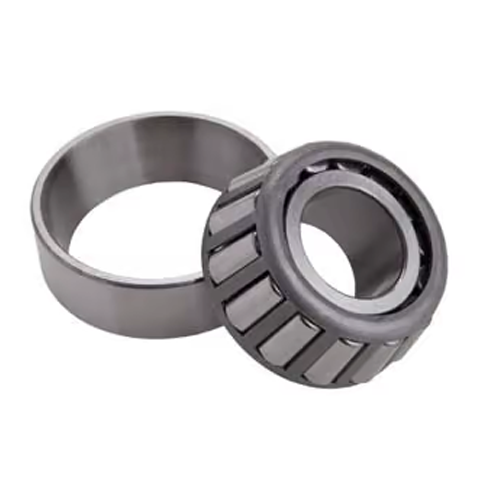
NTN NTN 4T-32006X Single Row Tapered Roller Bearing, D=30mm
NTN 4T-32006X Single Row Tapered Roller Bearing (Inside Dia - 30mm, Outside Dia - 55mm) SPECIFICATIONS Type of Product : Single Row Tapered Roller Bearing Inside Diameter (d) (mm) : 30 Outside Diameter D (mm) : 55 Width Dia mm : 17 Model No : 4T-32006X 1. Types, design features, and characteristics Tapered roller bearings are designed so the tapered vertex of the raceway surfaces of the inner and outer rings and rollers converge at one point on the centerline of the bearing (see Fig. 1).The tapered rollers are guided by the compound force of the inner and outer raceway surfaces which keep the rollers pressed up against the large rib on the inner ring.A large variety of these bearings, including single, double, and four row arrangements, are available in both metric and inch series. Each type and associated characteristics are shown in Table 1. For four-row tapered roller bearings, see section “C. Special application bearings.” Table 1 Tapered roller bearing types and characteristics Type Characteristics Single row taperedroller bearings (1) There are both metric and inch series adhering to the standards shown in the following table. Dimension series *Dimension series previously not covered by 3XX are regulated under JIS B 1512; dimensions previously missing from 3XX will henceforth use the bearing number. (2) In addition to the standard design, there are also medium contact angle and large contact angle types, denoted by the contact angle codes at the end of the part numbers (C and D, respectively). (3) Subunits Tapered roller bearings can be disassembled into parts: the inner ring, rollers, and cage (collectively known as the “CONE”) and the outer ring (known as the “CUP”). These are the bearing’s “subunits”. Subunit dimensions are standardized under ISO or ABMA standards, and unified subunits are interchangeable within each dimensional standard. However, high precision grade bearings are generally not interchangeable, and these subunits must be used by assembling only subunits with identical manufacturing numbers.Aside from any cautionary notes that may appear, the single row tapered roller bearings listed in the dimension tables have subunits standardized for both metric and inch systems (including J series). (Refer to Fig. 2) Single row taperedroller bearings (4) These bearings are constructed to have a high capacity for radial loads, axial loads, and combined loads. The larger the contact angle, the greater the axial load capacity. When a pure radial load is applied to a tapered roller bearing, an induced load in the axial direction is also generated, so these bearings are generally used in pairs.(5) Single row tapered roller bearings are separable, so both the inner and outer rings can be used with tight fits. (6) Tapered roller bearings are also manufactured with flanges attached to the outer rings. For more details, contact NTN Engineering. (Refer to Fig. 3) Duplex tapered roller bearings (1) When two single-row tapered roller bearings are to be used in combination, the bearing clearance and preload are adjusted by the inner ring spacer or the outer ring spacer (see Fig. 4).(2) A product number and a combination code are indicated on inner rings, outer rings, and spacers. Parts displaying the same number and code must be used in combination.(3) See A-96 Table 8.14 for the axial internal clearance. Double row taperedroller bearings (1) Back-to-back arrangement (using double row outer rings) and face-to-face arrangement (using double row inner rings) are both available. The assemblies have been adjusted so that each type's internal clearance values are fixed. Only parts with identical manufacturing numbers can be used and they must be assembled according to their code numbers. (Refer to Fig. 5)(2) See A-96 Table 8.14 for the axial internal clearance of double-row and duplex bearings. 2. Standard cage type In general, pressed cages (see Fig. 6) are used in tapered roller bearings. For large sized bearings, machined or pin type cages may also be used, while resin cages may also be used for smaller sized bearings. 3. Allowable misalignment In order to avoid edge loading and potential for premature failure, the maximum allowable misalignment based on bearing series can be found below.The allowable misalignment of combined bearings is influenced by the load center position, so please consult NTN Engineering.• Single row (standard) …………… 1/ 2 000• Single row (ULTAGE) …………… 1/ 600 4. Precautions If bearing load is light during operation, or if the ratio of axial to radial load for duplex and double row bearings exceeds the value of e, slipping may develop between the rollers and raceway surface, sometimes resulting in smearing. The mass of rollers and cages particularly tends to be large for large tapered roller bearings. For additional details, please contact NTN Engineering.In tapered roller bearings, the cage may protrude beyond the inner and/or outer ring side faces. Care should be taken when designing the housing and shaft to ensure contact with the cage does not occur.
$9.77
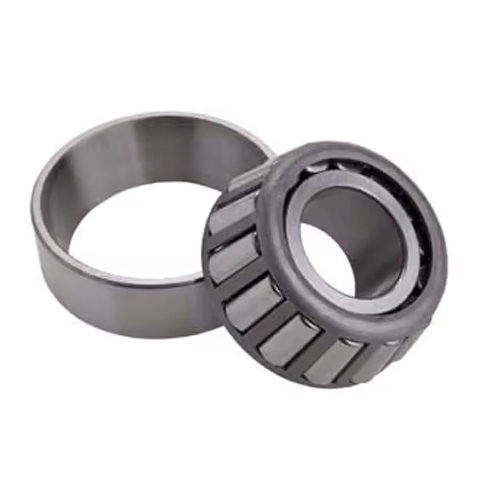
NTN NTN 4T-32005X Single Row Tapered Roller Bearing, D=25mm
NTN 4T-32005X Single Row Tapered Roller Bearing (Inside Dia - 25mm, Outside Dia - 47mm) SPECIFICATIONS Type of Product : Single Row Tapered Roller Bearing Inside Diameter (d) (mm) : 25 Outside Diameter D (mm) : 47 Width Dia mm : 15 Model No : 4T-32005X 1. Types, design features, and characteristics Tapered roller bearings are designed so the tapered vertex of the raceway surfaces of the inner and outer rings and rollers converge at one point on the centerline of the bearing (see Fig. 1).The tapered rollers are guided by the compound force of the inner and outer raceway surfaces which keep the rollers pressed up against the large rib on the inner ring.A large variety of these bearings, including single, double, and four row arrangements, are available in both metric and inch series. Each type and associated characteristics are shown in Table 1. For four-row tapered roller bearings, see section “C. Special application bearings.” Table 1 Tapered roller bearing types and characteristics Type Characteristics Single row taperedroller bearings (1) There are both metric and inch series adhering to the standards shown in the following table. Dimension series *Dimension series previously not covered by 3XX are regulated under JIS B 1512; dimensions previously missing from 3XX will henceforth use the bearing number. (2) In addition to the standard design, there are also medium contact angle and large contact angle types, denoted by the contact angle codes at the end of the part numbers (C and D, respectively). (3) Subunits Tapered roller bearings can be disassembled into parts: the inner ring, rollers, and cage (collectively known as the “CONE”) and the outer ring (known as the “CUP”). These are the bearing’s “subunits”. Subunit dimensions are standardized under ISO or ABMA standards, and unified subunits are interchangeable within each dimensional standard. However, high precision grade bearings are generally not interchangeable, and these subunits must be used by assembling only subunits with identical manufacturing numbers.Aside from any cautionary notes that may appear, the single row tapered roller bearings listed in the dimension tables have subunits standardized for both metric and inch systems (including J series). (Refer to Fig. 2) Single row taperedroller bearings (4) These bearings are constructed to have a high capacity for radial loads, axial loads, and combined loads. The larger the contact angle, the greater the axial load capacity. When a pure radial load is applied to a tapered roller bearing, an induced load in the axial direction is also generated, so these bearings are generally used in pairs.(5) Single row tapered roller bearings are separable, so both the inner and outer rings can be used with tight fits. (6) Tapered roller bearings are also manufactured with flanges attached to the outer rings. For more details, contact NTN Engineering. (Refer to Fig. 3) Duplex tapered roller bearings (1) When two single-row tapered roller bearings are to be used in combination, the bearing clearance and preload are adjusted by the inner ring spacer or the outer ring spacer (see Fig. 4).(2) A product number and a combination code are indicated on inner rings, outer rings, and spacers. Parts displaying the same number and code must be used in combination.(3) See A-96 Table 8.14 for the axial internal clearance. Double row taperedroller bearings (1) Back-to-back arrangement (using double row outer rings) and face-to-face arrangement (using double row inner rings) are both available. The assemblies have been adjusted so that each type's internal clearance values are fixed. Only parts with identical manufacturing numbers can be used and they must be assembled according to their code numbers. (Refer to Fig. 5)(2) See A-96 Table 8.14 for the axial internal clearance of double-row and duplex bearings. 2. Standard cage type In general, pressed cages (see Fig. 6) are used in tapered roller bearings. For large sized bearings, machined or pin type cages may also be used, while resin cages may also be used for smaller sized bearings. 3. Allowable misalignment In order to avoid edge loading and potential for premature failure, the maximum allowable misalignment based on bearing series can be found below.The allowable misalignment of combined bearings is influenced by the load center position, so please consult NTN Engineering.• Single row (standard) …………… 1/ 2 000• Single row (ULTAGE) …………… 1/ 600 4. Precautions If bearing load is light during operation, or if the ratio of axial to radial load for duplex and double row bearings exceeds the value of e, slipping may develop between the rollers and raceway surface, sometimes resulting in smearing. The mass of rollers and cages particularly tends to be large for large tapered roller bearings. For additional details, please contact NTN Engineering.In tapered roller bearings, the cage may protrude beyond the inner and/or outer ring side faces. Care should be taken when designing the housing and shaft to ensure contact with the cage does not occur.
$8.72
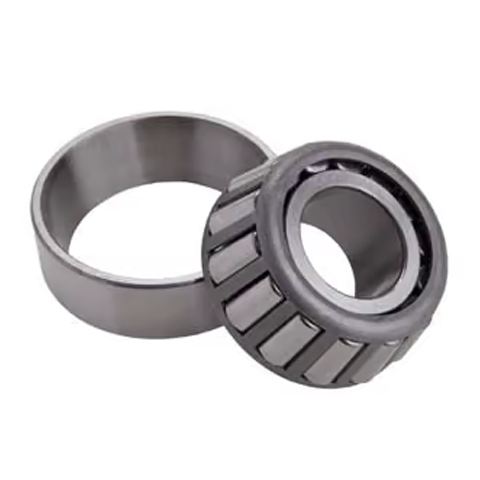
NTN NTN 4T-32004X Single Row Tapered Roller Bearing, D=20mm
NTN 4T-32004X Single Row Tapered Roller Bearing (Inside Dia - 20mm, Outside Dia - 42mm) SPECIFICATIONS Type of Product : Single Row Tapered Roller Bearing Inside Diameter (d) (mm) : 20 Outside Diameter D (mm) : 42 Width Dia mm : 15 Model No : 4T-32004X 1. Types, design features, and characteristics Tapered roller bearings are designed so the tapered vertex of the raceway surfaces of the inner and outer rings and rollers converge at one point on the centerline of the bearing (see Fig. 1).The tapered rollers are guided by the compound force of the inner and outer raceway surfaces which keep the rollers pressed up against the large rib on the inner ring.A large variety of these bearings, including single, double, and four row arrangements, are available in both metric and inch series. Each type and associated characteristics are shown in Table 1. For four-row tapered roller bearings, see section “C. Special application bearings.” Table 1 Tapered roller bearing types and characteristics Type Characteristics Single row taperedroller bearings (1) There are both metric and inch series adhering to the standards shown in the following table. Dimension series *Dimension series previously not covered by 3XX are regulated under JIS B 1512; dimensions previously missing from 3XX will henceforth use the bearing number. (2) In addition to the standard design, there are also medium contact angle and large contact angle types, denoted by the contact angle codes at the end of the part numbers (C and D, respectively). (3) Subunits Tapered roller bearings can be disassembled into parts: the inner ring, rollers, and cage (collectively known as the “CONE”) and the outer ring (known as the “CUP”). These are the bearing’s “subunits”. Subunit dimensions are standardized under ISO or ABMA standards, and unified subunits are interchangeable within each dimensional standard. However, high precision grade bearings are generally not interchangeable, and these subunits must be used by assembling only subunits with identical manufacturing numbers.Aside from any cautionary notes that may appear, the single row tapered roller bearings listed in the dimension tables have subunits standardized for both metric and inch systems (including J series). (Refer to Fig. 2) Single row taperedroller bearings (4) These bearings are constructed to have a high capacity for radial loads, axial loads, and combined loads. The larger the contact angle, the greater the axial load capacity. When a pure radial load is applied to a tapered roller bearing, an induced load in the axial direction is also generated, so these bearings are generally used in pairs.(5) Single row tapered roller bearings are separable, so both the inner and outer rings can be used with tight fits. (6) Tapered roller bearings are also manufactured with flanges attached to the outer rings. For more details, contact NTN Engineering. (Refer to Fig. 3) Duplex tapered roller bearings (1) When two single-row tapered roller bearings are to be used in combination, the bearing clearance and preload are adjusted by the inner ring spacer or the outer ring spacer (see Fig. 4).(2) A product number and a combination code are indicated on inner rings, outer rings, and spacers. Parts displaying the same number and code must be used in combination.(3) See A-96 Table 8.14 for the axial internal clearance. Double row taperedroller bearings (1) Back-to-back arrangement (using double row outer rings) and face-to-face arrangement (using double row inner rings) are both available. The assemblies have been adjusted so that each type's internal clearance values are fixed. Only parts with identical manufacturing numbers can be used and they must be assembled according to their code numbers. (Refer to Fig. 5)(2) See A-96 Table 8.14 for the axial internal clearance of double-row and duplex bearings. 2. Standard cage type In general, pressed cages (see Fig. 6) are used in tapered roller bearings. For large sized bearings, machined or pin type cages may also be used, while resin cages may also be used for smaller sized bearings. 3. Allowable misalignment In order to avoid edge loading and potential for premature failure, the maximum allowable misalignment based on bearing series can be found below.The allowable misalignment of combined bearings is influenced by the load center position, so please consult NTN Engineering.• Single row (standard) …………… 1/ 2 000• Single row (ULTAGE) …………… 1/ 600 4. Precautions If bearing load is light during operation, or if the ratio of axial to radial load for duplex and double row bearings exceeds the value of e, slipping may develop between the rollers and raceway surface, sometimes resulting in smearing. The mass of rollers and cages particularly tends to be large for large tapered roller bearings. For additional details, please contact NTN Engineering.In tapered roller bearings, the cage may protrude beyond the inner and/or outer ring side faces. Care should be taken when designing the housing and shaft to ensure contact with the cage does not occur.
$6.14
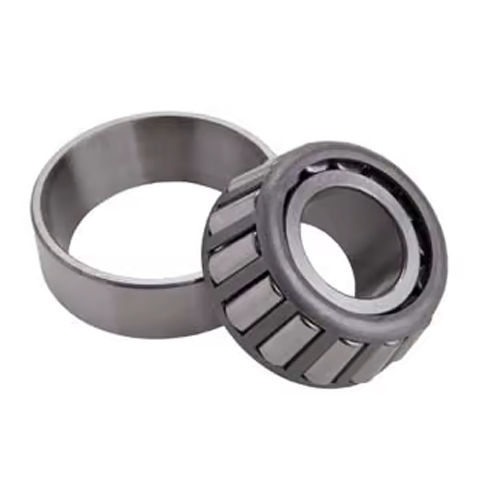
NTN NTN 4T-30314 Single Row Tapered Roller Bearing, D=70mm
NTN 4T-30314 Single Row Tapered Roller Bearing (Inside Dia - 70mm, Outside Dia - 150mm) SPECIFICATIONS Type of Product : Single Row Tapered Roller Bearing Inside Diameter (d) (mm) : 70 Outside Diameter D (mm) : 150 Width Dia mm : 35 Model No : 4T-30314 1. Types, design features, and characteristics Tapered roller bearings are designed so the tapered vertex of the raceway surfaces of the inner and outer rings and rollers converge at one point on the centerline of the bearing (see Fig. 1).The tapered rollers are guided by the compound force of the inner and outer raceway surfaces which keep the rollers pressed up against the large rib on the inner ring.A large variety of these bearings, including single, double, and four row arrangements, are available in both metric and inch series. Each type and associated characteristics are shown in Table 1. For four-row tapered roller bearings, see section “C. Special application bearings.” Table 1 Tapered roller bearing types and characteristics Type Characteristics Single row taperedroller bearings (1) There are both metric and inch series adhering to the standards shown in the following table. Dimension series *Dimension series previously not covered by 3XX are regulated under JIS B 1512; dimensions previously missing from 3XX will henceforth use the bearing number. (2) In addition to the standard design, there are also medium contact angle and large contact angle types, denoted by the contact angle codes at the end of the part numbers (C and D, respectively). (3) Subunits Tapered roller bearings can be disassembled into parts: the inner ring, rollers, and cage (collectively known as the “CONE”) and the outer ring (known as the “CUP”). These are the bearing’s “subunits”. Subunit dimensions are standardized under ISO or ABMA standards, and unified subunits are interchangeable within each dimensional standard. However, high precision grade bearings are generally not interchangeable, and these subunits must be used by assembling only subunits with identical manufacturing numbers.Aside from any cautionary notes that may appear, the single row tapered roller bearings listed in the dimension tables have subunits standardized for both metric and inch systems (including J series). (Refer to Fig. 2) Single row taperedroller bearings (4) These bearings are constructed to have a high capacity for radial loads, axial loads, and combined loads. The larger the contact angle, the greater the axial load capacity. When a pure radial load is applied to a tapered roller bearing, an induced load in the axial direction is also generated, so these bearings are generally used in pairs.(5) Single row tapered roller bearings are separable, so both the inner and outer rings can be used with tight fits. (6) Tapered roller bearings are also manufactured with flanges attached to the outer rings. For more details, contact NTN Engineering. (Refer to Fig. 3) Duplex tapered roller bearings (1) When two single-row tapered roller bearings are to be used in combination, the bearing clearance and preload are adjusted by the inner ring spacer or the outer ring spacer (see Fig. 4).(2) A product number and a combination code are indicated on inner rings, outer rings, and spacers. Parts displaying the same number and code must be used in combination.(3) See A-96 Table 8.14 for the axial internal clearance. Double row taperedroller bearings (1) Back-to-back arrangement (using double row outer rings) and face-to-face arrangement (using double row inner rings) are both available. The assemblies have been adjusted so that each type's internal clearance values are fixed. Only parts with identical manufacturing numbers can be used and they must be assembled according to their code numbers. (Refer to Fig. 5)(2) See A-96 Table 8.14 for the axial internal clearance of double-row and duplex bearings. 2. Standard cage type In general, pressed cages (see Fig. 6) are used in tapered roller bearings. For large sized bearings, machined or pin type cages may also be used, while resin cages may also be used for smaller sized bearings. 3. Allowable misalignment In order to avoid edge loading and potential for premature failure, the maximum allowable misalignment based on bearing series can be found below.The allowable misalignment of combined bearings is influenced by the load center position, so please consult NTN Engineering.• Single row (standard) …………… 1/ 2 000• Single row (ULTAGE) …………… 1/ 600 4. Precautions If bearing load is light during operation, or if the ratio of axial to radial load for duplex and double row bearings exceeds the value of e, slipping may develop between the rollers and raceway surface, sometimes resulting in smearing. The mass of rollers and cages particularly tends to be large for large tapered roller bearings. For additional details, please contact NTN Engineering.In tapered roller bearings, the cage may protrude beyond the inner and/or outer ring side faces. Care should be taken when designing the housing and shaft to ensure contact with the cage does not occur.
$80.38
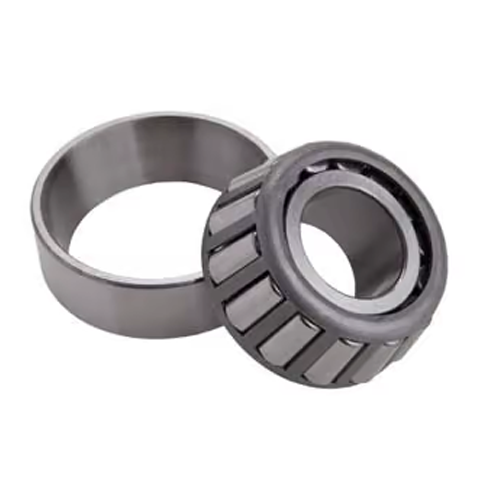
NTN NTN 4T-30312 Single Row Tapered Roller Bearing, D=60mm
NTN 4T-30312 Single Row Tapered Roller Bearing (Inside Dia - 60mm, Outside Dia - 130mm) SPECIFICATIONS Type of Product : Single Row Tapered Roller Bearing Inside Diameter (d) (mm) : 60 Outside Diameter D (mm) : 130 Width Dia mm : 31 Model No : 4T-30312 1. Types, design features, and characteristics Tapered roller bearings are designed so the tapered vertex of the raceway surfaces of the inner and outer rings and rollers converge at one point on the centerline of the bearing (see Fig. 1).The tapered rollers are guided by the compound force of the inner and outer raceway surfaces which keep the rollers pressed up against the large rib on the inner ring.A large variety of these bearings, including single, double, and four row arrangements, are available in both metric and inch series. Each type and associated characteristics are shown in Table 1. For four-row tapered roller bearings, see section “C. Special application bearings.” Table 1 Tapered roller bearing types and characteristics Type Characteristics Single row taperedroller bearings (1) There are both metric and inch series adhering to the standards shown in the following table. Dimension series *Dimension series previously not covered by 3XX are regulated under JIS B 1512; dimensions previously missing from 3XX will henceforth use the bearing number. (2) In addition to the standard design, there are also medium contact angle and large contact angle types, denoted by the contact angle codes at the end of the part numbers (C and D, respectively). (3) Subunits Tapered roller bearings can be disassembled into parts: the inner ring, rollers, and cage (collectively known as the “CONE”) and the outer ring (known as the “CUP”). These are the bearing’s “subunits”. Subunit dimensions are standardized under ISO or ABMA standards, and unified subunits are interchangeable within each dimensional standard. However, high precision grade bearings are generally not interchangeable, and these subunits must be used by assembling only subunits with identical manufacturing numbers.Aside from any cautionary notes that may appear, the single row tapered roller bearings listed in the dimension tables have subunits standardized for both metric and inch systems (including J series). (Refer to Fig. 2) Single row taperedroller bearings (4) These bearings are constructed to have a high capacity for radial loads, axial loads, and combined loads. The larger the contact angle, the greater the axial load capacity. When a pure radial load is applied to a tapered roller bearing, an induced load in the axial direction is also generated, so these bearings are generally used in pairs.(5) Single row tapered roller bearings are separable, so both the inner and outer rings can be used with tight fits. (6) Tapered roller bearings are also manufactured with flanges attached to the outer rings. For more details, contact NTN Engineering. (Refer to Fig. 3) Duplex tapered roller bearings (1) When two single-row tapered roller bearings are to be used in combination, the bearing clearance and preload are adjusted by the inner ring spacer or the outer ring spacer (see Fig. 4).(2) A product number and a combination code are indicated on inner rings, outer rings, and spacers. Parts displaying the same number and code must be used in combination.(3) See A-96 Table 8.14 for the axial internal clearance. Double row taperedroller bearings (1) Back-to-back arrangement (using double row outer rings) and face-to-face arrangement (using double row inner rings) are both available. The assemblies have been adjusted so that each type's internal clearance values are fixed. Only parts with identical manufacturing numbers can be used and they must be assembled according to their code numbers. (Refer to Fig. 5)(2) See A-96 Table 8.14 for the axial internal clearance of double-row and duplex bearings. 2. Standard cage type In general, pressed cages (see Fig. 6) are used in tapered roller bearings. For large sized bearings, machined or pin type cages may also be used, while resin cages may also be used for smaller sized bearings. 3. Allowable misalignment In order to avoid edge loading and potential for premature failure, the maximum allowable misalignment based on bearing series can be found below.The allowable misalignment of combined bearings is influenced by the load center position, so please consult NTN Engineering.• Single row (standard) …………… 1/ 2 000• Single row (ULTAGE) …………… 1/ 600 4. Precautions If bearing load is light during operation, or if the ratio of axial to radial load for duplex and double row bearings exceeds the value of e, slipping may develop between the rollers and raceway surface, sometimes resulting in smearing. The mass of rollers and cages particularly tends to be large for large tapered roller bearings. For additional details, please contact NTN Engineering.In tapered roller bearings, the cage may protrude beyond the inner and/or outer ring side faces. Care should be taken when designing the housing and shaft to ensure contact with the cage does not occur.
$54.54
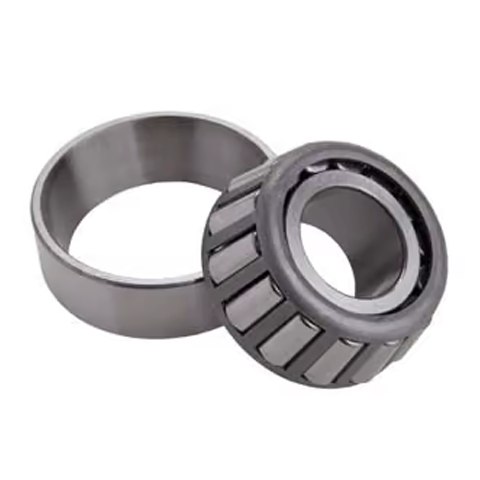
NTN NTN 4T-30311 Single Row Tapered Roller Bearing, D=55mm
NTN 4T-30311 Single Row Tapered Roller Bearing (Inside Dia - 55mm, Outside Dia - 120mm) SPECIFICATIONS Type of Product : Single Row Tapered Roller Bearing Inside Diameter (d) (mm) : 55 Outside Diameter D (mm) : 120 Width Dia mm : 29 Model No : 4T-30311 1. Types, design features, and characteristics Tapered roller bearings are designed so the tapered vertex of the raceway surfaces of the inner and outer rings and rollers converge at one point on the centerline of the bearing (see Fig. 1).The tapered rollers are guided by the compound force of the inner and outer raceway surfaces which keep the rollers pressed up against the large rib on the inner ring.A large variety of these bearings, including single, double, and four row arrangements, are available in both metric and inch series. Each type and associated characteristics are shown in Table 1. For four-row tapered roller bearings, see section “C. Special application bearings.” Table 1 Tapered roller bearing types and characteristics Type Characteristics Single row taperedroller bearings (1) There are both metric and inch series adhering to the standards shown in the following table. Dimension series *Dimension series previously not covered by 3XX are regulated under JIS B 1512; dimensions previously missing from 3XX will henceforth use the bearing number. (2) In addition to the standard design, there are also medium contact angle and large contact angle types, denoted by the contact angle codes at the end of the part numbers (C and D, respectively). (3) Subunits Tapered roller bearings can be disassembled into parts: the inner ring, rollers, and cage (collectively known as the “CONE”) and the outer ring (known as the “CUP”). These are the bearing’s “subunits”. Subunit dimensions are standardized under ISO or ABMA standards, and unified subunits are interchangeable within each dimensional standard. However, high precision grade bearings are generally not interchangeable, and these subunits must be used by assembling only subunits with identical manufacturing numbers.Aside from any cautionary notes that may appear, the single row tapered roller bearings listed in the dimension tables have subunits standardized for both metric and inch systems (including J series). (Refer to Fig. 2) Single row taperedroller bearings (4) These bearings are constructed to have a high capacity for radial loads, axial loads, and combined loads. The larger the contact angle, the greater the axial load capacity. When a pure radial load is applied to a tapered roller bearing, an induced load in the axial direction is also generated, so these bearings are generally used in pairs.(5) Single row tapered roller bearings are separable, so both the inner and outer rings can be used with tight fits. (6) Tapered roller bearings are also manufactured with flanges attached to the outer rings. For more details, contact NTN Engineering. (Refer to Fig. 3) Duplex tapered roller bearings (1) When two single-row tapered roller bearings are to be used in combination, the bearing clearance and preload are adjusted by the inner ring spacer or the outer ring spacer (see Fig. 4).(2) A product number and a combination code are indicated on inner rings, outer rings, and spacers. Parts displaying the same number and code must be used in combination.(3) See A-96 Table 8.14 for the axial internal clearance. Double row taperedroller bearings (1) Back-to-back arrangement (using double row outer rings) and face-to-face arrangement (using double row inner rings) are both available. The assemblies have been adjusted so that each type's internal clearance values are fixed. Only parts with identical manufacturing numbers can be used and they must be assembled according to their code numbers. (Refer to Fig. 5)(2) See A-96 Table 8.14 for the axial internal clearance of double-row and duplex bearings. 2. Standard cage type In general, pressed cages (see Fig. 6) are used in tapered roller bearings. For large sized bearings, machined or pin type cages may also be used, while resin cages may also be used for smaller sized bearings. 3. Allowable misalignment In order to avoid edge loading and potential for premature failure, the maximum allowable misalignment based on bearing series can be found below.The allowable misalignment of combined bearings is influenced by the load center position, so please consult NTN Engineering.• Single row (standard) …………… 1/ 2 000• Single row (ULTAGE) …………… 1/ 600 4. Precautions If bearing load is light during operation, or if the ratio of axial to radial load for duplex and double row bearings exceeds the value of e, slipping may develop between the rollers and raceway surface, sometimes resulting in smearing. The mass of rollers and cages particularly tends to be large for large tapered roller bearings. For additional details, please contact NTN Engineering.In tapered roller bearings, the cage may protrude beyond the inner and/or outer ring side faces. Care should be taken when designing the housing and shaft to ensure contact with the cage does not occur.
$39.80
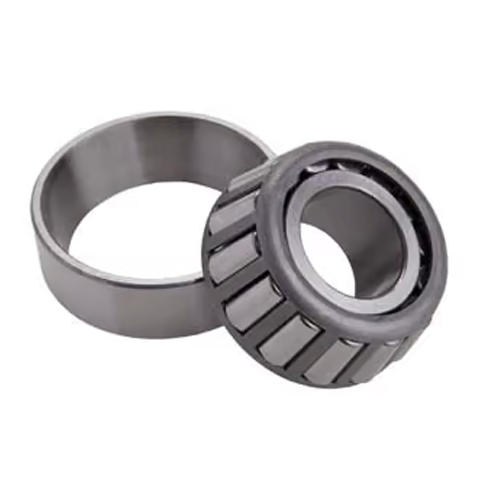
NTN NTN 4T-30310 Single Row Tapered Roller Bearing, D=50mm
NTN 4T-30310 Single Row Tapered Roller Bearing (Inside Dia - 50mm, Outside Dia - 110mm) SPECIFICATIONS Type of Product : Single Row Tapered Roller Bearing Inside Diameter (d) (mm) : 50 Outside Diameter D (mm) : 110 Width Dia mm : 27 Model No : 4T-30310 1. Types, design features, and characteristics Tapered roller bearings are designed so the tapered vertex of the raceway surfaces of the inner and outer rings and rollers converge at one point on the centerline of the bearing (see Fig. 1).The tapered rollers are guided by the compound force of the inner and outer raceway surfaces which keep the rollers pressed up against the large rib on the inner ring.A large variety of these bearings, including single, double, and four row arrangements, are available in both metric and inch series. Each type and associated characteristics are shown in Table 1. For four-row tapered roller bearings, see section “C. Special application bearings.” Table 1 Tapered roller bearing types and characteristics Type Characteristics Single row taperedroller bearings (1) There are both metric and inch series adhering to the standards shown in the following table. Dimension series *Dimension series previously not covered by 3XX are regulated under JIS B 1512; dimensions previously missing from 3XX will henceforth use the bearing number. (2) In addition to the standard design, there are also medium contact angle and large contact angle types, denoted by the contact angle codes at the end of the part numbers (C and D, respectively). (3) Subunits Tapered roller bearings can be disassembled into parts: the inner ring, rollers, and cage (collectively known as the “CONE”) and the outer ring (known as the “CUP”). These are the bearing’s “subunits”. Subunit dimensions are standardized under ISO or ABMA standards, and unified subunits are interchangeable within each dimensional standard. However, high precision grade bearings are generally not interchangeable, and these subunits must be used by assembling only subunits with identical manufacturing numbers.Aside from any cautionary notes that may appear, the single row tapered roller bearings listed in the dimension tables have subunits standardized for both metric and inch systems (including J series). (Refer to Fig. 2) Single row taperedroller bearings (4) These bearings are constructed to have a high capacity for radial loads, axial loads, and combined loads. The larger the contact angle, the greater the axial load capacity. When a pure radial load is applied to a tapered roller bearing, an induced load in the axial direction is also generated, so these bearings are generally used in pairs.(5) Single row tapered roller bearings are separable, so both the inner and outer rings can be used with tight fits. (6) Tapered roller bearings are also manufactured with flanges attached to the outer rings. For more details, contact NTN Engineering. (Refer to Fig. 3) Duplex tapered roller bearings (1) When two single-row tapered roller bearings are to be used in combination, the bearing clearance and preload are adjusted by the inner ring spacer or the outer ring spacer (see Fig. 4).(2) A product number and a combination code are indicated on inner rings, outer rings, and spacers. Parts displaying the same number and code must be used in combination.(3) See A-96 Table 8.14 for the axial internal clearance. Double row taperedroller bearings (1) Back-to-back arrangement (using double row outer rings) and face-to-face arrangement (using double row inner rings) are both available. The assemblies have been adjusted so that each type's internal clearance values are fixed. Only parts with identical manufacturing numbers can be used and they must be assembled according to their code numbers. (Refer to Fig. 5)(2) See A-96 Table 8.14 for the axial internal clearance of double-row and duplex bearings. 2. Standard cage type In general, pressed cages (see Fig. 6) are used in tapered roller bearings. For large sized bearings, machined or pin type cages may also be used, while resin cages may also be used for smaller sized bearings. 3. Allowable misalignment In order to avoid edge loading and potential for premature failure, the maximum allowable misalignment based on bearing series can be found below.The allowable misalignment of combined bearings is influenced by the load center position, so please consult NTN Engineering.• Single row (standard) …………… 1/ 2 000• Single row (ULTAGE) …………… 1/ 600 4. Precautions If bearing load is light during operation, or if the ratio of axial to radial load for duplex and double row bearings exceeds the value of e, slipping may develop between the rollers and raceway surface, sometimes resulting in smearing. The mass of rollers and cages particularly tends to be large for large tapered roller bearings. For additional details, please contact NTN Engineering.In tapered roller bearings, the cage may protrude beyond the inner and/or outer ring side faces. Care should be taken when designing the housing and shaft to ensure contact with the cage does not occur.
$30.78
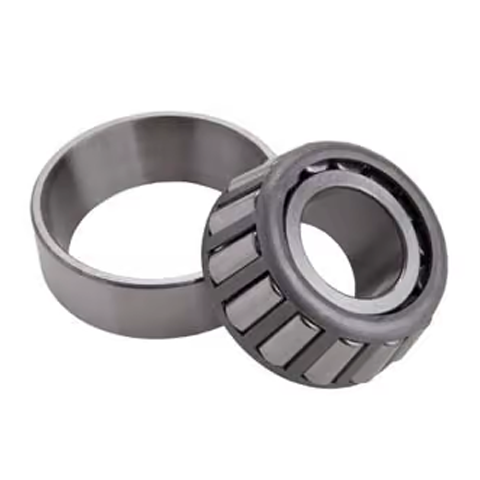
NTN NTN 4T-30307 Single Row Tapered Roller Bearing, D=35mm
NTN 4T-30307 Single Row Tapered Roller Bearing (Inside Dia - 35mm, Outside Dia - 80mm) SPECIFICATIONS Type of Product : Single Row Tapered Roller Bearing Inside Diameter (d) (mm) : 35 Outside Diameter D (mm) : 80 Width Dia mm : 21 Model No : 4T-30307 1. Types, design features, and characteristics Tapered roller bearings are designed so the tapered vertex of the raceway surfaces of the inner and outer rings and rollers converge at one point on the centerline of the bearing (see Fig. 1).The tapered rollers are guided by the compound force of the inner and outer raceway surfaces which keep the rollers pressed up against the large rib on the inner ring.A large variety of these bearings, including single, double, and four row arrangements, are available in both metric and inch series. Each type and associated characteristics are shown in Table 1. For four-row tapered roller bearings, see section “C. Special application bearings.” Table 1 Tapered roller bearing types and characteristics Type Characteristics Single row taperedroller bearings (1) There are both metric and inch series adhering to the standards shown in the following table. Dimension series *Dimension series previously not covered by 3XX are regulated under JIS B 1512; dimensions previously missing from 3XX will henceforth use the bearing number. (2) In addition to the standard design, there are also medium contact angle and large contact angle types, denoted by the contact angle codes at the end of the part numbers (C and D, respectively). (3) Subunits Tapered roller bearings can be disassembled into parts: the inner ring, rollers, and cage (collectively known as the “CONE”) and the outer ring (known as the “CUP”). These are the bearing’s “subunits”. Subunit dimensions are standardized under ISO or ABMA standards, and unified subunits are interchangeable within each dimensional standard. However, high precision grade bearings are generally not interchangeable, and these subunits must be used by assembling only subunits with identical manufacturing numbers.Aside from any cautionary notes that may appear, the single row tapered roller bearings listed in the dimension tables have subunits standardized for both metric and inch systems (including J series). (Refer to Fig. 2) Single row taperedroller bearings (4) These bearings are constructed to have a high capacity for radial loads, axial loads, and combined loads. The larger the contact angle, the greater the axial load capacity. When a pure radial load is applied to a tapered roller bearing, an induced load in the axial direction is also generated, so these bearings are generally used in pairs.(5) Single row tapered roller bearings are separable, so both the inner and outer rings can be used with tight fits. (6) Tapered roller bearings are also manufactured with flanges attached to the outer rings. For more details, contact NTN Engineering. (Refer to Fig. 3) Duplex tapered roller bearings (1) When two single-row tapered roller bearings are to be used in combination, the bearing clearance and preload are adjusted by the inner ring spacer or the outer ring spacer (see Fig. 4).(2) A product number and a combination code are indicated on inner rings, outer rings, and spacers. Parts displaying the same number and code must be used in combination.(3) See A-96 Table 8.14 for the axial internal clearance. Double row taperedroller bearings (1) Back-to-back arrangement (using double row outer rings) and face-to-face arrangement (using double row inner rings) are both available. The assemblies have been adjusted so that each type's internal clearance values are fixed. Only parts with identical manufacturing numbers can be used and they must be assembled according to their code numbers. (Refer to Fig. 5)(2) See A-96 Table 8.14 for the axial internal clearance of double-row and duplex bearings. 2. Standard cage type In general, pressed cages (see Fig. 6) are used in tapered roller bearings. For large sized bearings, machined or pin type cages may also be used, while resin cages may also be used for smaller sized bearings. 3. Allowable misalignment In order to avoid edge loading and potential for premature failure, the maximum allowable misalignment based on bearing series can be found below.The allowable misalignment of combined bearings is influenced by the load center position, so please consult NTN Engineering.• Single row (standard) …………… 1/ 2 000• Single row (ULTAGE) …………… 1/ 600 4. Precautions If bearing load is light during operation, or if the ratio of axial to radial load for duplex and double row bearings exceeds the value of e, slipping may develop between the rollers and raceway surface, sometimes resulting in smearing. The mass of rollers and cages particularly tends to be large for large tapered roller bearings. For additional details, please contact NTN Engineering.In tapered roller bearings, the cage may protrude beyond the inner and/or outer ring side faces. Care should be taken when designing the housing and shaft to ensure contact with the cage does not occur.
$17.78

NTN NTN 4T-30306 Single Row Tapered Roller Bearing, D=30mm
NTN 4T-30306 Single Row Tapered Roller Bearing (Inside Dia - 30mm, Outside Dia - 72mm) SPECIFICATIONS Type of Product : Single Row Tapered Roller Bearing Inside Diameter (d) (mm) : 30 Outside Diameter D (mm) : 72 Width Dia mm : 19 Model No : 4T-30306 1. Types, design features, and characteristics Tapered roller bearings are designed so the tapered vertex of the raceway surfaces of the inner and outer rings and rollers converge at one point on the centerline of the bearing (see Fig. 1).The tapered rollers are guided by the compound force of the inner and outer raceway surfaces which keep the rollers pressed up against the large rib on the inner ring.A large variety of these bearings, including single, double, and four row arrangements, are available in both metric and inch series. Each type and associated characteristics are shown in Table 1. For four-row tapered roller bearings, see section “C. Special application bearings.” Table 1 Tapered roller bearing types and characteristics Type Characteristics Single row taperedroller bearings (1) There are both metric and inch series adhering to the standards shown in the following table. Dimension series *Dimension series previously not covered by 3XX are regulated under JIS B 1512; dimensions previously missing from 3XX will henceforth use the bearing number. (2) In addition to the standard design, there are also medium contact angle and large contact angle types, denoted by the contact angle codes at the end of the part numbers (C and D, respectively). (3) Subunits Tapered roller bearings can be disassembled into parts: the inner ring, rollers, and cage (collectively known as the “CONE”) and the outer ring (known as the “CUP”). These are the bearing’s “subunits”. Subunit dimensions are standardized under ISO or ABMA standards, and unified subunits are interchangeable within each dimensional standard. However, high precision grade bearings are generally not interchangeable, and these subunits must be used by assembling only subunits with identical manufacturing numbers.Aside from any cautionary notes that may appear, the single row tapered roller bearings listed in the dimension tables have subunits standardized for both metric and inch systems (including J series). (Refer to Fig. 2) Single row taperedroller bearings (4) These bearings are constructed to have a high capacity for radial loads, axial loads, and combined loads. The larger the contact angle, the greater the axial load capacity. When a pure radial load is applied to a tapered roller bearing, an induced load in the axial direction is also generated, so these bearings are generally used in pairs.(5) Single row tapered roller bearings are separable, so both the inner and outer rings can be used with tight fits. (6) Tapered roller bearings are also manufactured with flanges attached to the outer rings. For more details, contact NTN Engineering. (Refer to Fig. 3) Duplex tapered roller bearings (1) When two single-row tapered roller bearings are to be used in combination, the bearing clearance and preload are adjusted by the inner ring spacer or the outer ring spacer (see Fig. 4).(2) A product number and a combination code are indicated on inner rings, outer rings, and spacers. Parts displaying the same number and code must be used in combination.(3) See A-96 Table 8.14 for the axial internal clearance. Double row taperedroller bearings (1) Back-to-back arrangement (using double row outer rings) and face-to-face arrangement (using double row inner rings) are both available. The assemblies have been adjusted so that each type's internal clearance values are fixed. Only parts with identical manufacturing numbers can be used and they must be assembled according to their code numbers. (Refer to Fig. 5)(2) See A-96 Table 8.14 for the axial internal clearance of double-row and duplex bearings. 2. Standard cage type In general, pressed cages (see Fig. 6) are used in tapered roller bearings. For large sized bearings, machined or pin type cages may also be used, while resin cages may also be used for smaller sized bearings. 3. Allowable misalignment In order to avoid edge loading and potential for premature failure, the maximum allowable misalignment based on bearing series can be found below.The allowable misalignment of combined bearings is influenced by the load center position, so please consult NTN Engineering.• Single row (standard) …………… 1/ 2 000• Single row (ULTAGE) …………… 1/ 600 4. Precautions If bearing load is light during operation, or if the ratio of axial to radial load for duplex and double row bearings exceeds the value of e, slipping may develop between the rollers and raceway surface, sometimes resulting in smearing. The mass of rollers and cages particularly tends to be large for large tapered roller bearings. For additional details, please contact NTN Engineering.In tapered roller bearings, the cage may protrude beyond the inner and/or outer ring side faces. Care should be taken when designing the housing and shaft to ensure contact with the cage does not occur.
$14.62
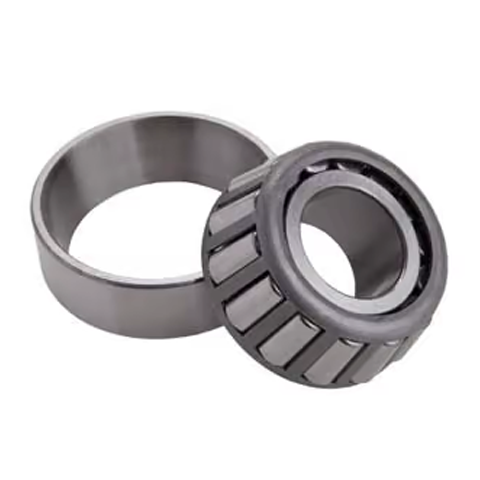
NTN NTN 4T-30305 Single Row Tapered Roller Bearing, D=25mm
NTN 4T-30305 Single Row Tapered Roller Bearing (Inside Dia - 25mm, Outside Dia - 62mm) SPECIFICATIONS Type of Product : Single Row Tapered Roller Bearing Inside Diameter (d) (mm) : 25 Outside Diameter D (mm) : 62 Width Dia mm : 17 Model No : 4T-30305 1. Types, design features, and characteristics Tapered roller bearings are designed so the tapered vertex of the raceway surfaces of the inner and outer rings and rollers converge at one point on the centerline of the bearing (see Fig. 1).The tapered rollers are guided by the compound force of the inner and outer raceway surfaces which keep the rollers pressed up against the large rib on the inner ring.A large variety of these bearings, including single, double, and four row arrangements, are available in both metric and inch series. Each type and associated characteristics are shown in Table 1. For four-row tapered roller bearings, see section “C. Special application bearings.” Table 1 Tapered roller bearing types and characteristics Type Characteristics Single row taperedroller bearings (1) There are both metric and inch series adhering to the standards shown in the following table. Dimension series *Dimension series previously not covered by 3XX are regulated under JIS B 1512; dimensions previously missing from 3XX will henceforth use the bearing number. (2) In addition to the standard design, there are also medium contact angle and large contact angle types, denoted by the contact angle codes at the end of the part numbers (C and D, respectively). (3) Subunits Tapered roller bearings can be disassembled into parts: the inner ring, rollers, and cage (collectively known as the “CONE”) and the outer ring (known as the “CUP”). These are the bearing’s “subunits”. Subunit dimensions are standardized under ISO or ABMA standards, and unified subunits are interchangeable within each dimensional standard. However, high precision grade bearings are generally not interchangeable, and these subunits must be used by assembling only subunits with identical manufacturing numbers.Aside from any cautionary notes that may appear, the single row tapered roller bearings listed in the dimension tables have subunits standardized for both metric and inch systems (including J series). (Refer to Fig. 2) Single row taperedroller bearings (4) These bearings are constructed to have a high capacity for radial loads, axial loads, and combined loads. The larger the contact angle, the greater the axial load capacity. When a pure radial load is applied to a tapered roller bearing, an induced load in the axial direction is also generated, so these bearings are generally used in pairs.(5) Single row tapered roller bearings are separable, so both the inner and outer rings can be used with tight fits. (6) Tapered roller bearings are also manufactured with flanges attached to the outer rings. For more details, contact NTN Engineering. (Refer to Fig. 3) Duplex tapered roller bearings (1) When two single-row tapered roller bearings are to be used in combination, the bearing clearance and preload are adjusted by the inner ring spacer or the outer ring spacer (see Fig. 4).(2) A product number and a combination code are indicated on inner rings, outer rings, and spacers. Parts displaying the same number and code must be used in combination.(3) See A-96 Table 8.14 for the axial internal clearance. Double row taperedroller bearings (1) Back-to-back arrangement (using double row outer rings) and face-to-face arrangement (using double row inner rings) are both available. The assemblies have been adjusted so that each type's internal clearance values are fixed. Only parts with identical manufacturing numbers can be used and they must be assembled according to their code numbers. (Refer to Fig. 5)(2) See A-96 Table 8.14 for the axial internal clearance of double-row and duplex bearings. 2. Standard cage type In general, pressed cages (see Fig. 6) are used in tapered roller bearings. For large sized bearings, machined or pin type cages may also be used, while resin cages may also be used for smaller sized bearings. 3. Allowable misalignment In order to avoid edge loading and potential for premature failure, the maximum allowable misalignment based on bearing series can be found below.The allowable misalignment of combined bearings is influenced by the load center position, so please consult NTN Engineering.• Single row (standard) …………… 1/ 2 000• Single row (ULTAGE) …………… 1/ 600 4. Precautions If bearing load is light during operation, or if the ratio of axial to radial load for duplex and double row bearings exceeds the value of e, slipping may develop between the rollers and raceway surface, sometimes resulting in smearing. The mass of rollers and cages particularly tends to be large for large tapered roller bearings. For additional details, please contact NTN Engineering.In tapered roller bearings, the cage may protrude beyond the inner and/or outer ring side faces. Care should be taken when designing the housing and shaft to ensure contact with the cage does not occur.
$12.54
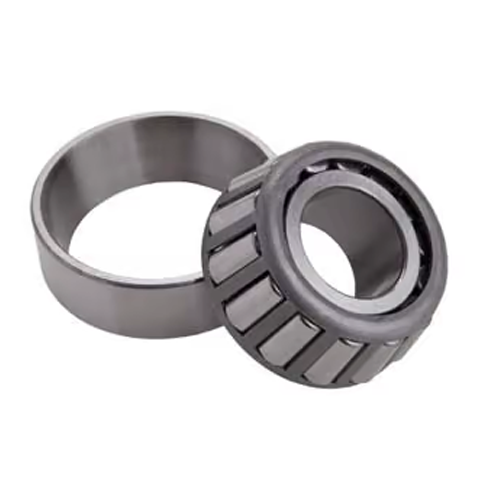
NTN NTN 4T-30304 Single Row Tapered Roller Bearing, D=20mm
NTN 4T-30304 Single Row Tapered Roller Bearing (Inside Dia - 20mm, Outside Dia - 52mm) SPECIFICATIONS Type of Product : Single Row Tapered Roller Bearing Inside Diameter (d) (mm) : 20 Outside Diameter D (mm) : 52 Width Dia mm : 16 Model No : 4T-30304 1. Types, design features, and characteristics Tapered roller bearings are designed so the tapered vertex of the raceway surfaces of the inner and outer rings and rollers converge at one point on the centerline of the bearing (see Fig. 1).The tapered rollers are guided by the compound force of the inner and outer raceway surfaces which keep the rollers pressed up against the large rib on the inner ring.A large variety of these bearings, including single, double, and four row arrangements, are available in both metric and inch series. Each type and associated characteristics are shown in Table 1. For four-row tapered roller bearings, see section “C. Special application bearings.” Table 1 Tapered roller bearing types and characteristics Type Characteristics Single row taperedroller bearings (1) There are both metric and inch series adhering to the standards shown in the following table. Dimension series *Dimension series previously not covered by 3XX are regulated under JIS B 1512; dimensions previously missing from 3XX will henceforth use the bearing number. (2) In addition to the standard design, there are also medium contact angle and large contact angle types, denoted by the contact angle codes at the end of the part numbers (C and D, respectively). (3) Subunits Tapered roller bearings can be disassembled into parts: the inner ring, rollers, and cage (collectively known as the “CONE”) and the outer ring (known as the “CUP”). These are the bearing’s “subunits”. Subunit dimensions are standardized under ISO or ABMA standards, and unified subunits are interchangeable within each dimensional standard. However, high precision grade bearings are generally not interchangeable, and these subunits must be used by assembling only subunits with identical manufacturing numbers.Aside from any cautionary notes that may appear, the single row tapered roller bearings listed in the dimension tables have subunits standardized for both metric and inch systems (including J series). (Refer to Fig. 2) Single row taperedroller bearings (4) These bearings are constructed to have a high capacity for radial loads, axial loads, and combined loads. The larger the contact angle, the greater the axial load capacity. When a pure radial load is applied to a tapered roller bearing, an induced load in the axial direction is also generated, so these bearings are generally used in pairs.(5) Single row tapered roller bearings are separable, so both the inner and outer rings can be used with tight fits. (6) Tapered roller bearings are also manufactured with flanges attached to the outer rings. For more details, contact NTN Engineering. (Refer to Fig. 3) Duplex tapered roller bearings (1) When two single-row tapered roller bearings are to be used in combination, the bearing clearance and preload are adjusted by the inner ring spacer or the outer ring spacer (see Fig. 4).(2) A product number and a combination code are indicated on inner rings, outer rings, and spacers. Parts displaying the same number and code must be used in combination.(3) See A-96 Table 8.14 for the axial internal clearance. Double row taperedroller bearings (1) Back-to-back arrangement (using double row outer rings) and face-to-face arrangement (using double row inner rings) are both available. The assemblies have been adjusted so that each type's internal clearance values are fixed. Only parts with identical manufacturing numbers can be used and they must be assembled according to their code numbers. (Refer to Fig. 5)(2) See A-96 Table 8.14 for the axial internal clearance of double-row and duplex bearings. 2. Standard cage type In general, pressed cages (see Fig. 6) are used in tapered roller bearings. For large sized bearings, machined or pin type cages may also be used, while resin cages may also be used for smaller sized bearings. 3. Allowable misalignment In order to avoid edge loading and potential for premature failure, the maximum allowable misalignment based on bearing series can be found below.The allowable misalignment of combined bearings is influenced by the load center position, so please consult NTN Engineering.• Single row (standard) …………… 1/ 2 000• Single row (ULTAGE) …………… 1/ 600 4. Precautions If bearing load is light during operation, or if the ratio of axial to radial load for duplex and double row bearings exceeds the value of e, slipping may develop between the rollers and raceway surface, sometimes resulting in smearing. The mass of rollers and cages particularly tends to be large for large tapered roller bearings. For additional details, please contact NTN Engineering.In tapered roller bearings, the cage may protrude beyond the inner and/or outer ring side faces. Care should be taken when designing the housing and shaft to ensure contact with the cage does not occur.
$8.02
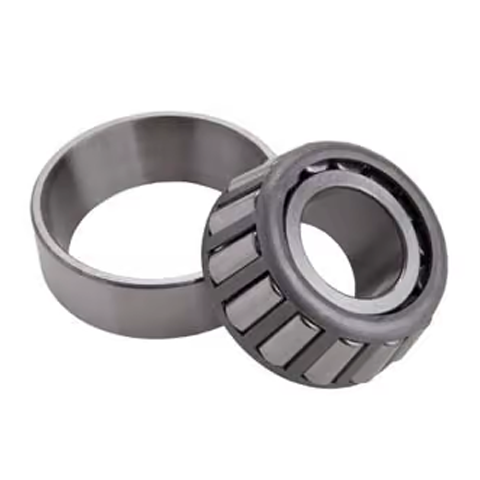
NTN NTN 4T-30303 Single Row Tapered Roller Bearing, D=17mm
NTN 4T-30303 Single Row Tapered Roller Bearing (Inside Dia - 17mm, Outside Dia - 47mm) SPECIFICATIONS Type of Product : Single Row Tapered Roller Bearing Inside Diameter (d) (mm) : 17 Outside Diameter D (mm) : 47 Width Dia mm : 14 Model No : 4T-30303 1. Types, design features, and characteristics Tapered roller bearings are designed so the tapered vertex of the raceway surfaces of the inner and outer rings and rollers converge at one point on the centerline of the bearing (see Fig. 1).The tapered rollers are guided by the compound force of the inner and outer raceway surfaces which keep the rollers pressed up against the large rib on the inner ring.A large variety of these bearings, including single, double, and four row arrangements, are available in both metric and inch series. Each type and associated characteristics are shown in Table 1. For four-row tapered roller bearings, see section “C. Special application bearings.” Table 1 Tapered roller bearing types and characteristics Type Characteristics Single row taperedroller bearings (1) There are both metric and inch series adhering to the standards shown in the following table. Dimension series *Dimension series previously not covered by 3XX are regulated under JIS B 1512; dimensions previously missing from 3XX will henceforth use the bearing number. (2) In addition to the standard design, there are also medium contact angle and large contact angle types, denoted by the contact angle codes at the end of the part numbers (C and D, respectively). (3) Subunits Tapered roller bearings can be disassembled into parts: the inner ring, rollers, and cage (collectively known as the “CONE”) and the outer ring (known as the “CUP”). These are the bearing’s “subunits”. Subunit dimensions are standardized under ISO or ABMA standards, and unified subunits are interchangeable within each dimensional standard. However, high precision grade bearings are generally not interchangeable, and these subunits must be used by assembling only subunits with identical manufacturing numbers.Aside from any cautionary notes that may appear, the single row tapered roller bearings listed in the dimension tables have subunits standardized for both metric and inch systems (including J series). (Refer to Fig. 2) Single row taperedroller bearings (4) These bearings are constructed to have a high capacity for radial loads, axial loads, and combined loads. The larger the contact angle, the greater the axial load capacity. When a pure radial load is applied to a tapered roller bearing, an induced load in the axial direction is also generated, so these bearings are generally used in pairs.(5) Single row tapered roller bearings are separable, so both the inner and outer rings can be used with tight fits. (6) Tapered roller bearings are also manufactured with flanges attached to the outer rings. For more details, contact NTN Engineering. (Refer to Fig. 3) Duplex tapered roller bearings (1) When two single-row tapered roller bearings are to be used in combination, the bearing clearance and preload are adjusted by the inner ring spacer or the outer ring spacer (see Fig. 4).(2) A product number and a combination code are indicated on inner rings, outer rings, and spacers. Parts displaying the same number and code must be used in combination.(3) See A-96 Table 8.14 for the axial internal clearance. Double row taperedroller bearings (1) Back-to-back arrangement (using double row outer rings) and face-to-face arrangement (using double row inner rings) are both available. The assemblies have been adjusted so that each type's internal clearance values are fixed. Only parts with identical manufacturing numbers can be used and they must be assembled according to their code numbers. (Refer to Fig. 5)(2) See A-96 Table 8.14 for the axial internal clearance of double-row and duplex bearings. 2. Standard cage type In general, pressed cages (see Fig. 6) are used in tapered roller bearings. For large sized bearings, machined or pin type cages may also be used, while resin cages may also be used for smaller sized bearings. 3. Allowable misalignment In order to avoid edge loading and potential for premature failure, the maximum allowable misalignment based on bearing series can be found below.The allowable misalignment of combined bearings is influenced by the load center position, so please consult NTN Engineering.• Single row (standard) …………… 1/ 2 000• Single row (ULTAGE) …………… 1/ 600 4. Precautions If bearing load is light during operation, or if the ratio of axial to radial load for duplex and double row bearings exceeds the value of e, slipping may develop between the rollers and raceway surface, sometimes resulting in smearing. The mass of rollers and cages particularly tends to be large for large tapered roller bearings. For additional details, please contact NTN Engineering.In tapered roller bearings, the cage may protrude beyond the inner and/or outer ring side faces. Care should be taken when designing the housing and shaft to ensure contact with the cage does not occur.
$6.94
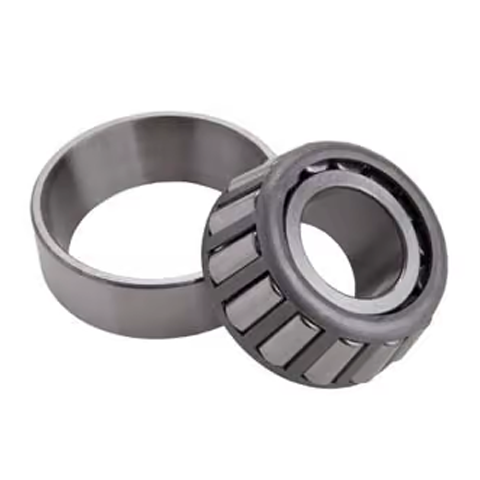
NTN NTN 4T-30302 Single Row Tapered Roller Bearing, D=15mm
NTN 4T-30302 Single Row Tapered Roller Bearing (Inside Dia - 15mm, Outside Dia - 42mm) SPECIFICATIONS Type of Product : Single Row Tapered Roller Bearing Inside Diameter (d) (mm) : 15 Outside Diameter D (mm) : 42 Width Dia mm : 13 Model No : 4T-30302 1. Types, design features, and characteristics Tapered roller bearings are designed so the tapered vertex of the raceway surfaces of the inner and outer rings and rollers converge at one point on the centerline of the bearing (see Fig. 1).The tapered rollers are guided by the compound force of the inner and outer raceway surfaces which keep the rollers pressed up against the large rib on the inner ring.A large variety of these bearings, including single, double, and four row arrangements, are available in both metric and inch series. Each type and associated characteristics are shown in Table 1. For four-row tapered roller bearings, see section “C. Special application bearings.” Table 1 Tapered roller bearing types and characteristics Type Characteristics Single row taperedroller bearings (1) There are both metric and inch series adhering to the standards shown in the following table. Dimension series *Dimension series previously not covered by 3XX are regulated under JIS B 1512; dimensions previously missing from 3XX will henceforth use the bearing number. (2) In addition to the standard design, there are also medium contact angle and large contact angle types, denoted by the contact angle codes at the end of the part numbers (C and D, respectively). (3) Subunits Tapered roller bearings can be disassembled into parts: the inner ring, rollers, and cage (collectively known as the “CONE”) and the outer ring (known as the “CUP”). These are the bearing’s “subunits”. Subunit dimensions are standardized under ISO or ABMA standards, and unified subunits are interchangeable within each dimensional standard. However, high precision grade bearings are generally not interchangeable, and these subunits must be used by assembling only subunits with identical manufacturing numbers.Aside from any cautionary notes that may appear, the single row tapered roller bearings listed in the dimension tables have subunits standardized for both metric and inch systems (including J series). (Refer to Fig. 2) Single row taperedroller bearings (4) These bearings are constructed to have a high capacity for radial loads, axial loads, and combined loads. The larger the contact angle, the greater the axial load capacity. When a pure radial load is applied to a tapered roller bearing, an induced load in the axial direction is also generated, so these bearings are generally used in pairs.(5) Single row tapered roller bearings are separable, so both the inner and outer rings can be used with tight fits. (6) Tapered roller bearings are also manufactured with flanges attached to the outer rings. For more details, contact NTN Engineering. (Refer to Fig. 3) Duplex tapered roller bearings (1) When two single-row tapered roller bearings are to be used in combination, the bearing clearance and preload are adjusted by the inner ring spacer or the outer ring spacer (see Fig. 4).(2) A product number and a combination code are indicated on inner rings, outer rings, and spacers. Parts displaying the same number and code must be used in combination.(3) See A-96 Table 8.14 for the axial internal clearance. Double row taperedroller bearings (1) Back-to-back arrangement (using double row outer rings) and face-to-face arrangement (using double row inner rings) are both available. The assemblies have been adjusted so that each type's internal clearance values are fixed. Only parts with identical manufacturing numbers can be used and they must be assembled according to their code numbers. (Refer to Fig. 5)(2) See A-96 Table 8.14 for the axial internal clearance of double-row and duplex bearings. 2. Standard cage type In general, pressed cages (see Fig. 6) are used in tapered roller bearings. For large sized bearings, machined or pin type cages may also be used, while resin cages may also be used for smaller sized bearings. 3. Allowable misalignment In order to avoid edge loading and potential for premature failure, the maximum allowable misalignment based on bearing series can be found below.The allowable misalignment of combined bearings is influenced by the load center position, so please consult NTN Engineering.• Single row (standard) …………… 1/ 2 000• Single row (ULTAGE) …………… 1/ 600 4. Precautions If bearing load is light during operation, or if the ratio of axial to radial load for duplex and double row bearings exceeds the value of e, slipping may develop between the rollers and raceway surface, sometimes resulting in smearing. The mass of rollers and cages particularly tends to be large for large tapered roller bearings. For additional details, please contact NTN Engineering.In tapered roller bearings, the cage may protrude beyond the inner and/or outer ring side faces. Care should be taken when designing the housing and shaft to ensure contact with the cage does not occur.
$6.73
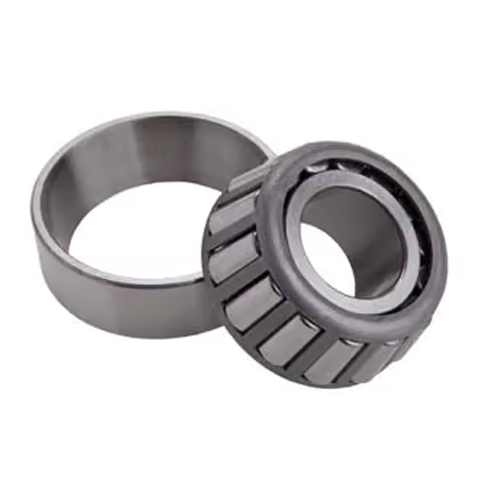
NTN NTN 4T-30215 Single Row Tapered Roller Bearing, D=75mm
NTN 4T-30215 Single Row Tapered Roller Bearing (Inside Dia - 75mm, Outside Dia - 130mm) SPECIFICATIONS Type of Product : Single Row Tapered Roller Bearing Inside Diameter (d) (mm) : 75 Outside Diameter D (mm) : 130 Width Dia mm : 25 Model No : 4T-30215 1. Types, design features, and characteristics Tapered roller bearings are designed so the tapered vertex of the raceway surfaces of the inner and outer rings and rollers converge at one point on the centerline of the bearing (see Fig. 1).The tapered rollers are guided by the compound force of the inner and outer raceway surfaces which keep the rollers pressed up against the large rib on the inner ring.A large variety of these bearings, including single, double, and four row arrangements, are available in both metric and inch series. Each type and associated characteristics are shown in Table 1. For four-row tapered roller bearings, see section “C. Special application bearings.” Table 1 Tapered roller bearing types and characteristics Type Characteristics Single row taperedroller bearings (1) There are both metric and inch series adhering to the standards shown in the following table. Dimension series *Dimension series previously not covered by 3XX are regulated under JIS B 1512; dimensions previously missing from 3XX will henceforth use the bearing number. (2) In addition to the standard design, there are also medium contact angle and large contact angle types, denoted by the contact angle codes at the end of the part numbers (C and D, respectively). (3) Subunits Tapered roller bearings can be disassembled into parts: the inner ring, rollers, and cage (collectively known as the “CONE”) and the outer ring (known as the “CUP”). These are the bearing’s “subunits”. Subunit dimensions are standardized under ISO or ABMA standards, and unified subunits are interchangeable within each dimensional standard. However, high precision grade bearings are generally not interchangeable, and these subunits must be used by assembling only subunits with identical manufacturing numbers.Aside from any cautionary notes that may appear, the single row tapered roller bearings listed in the dimension tables have subunits standardized for both metric and inch systems (including J series). (Refer to Fig. 2) Single row taperedroller bearings (4) These bearings are constructed to have a high capacity for radial loads, axial loads, and combined loads. The larger the contact angle, the greater the axial load capacity. When a pure radial load is applied to a tapered roller bearing, an induced load in the axial direction is also generated, so these bearings are generally used in pairs.(5) Single row tapered roller bearings are separable, so both the inner and outer rings can be used with tight fits. (6) Tapered roller bearings are also manufactured with flanges attached to the outer rings. For more details, contact NTN Engineering. (Refer to Fig. 3) Duplex tapered roller bearings (1) When two single-row tapered roller bearings are to be used in combination, the bearing clearance and preload are adjusted by the inner ring spacer or the outer ring spacer (see Fig. 4).(2) A product number and a combination code are indicated on inner rings, outer rings, and spacers. Parts displaying the same number and code must be used in combination.(3) See A-96 Table 8.14 for the axial internal clearance. Double row taperedroller bearings (1) Back-to-back arrangement (using double row outer rings) and face-to-face arrangement (using double row inner rings) are both available. The assemblies have been adjusted so that each type's internal clearance values are fixed. Only parts with identical manufacturing numbers can be used and they must be assembled according to their code numbers. (Refer to Fig. 5)(2) See A-96 Table 8.14 for the axial internal clearance of double-row and duplex bearings. 2. Standard cage type In general, pressed cages (see Fig. 6) are used in tapered roller bearings. For large sized bearings, machined or pin type cages may also be used, while resin cages may also be used for smaller sized bearings. 3. Allowable misalignment In order to avoid edge loading and potential for premature failure, the maximum allowable misalignment based on bearing series can be found below.The allowable misalignment of combined bearings is influenced by the load center position, so please consult NTN Engineering.• Single row (standard) …………… 1/ 2 000• Single row (ULTAGE) …………… 1/ 600 4. Precautions If bearing load is light during operation, or if the ratio of axial to radial load for duplex and double row bearings exceeds the value of e, slipping may develop between the rollers and raceway surface, sometimes resulting in smearing. The mass of rollers and cages particularly tends to be large for large tapered roller bearings. For additional details, please contact NTN Engineering.In tapered roller bearings, the cage may protrude beyond the inner and/or outer ring side faces. Care should be taken when designing the housing and shaft to ensure contact with the cage does not occur.
$37.14
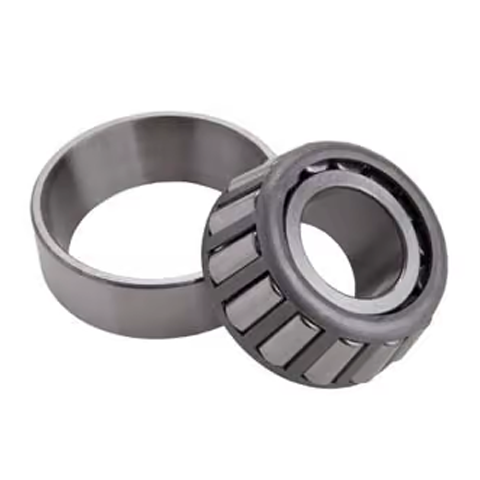
NTN NTN 4T-30214 Single Row Tapered Roller Bearing, D=70mm
NTN 4T-30214 Single Row Tapered Roller Bearing (Inside Dia - 70mm, Outside Dia - 125mm) SPECIFICATIONS Type of Product : Single Row Tapered Roller Bearing Inside Diameter (d) (mm) : 70 Outside Diameter D (mm) : 125 Width Dia mm : 28.1 Model No : 4T-30214 1. Types, design features, and characteristics Tapered roller bearings are designed so the tapered vertex of the raceway surfaces of the inner and outer rings and rollers converge at one point on the centerline of the bearing (see Fig. 1).The tapered rollers are guided by the compound force of the inner and outer raceway surfaces which keep the rollers pressed up against the large rib on the inner ring.A large variety of these bearings, including single, double, and four row arrangements, are available in both metric and inch series. Each type and associated characteristics are shown in Table 1. For four-row tapered roller bearings, see section “C. Special application bearings.” Table 1 Tapered roller bearing types and characteristics Type Characteristics Single row taperedroller bearings (1) There are both metric and inch series adhering to the standards shown in the following table. Dimension series *Dimension series previously not covered by 3XX are regulated under JIS B 1512; dimensions previously missing from 3XX will henceforth use the bearing number. (2) In addition to the standard design, there are also medium contact angle and large contact angle types, denoted by the contact angle codes at the end of the part numbers (C and D, respectively). (3) Subunits Tapered roller bearings can be disassembled into parts: the inner ring, rollers, and cage (collectively known as the “CONE”) and the outer ring (known as the “CUP”). These are the bearing’s “subunits”. Subunit dimensions are standardized under ISO or ABMA standards, and unified subunits are interchangeable within each dimensional standard. However, high precision grade bearings are generally not interchangeable, and these subunits must be used by assembling only subunits with identical manufacturing numbers.Aside from any cautionary notes that may appear, the single row tapered roller bearings listed in the dimension tables have subunits standardized for both metric and inch systems (including J series). (Refer to Fig. 2) Single row taperedroller bearings (4) These bearings are constructed to have a high capacity for radial loads, axial loads, and combined loads. The larger the contact angle, the greater the axial load capacity. When a pure radial load is applied to a tapered roller bearing, an induced load in the axial direction is also generated, so these bearings are generally used in pairs.(5) Single row tapered roller bearings are separable, so both the inner and outer rings can be used with tight fits. (6) Tapered roller bearings are also manufactured with flanges attached to the outer rings. For more details, contact NTN Engineering. (Refer to Fig. 3) Duplex tapered roller bearings (1) When two single-row tapered roller bearings are to be used in combination, the bearing clearance and preload are adjusted by the inner ring spacer or the outer ring spacer (see Fig. 4).(2) A product number and a combination code are indicated on inner rings, outer rings, and spacers. Parts displaying the same number and code must be used in combination.(3) See A-96 Table 8.14 for the axial internal clearance. Double row taperedroller bearings (1) Back-to-back arrangement (using double row outer rings) and face-to-face arrangement (using double row inner rings) are both available. The assemblies have been adjusted so that each type's internal clearance values are fixed. Only parts with identical manufacturing numbers can be used and they must be assembled according to their code numbers. (Refer to Fig. 5)(2) See A-96 Table 8.14 for the axial internal clearance of double-row and duplex bearings. 2. Standard cage type In general, pressed cages (see Fig. 6) are used in tapered roller bearings. For large sized bearings, machined or pin type cages may also be used, while resin cages may also be used for smaller sized bearings. 3. Allowable misalignment In order to avoid edge loading and potential for premature failure, the maximum allowable misalignment based on bearing series can be found below.The allowable misalignment of combined bearings is influenced by the load center position, so please consult NTN Engineering.• Single row (standard) …………… 1/ 2 000• Single row (ULTAGE) …………… 1/ 600 4. Precautions If bearing load is light during operation, or if the ratio of axial to radial load for duplex and double row bearings exceeds the value of e, slipping may develop between the rollers and raceway surface, sometimes resulting in smearing. The mass of rollers and cages particularly tends to be large for large tapered roller bearings. For additional details, please contact NTN Engineering.In tapered roller bearings, the cage may protrude beyond the inner and/or outer ring side faces. Care should be taken when designing the housing and shaft to ensure contact with the cage does not occur.
$38.94
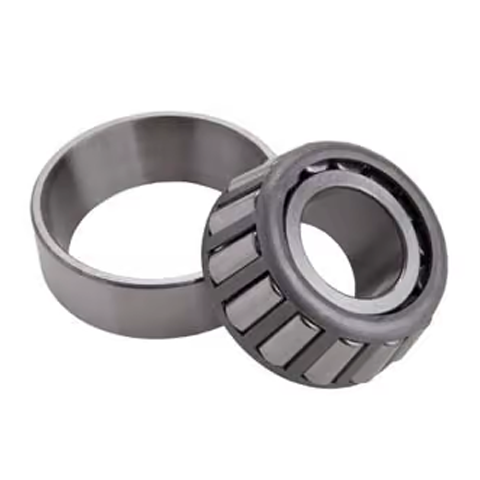
NTN NTN 4T-30211 Single Row Tapered Roller Bearing, D=55mm
NTN 4T-30211 Single Row Tapered Roller Bearing (Inside Dia - 55mm, Outside Dia - 100mm) SPECIFICATIONS Type of Product : Single Row Tapered Roller Bearing Inside Diameter (d) (mm) : 55 Outside Diameter D (mm) : 100 Width Dia mm : 21 Model No : 4T-30211 1. Types, design features, and characteristics Tapered roller bearings are designed so the tapered vertex of the raceway surfaces of the inner and outer rings and rollers converge at one point on the centerline of the bearing (see Fig. 1).The tapered rollers are guided by the compound force of the inner and outer raceway surfaces which keep the rollers pressed up against the large rib on the inner ring.A large variety of these bearings, including single, double, and four row arrangements, are available in both metric and inch series. Each type and associated characteristics are shown in Table 1. For four-row tapered roller bearings, see section “C. Special application bearings.” Table 1 Tapered roller bearing types and characteristics Type Characteristics Single row taperedroller bearings (1) There are both metric and inch series adhering to the standards shown in the following table. Dimension series *Dimension series previously not covered by 3XX are regulated under JIS B 1512; dimensions previously missing from 3XX will henceforth use the bearing number. (2) In addition to the standard design, there are also medium contact angle and large contact angle types, denoted by the contact angle codes at the end of the part numbers (C and D, respectively). (3) Subunits Tapered roller bearings can be disassembled into parts: the inner ring, rollers, and cage (collectively known as the “CONE”) and the outer ring (known as the “CUP”). These are the bearing’s “subunits”. Subunit dimensions are standardized under ISO or ABMA standards, and unified subunits are interchangeable within each dimensional standard. However, high precision grade bearings are generally not interchangeable, and these subunits must be used by assembling only subunits with identical manufacturing numbers.Aside from any cautionary notes that may appear, the single row tapered roller bearings listed in the dimension tables have subunits standardized for both metric and inch systems (including J series). (Refer to Fig. 2) Single row taperedroller bearings (4) These bearings are constructed to have a high capacity for radial loads, axial loads, and combined loads. The larger the contact angle, the greater the axial load capacity. When a pure radial load is applied to a tapered roller bearing, an induced load in the axial direction is also generated, so these bearings are generally used in pairs.(5) Single row tapered roller bearings are separable, so both the inner and outer rings can be used with tight fits. (6) Tapered roller bearings are also manufactured with flanges attached to the outer rings. For more details, contact NTN Engineering. (Refer to Fig. 3) Duplex tapered roller bearings (1) When two single-row tapered roller bearings are to be used in combination, the bearing clearance and preload are adjusted by the inner ring spacer or the outer ring spacer (see Fig. 4).(2) A product number and a combination code are indicated on inner rings, outer rings, and spacers. Parts displaying the same number and code must be used in combination.(3) See A-96 Table 8.14 for the axial internal clearance. Double row taperedroller bearings (1) Back-to-back arrangement (using double row outer rings) and face-to-face arrangement (using double row inner rings) are both available. The assemblies have been adjusted so that each type's internal clearance values are fixed. Only parts with identical manufacturing numbers can be used and they must be assembled according to their code numbers. (Refer to Fig. 5)(2) See A-96 Table 8.14 for the axial internal clearance of double-row and duplex bearings. 2. Standard cage type In general, pressed cages (see Fig. 6) are used in tapered roller bearings. For large sized bearings, machined or pin type cages may also be used, while resin cages may also be used for smaller sized bearings. 3. Allowable misalignment In order to avoid edge loading and potential for premature failure, the maximum allowable misalignment based on bearing series can be found below.The allowable misalignment of combined bearings is influenced by the load center position, so please consult NTN Engineering.• Single row (standard) …………… 1/ 2 000• Single row (ULTAGE) …………… 1/ 600 4. Precautions If bearing load is light during operation, or if the ratio of axial to radial load for duplex and double row bearings exceeds the value of e, slipping may develop between the rollers and raceway surface, sometimes resulting in smearing. The mass of rollers and cages particularly tends to be large for large tapered roller bearings. For additional details, please contact NTN Engineering.In tapered roller bearings, the cage may protrude beyond the inner and/or outer ring side faces. Care should be taken when designing the housing and shaft to ensure contact with the cage does not occur.
$23.42
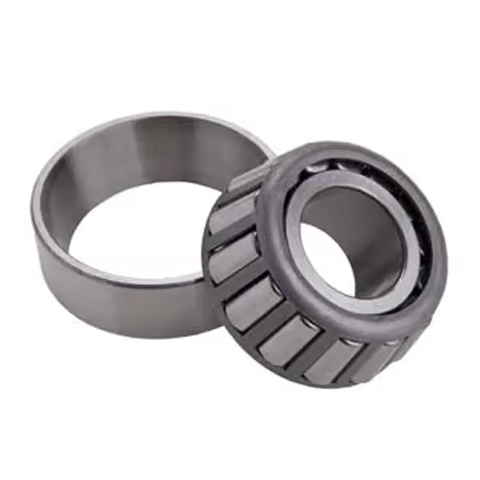
NTN NTN 4T-30210 Single Row Tapered Roller Bearing, D=50mm
NTN 4T-30210 Single Row Tapered Roller Bearing (Inside Dia - 50mm, Outside Dia - 90mm) SPECIFICATIONS Type of Product : Single Row Tapered Roller Bearing Inside Diameter (d) (mm) : 50 Outside Diameter D (mm) : 90 Width Dia mm : 20 Model No : 4T-30210 1. Types, design features, and characteristics Tapered roller bearings are designed so the tapered vertex of the raceway surfaces of the inner and outer rings and rollers converge at one point on the centerline of the bearing (see Fig. 1).The tapered rollers are guided by the compound force of the inner and outer raceway surfaces which keep the rollers pressed up against the large rib on the inner ring.A large variety of these bearings, including single, double, and four row arrangements, are available in both metric and inch series. Each type and associated characteristics are shown in Table 1. For four-row tapered roller bearings, see section “C. Special application bearings.” Table 1 Tapered roller bearing types and characteristics Type Characteristics Single row taperedroller bearings (1) There are both metric and inch series adhering to the standards shown in the following table. Dimension series *Dimension series previously not covered by 3XX are regulated under JIS B 1512; dimensions previously missing from 3XX will henceforth use the bearing number. (2) In addition to the standard design, there are also medium contact angle and large contact angle types, denoted by the contact angle codes at the end of the part numbers (C and D, respectively). (3) Subunits Tapered roller bearings can be disassembled into parts: the inner ring, rollers, and cage (collectively known as the “CONE”) and the outer ring (known as the “CUP”). These are the bearing’s “subunits”. Subunit dimensions are standardized under ISO or ABMA standards, and unified subunits are interchangeable within each dimensional standard. However, high precision grade bearings are generally not interchangeable, and these subunits must be used by assembling only subunits with identical manufacturing numbers.Aside from any cautionary notes that may appear, the single row tapered roller bearings listed in the dimension tables have subunits standardized for both metric and inch systems (including J series). (Refer to Fig. 2) Single row taperedroller bearings (4) These bearings are constructed to have a high capacity for radial loads, axial loads, and combined loads. The larger the contact angle, the greater the axial load capacity. When a pure radial load is applied to a tapered roller bearing, an induced load in the axial direction is also generated, so these bearings are generally used in pairs.(5) Single row tapered roller bearings are separable, so both the inner and outer rings can be used with tight fits. (6) Tapered roller bearings are also manufactured with flanges attached to the outer rings. For more details, contact NTN Engineering. (Refer to Fig. 3) Duplex tapered roller bearings (1) When two single-row tapered roller bearings are to be used in combination, the bearing clearance and preload are adjusted by the inner ring spacer or the outer ring spacer (see Fig. 4).(2) A product number and a combination code are indicated on inner rings, outer rings, and spacers. Parts displaying the same number and code must be used in combination.(3) See A-96 Table 8.14 for the axial internal clearance. Double row taperedroller bearings (1) Back-to-back arrangement (using double row outer rings) and face-to-face arrangement (using double row inner rings) are both available. The assemblies have been adjusted so that each type's internal clearance values are fixed. Only parts with identical manufacturing numbers can be used and they must be assembled according to their code numbers. (Refer to Fig. 5)(2) See A-96 Table 8.14 for the axial internal clearance of double-row and duplex bearings. 2. Standard cage type In general, pressed cages (see Fig. 6) are used in tapered roller bearings. For large sized bearings, machined or pin type cages may also be used, while resin cages may also be used for smaller sized bearings. 3. Allowable misalignment In order to avoid edge loading and potential for premature failure, the maximum allowable misalignment based on bearing series can be found below.The allowable misalignment of combined bearings is influenced by the load center position, so please consult NTN Engineering.• Single row (standard) …………… 1/ 2 000• Single row (ULTAGE) …………… 1/ 600 4. Precautions If bearing load is light during operation, or if the ratio of axial to radial load for duplex and double row bearings exceeds the value of e, slipping may develop between the rollers and raceway surface, sometimes resulting in smearing. The mass of rollers and cages particularly tends to be large for large tapered roller bearings. For additional details, please contact NTN Engineering.In tapered roller bearings, the cage may protrude beyond the inner and/or outer ring side faces. Care should be taken when designing the housing and shaft to ensure contact with the cage does not occur.
$19.08
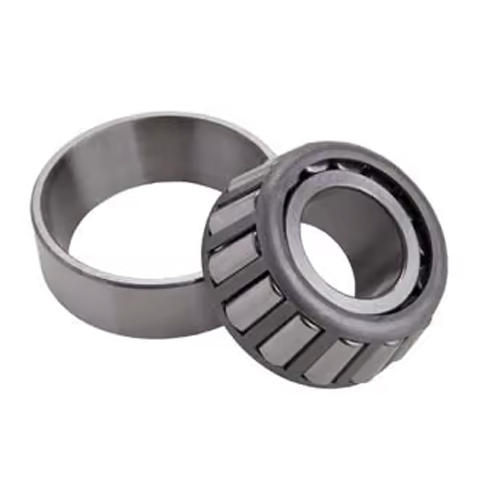
NTN NTN 4T-30209 Single Row Tapered Roller Bearing, D=45mm
NTN 4T-30209 Single Row Tapered Roller Bearing (Inside Dia - 45mm, Outside Dia - 85mm) SPECIFICATIONS Type of Product : Single Row Tapered Roller Bearing Inside Diameter (d) (mm) : 45 Outside Diameter D (mm) : 85 Width Dia mm : 19 Model No : 4T-30209 1. Types, design features, and characteristics Tapered roller bearings are designed so the tapered vertex of the raceway surfaces of the inner and outer rings and rollers converge at one point on the centerline of the bearing (see Fig. 1).The tapered rollers are guided by the compound force of the inner and outer raceway surfaces which keep the rollers pressed up against the large rib on the inner ring.A large variety of these bearings, including single, double, and four row arrangements, are available in both metric and inch series. Each type and associated characteristics are shown in Table 1. For four-row tapered roller bearings, see section “C. Special application bearings.” Table 1 Tapered roller bearing types and characteristics Type Characteristics Single row taperedroller bearings (1) There are both metric and inch series adhering to the standards shown in the following table. Dimension series *Dimension series previously not covered by 3XX are regulated under JIS B 1512; dimensions previously missing from 3XX will henceforth use the bearing number. (2) In addition to the standard design, there are also medium contact angle and large contact angle types, denoted by the contact angle codes at the end of the part numbers (C and D, respectively). (3) Subunits Tapered roller bearings can be disassembled into parts: the inner ring, rollers, and cage (collectively known as the “CONE”) and the outer ring (known as the “CUP”). These are the bearing’s “subunits”. Subunit dimensions are standardized under ISO or ABMA standards, and unified subunits are interchangeable within each dimensional standard. However, high precision grade bearings are generally not interchangeable, and these subunits must be used by assembling only subunits with identical manufacturing numbers.Aside from any cautionary notes that may appear, the single row tapered roller bearings listed in the dimension tables have subunits standardized for both metric and inch systems (including J series). (Refer to Fig. 2) Single row taperedroller bearings (4) These bearings are constructed to have a high capacity for radial loads, axial loads, and combined loads. The larger the contact angle, the greater the axial load capacity. When a pure radial load is applied to a tapered roller bearing, an induced load in the axial direction is also generated, so these bearings are generally used in pairs.(5) Single row tapered roller bearings are separable, so both the inner and outer rings can be used with tight fits. (6) Tapered roller bearings are also manufactured with flanges attached to the outer rings. For more details, contact NTN Engineering. (Refer to Fig. 3) Duplex tapered roller bearings (1) When two single-row tapered roller bearings are to be used in combination, the bearing clearance and preload are adjusted by the inner ring spacer or the outer ring spacer (see Fig. 4).(2) A product number and a combination code are indicated on inner rings, outer rings, and spacers. Parts displaying the same number and code must be used in combination.(3) See A-96 Table 8.14 for the axial internal clearance. Double row taperedroller bearings (1) Back-to-back arrangement (using double row outer rings) and face-to-face arrangement (using double row inner rings) are both available. The assemblies have been adjusted so that each type's internal clearance values are fixed. Only parts with identical manufacturing numbers can be used and they must be assembled according to their code numbers. (Refer to Fig. 5)(2) See A-96 Table 8.14 for the axial internal clearance of double-row and duplex bearings. 2. Standard cage type In general, pressed cages (see Fig. 6) are used in tapered roller bearings. For large sized bearings, machined or pin type cages may also be used, while resin cages may also be used for smaller sized bearings. 3. Allowable misalignment In order to avoid edge loading and potential for premature failure, the maximum allowable misalignment based on bearing series can be found below.The allowable misalignment of combined bearings is influenced by the load center position, so please consult NTN Engineering.• Single row (standard) …………… 1/ 2 000• Single row (ULTAGE) …………… 1/ 600 4. Precautions If bearing load is light during operation, or if the ratio of axial to radial load for duplex and double row bearings exceeds the value of e, slipping may develop between the rollers and raceway surface, sometimes resulting in smearing. The mass of rollers and cages particularly tends to be large for large tapered roller bearings. For additional details, please contact NTN Engineering.In tapered roller bearings, the cage may protrude beyond the inner and/or outer ring side faces. Care should be taken when designing the housing and shaft to ensure contact with the cage does not occur.
$18.06
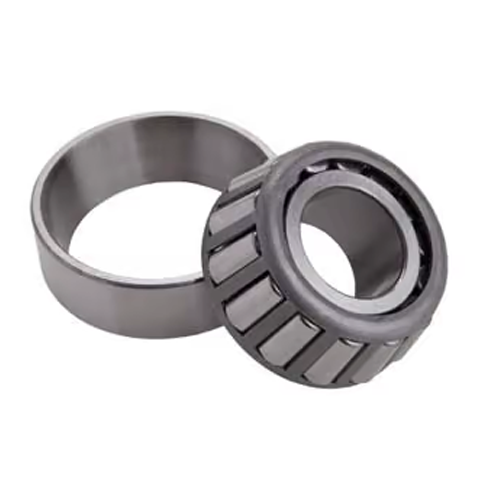
NTN NTN 4T-30207 Single Row Tapered Roller Bearing, D=35mm
NTN 4T-30207 Single Row Tapered Roller Bearing (Inside Dia - 35mm, Outside Dia - 72mm) SPECIFICATIONS Type of Product : Single Row Tapered Roller Bearing Inside Diameter (d) (mm) : 35 Outside Diameter D (mm) : 72 Width Dia mm : 17 Model No : 4T-30207 1. Types, design features, and characteristics Tapered roller bearings are designed so the tapered vertex of the raceway surfaces of the inner and outer rings and rollers converge at one point on the centerline of the bearing (see Fig. 1).The tapered rollers are guided by the compound force of the inner and outer raceway surfaces which keep the rollers pressed up against the large rib on the inner ring.A large variety of these bearings, including single, double, and four row arrangements, are available in both metric and inch series. Each type and associated characteristics are shown in Table 1. For four-row tapered roller bearings, see section “C. Special application bearings.” Table 1 Tapered roller bearing types and characteristics Type Characteristics Single row taperedroller bearings (1) There are both metric and inch series adhering to the standards shown in the following table. Dimension series *Dimension series previously not covered by 3XX are regulated under JIS B 1512; dimensions previously missing from 3XX will henceforth use the bearing number. (2) In addition to the standard design, there are also medium contact angle and large contact angle types, denoted by the contact angle codes at the end of the part numbers (C and D, respectively). (3) Subunits Tapered roller bearings can be disassembled into parts: the inner ring, rollers, and cage (collectively known as the “CONE”) and the outer ring (known as the “CUP”). These are the bearing’s “subunits”. Subunit dimensions are standardized under ISO or ABMA standards, and unified subunits are interchangeable within each dimensional standard. However, high precision grade bearings are generally not interchangeable, and these subunits must be used by assembling only subunits with identical manufacturing numbers.Aside from any cautionary notes that may appear, the single row tapered roller bearings listed in the dimension tables have subunits standardized for both metric and inch systems (including J series). (Refer to Fig. 2) Single row taperedroller bearings (4) These bearings are constructed to have a high capacity for radial loads, axial loads, and combined loads. The larger the contact angle, the greater the axial load capacity. When a pure radial load is applied to a tapered roller bearing, an induced load in the axial direction is also generated, so these bearings are generally used in pairs.(5) Single row tapered roller bearings are separable, so both the inner and outer rings can be used with tight fits. (6) Tapered roller bearings are also manufactured with flanges attached to the outer rings. For more details, contact NTN Engineering. (Refer to Fig. 3) Duplex tapered roller bearings (1) When two single-row tapered roller bearings are to be used in combination, the bearing clearance and preload are adjusted by the inner ring spacer or the outer ring spacer (see Fig. 4).(2) A product number and a combination code are indicated on inner rings, outer rings, and spacers. Parts displaying the same number and code must be used in combination.(3) See A-96 Table 8.14 for the axial internal clearance. Double row taperedroller bearings (1) Back-to-back arrangement (using double row outer rings) and face-to-face arrangement (using double row inner rings) are both available. The assemblies have been adjusted so that each type's internal clearance values are fixed. Only parts with identical manufacturing numbers can be used and they must be assembled according to their code numbers. (Refer to Fig. 5)(2) See A-96 Table 8.14 for the axial internal clearance of double-row and duplex bearings. 2. Standard cage type In general, pressed cages (see Fig. 6) are used in tapered roller bearings. For large sized bearings, machined or pin type cages may also be used, while resin cages may also be used for smaller sized bearings. 3. Allowable misalignment In order to avoid edge loading and potential for premature failure, the maximum allowable misalignment based on bearing series can be found below.The allowable misalignment of combined bearings is influenced by the load center position, so please consult NTN Engineering.• Single row (standard) …………… 1/ 2 000• Single row (ULTAGE) …………… 1/ 600 4. Precautions If bearing load is light during operation, or if the ratio of axial to radial load for duplex and double row bearings exceeds the value of e, slipping may develop between the rollers and raceway surface, sometimes resulting in smearing. The mass of rollers and cages particularly tends to be large for large tapered roller bearings. For additional details, please contact NTN Engineering.In tapered roller bearings, the cage may protrude beyond the inner and/or outer ring side faces. Care should be taken when designing the housing and shaft to ensure contact with the cage does not occur.
$13.66
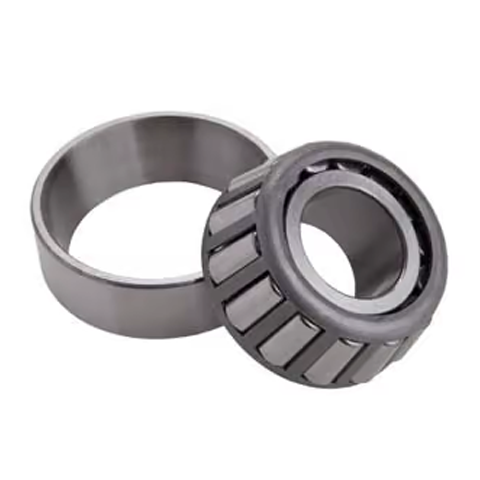
NTN NTN 4T-30204 Single Row Tapered Roller Bearing, D=20mm
NTN 4T-30204 Single Row Tapered Roller Bearing (Inside Dia - 20mm, Outside Dia - 47mm) SPECIFICATIONS Type of Product : Single Row Tapered Roller Bearing Inside Diameter (d) (mm) : 20 Outside Diameter D (mm) : 47 Width Dia mm : 14 Model No : 4T-30204 1. Types, design features, and characteristics Tapered roller bearings are designed so the tapered vertex of the raceway surfaces of the inner and outer rings and rollers converge at one point on the centerline of the bearing (see Fig. 1).The tapered rollers are guided by the compound force of the inner and outer raceway surfaces which keep the rollers pressed up against the large rib on the inner ring.A large variety of these bearings, including single, double, and four row arrangements, are available in both metric and inch series. Each type and associated characteristics are shown in Table 1. For four-row tapered roller bearings, see section “C. Special application bearings.” Table 1 Tapered roller bearing types and characteristics Type Characteristics Single row taperedroller bearings (1) There are both metric and inch series adhering to the standards shown in the following table. Dimension series *Dimension series previously not covered by 3XX are regulated under JIS B 1512; dimensions previously missing from 3XX will henceforth use the bearing number. (2) In addition to the standard design, there are also medium contact angle and large contact angle types, denoted by the contact angle codes at the end of the part numbers (C and D, respectively). (3) Subunits Tapered roller bearings can be disassembled into parts: the inner ring, rollers, and cage (collectively known as the “CONE”) and the outer ring (known as the “CUP”). These are the bearing’s “subunits”. Subunit dimensions are standardized under ISO or ABMA standards, and unified subunits are interchangeable within each dimensional standard. However, high precision grade bearings are generally not interchangeable, and these subunits must be used by assembling only subunits with identical manufacturing numbers.Aside from any cautionary notes that may appear, the single row tapered roller bearings listed in the dimension tables have subunits standardized for both metric and inch systems (including J series). (Refer to Fig. 2) Single row taperedroller bearings (4) These bearings are constructed to have a high capacity for radial loads, axial loads, and combined loads. The larger the contact angle, the greater the axial load capacity. When a pure radial load is applied to a tapered roller bearing, an induced load in the axial direction is also generated, so these bearings are generally used in pairs.(5) Single row tapered roller bearings are separable, so both the inner and outer rings can be used with tight fits. (6) Tapered roller bearings are also manufactured with flanges attached to the outer rings. For more details, contact NTN Engineering. (Refer to Fig. 3) Duplex tapered roller bearings (1) When two single-row tapered roller bearings are to be used in combination, the bearing clearance and preload are adjusted by the inner ring spacer or the outer ring spacer (see Fig. 4).(2) A product number and a combination code are indicated on inner rings, outer rings, and spacers. Parts displaying the same number and code must be used in combination.(3) See A-96 Table 8.14 for the axial internal clearance. Double row taperedroller bearings (1) Back-to-back arrangement (using double row outer rings) and face-to-face arrangement (using double row inner rings) are both available. The assemblies have been adjusted so that each type's internal clearance values are fixed. Only parts with identical manufacturing numbers can be used and they must be assembled according to their code numbers. (Refer to Fig. 5)(2) See A-96 Table 8.14 for the axial internal clearance of double-row and duplex bearings. 2. Standard cage type In general, pressed cages (see Fig. 6) are used in tapered roller bearings. For large sized bearings, machined or pin type cages may also be used, while resin cages may also be used for smaller sized bearings. 3. Allowable misalignment In order to avoid edge loading and potential for premature failure, the maximum allowable misalignment based on bearing series can be found below.The allowable misalignment of combined bearings is influenced by the load center position, so please consult NTN Engineering.• Single row (standard) …………… 1/ 2 000• Single row (ULTAGE) …………… 1/ 600 4. Precautions If bearing load is light during operation, or if the ratio of axial to radial load for duplex and double row bearings exceeds the value of e, slipping may develop between the rollers and raceway surface, sometimes resulting in smearing. The mass of rollers and cages particularly tends to be large for large tapered roller bearings. For additional details, please contact NTN Engineering.In tapered roller bearings, the cage may protrude beyond the inner and/or outer ring side faces. Care should be taken when designing the housing and shaft to ensure contact with the cage does not occur.
$9.14
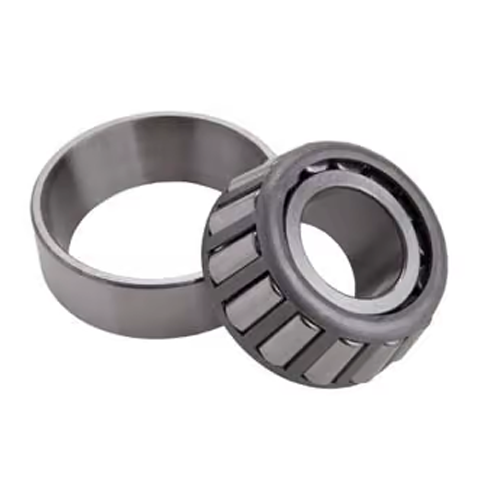
NTN NTN 4T-30203 Single Row Tapered Roller Bearing, D=17mm
NTN 4T-30203 Single Row Tapered Roller Bearing (Inside Dia - 17mm, Outside Dia - 40mm) SPECIFICATIONS Type of Product : Single Row Tapered Roller Bearing Inside Diameter (d) (mm) : 17 Outside Diameter D (mm) : 40 Width Dia mm : 12 Model No : 4T-30203 1. Types, design features, and characteristics Tapered roller bearings are designed so the tapered vertex of the raceway surfaces of the inner and outer rings and rollers converge at one point on the centerline of the bearing (see Fig. 1).The tapered rollers are guided by the compound force of the inner and outer raceway surfaces which keep the rollers pressed up against the large rib on the inner ring.A large variety of these bearings, including single, double, and four row arrangements, are available in both metric and inch series. Each type and associated characteristics are shown in Table 1. For four-row tapered roller bearings, see section “C. Special application bearings.” Table 1 Tapered roller bearing types and characteristics Type Characteristics Single row taperedroller bearings (1) There are both metric and inch series adhering to the standards shown in the following table. Dimension series *Dimension series previously not covered by 3XX are regulated under JIS B 1512; dimensions previously missing from 3XX will henceforth use the bearing number. (2) In addition to the standard design, there are also medium contact angle and large contact angle types, denoted by the contact angle codes at the end of the part numbers (C and D, respectively). (3) Subunits Tapered roller bearings can be disassembled into parts: the inner ring, rollers, and cage (collectively known as the “CONE”) and the outer ring (known as the “CUP”). These are the bearing’s “subunits”. Subunit dimensions are standardized under ISO or ABMA standards, and unified subunits are interchangeable within each dimensional standard. However, high precision grade bearings are generally not interchangeable, and these subunits must be used by assembling only subunits with identical manufacturing numbers.Aside from any cautionary notes that may appear, the single row tapered roller bearings listed in the dimension tables have subunits standardized for both metric and inch systems (including J series). (Refer to Fig. 2) Single row taperedroller bearings (4) These bearings are constructed to have a high capacity for radial loads, axial loads, and combined loads. The larger the contact angle, the greater the axial load capacity. When a pure radial load is applied to a tapered roller bearing, an induced load in the axial direction is also generated, so these bearings are generally used in pairs.(5) Single row tapered roller bearings are separable, so both the inner and outer rings can be used with tight fits. (6) Tapered roller bearings are also manufactured with flanges attached to the outer rings. For more details, contact NTN Engineering. (Refer to Fig. 3) Duplex tapered roller bearings (1) When two single-row tapered roller bearings are to be used in combination, the bearing clearance and preload are adjusted by the inner ring spacer or the outer ring spacer (see Fig. 4).(2) A product number and a combination code are indicated on inner rings, outer rings, and spacers. Parts displaying the same number and code must be used in combination.(3) See A-96 Table 8.14 for the axial internal clearance. Double row taperedroller bearings (1) Back-to-back arrangement (using double row outer rings) and face-to-face arrangement (using double row inner rings) are both available. The assemblies have been adjusted so that each type's internal clearance values are fixed. Only parts with identical manufacturing numbers can be used and they must be assembled according to their code numbers. (Refer to Fig. 5)(2) See A-96 Table 8.14 for the axial internal clearance of double-row and duplex bearings. 2. Standard cage type In general, pressed cages (see Fig. 6) are used in tapered roller bearings. For large sized bearings, machined or pin type cages may also be used, while resin cages may also be used for smaller sized bearings. 3. Allowable misalignment In order to avoid edge loading and potential for premature failure, the maximum allowable misalignment based on bearing series can be found below.The allowable misalignment of combined bearings is influenced by the load center position, so please consult NTN Engineering.• Single row (standard) …………… 1/ 2 000• Single row (ULTAGE) …………… 1/ 600 4. Precautions If bearing load is light during operation, or if the ratio of axial to radial load for duplex and double row bearings exceeds the value of e, slipping may develop between the rollers and raceway surface, sometimes resulting in smearing. The mass of rollers and cages particularly tends to be large for large tapered roller bearings. For additional details, please contact NTN Engineering.In tapered roller bearings, the cage may protrude beyond the inner and/or outer ring side faces. Care should be taken when designing the housing and shaft to ensure contact with the cage does not occur.
$6.91
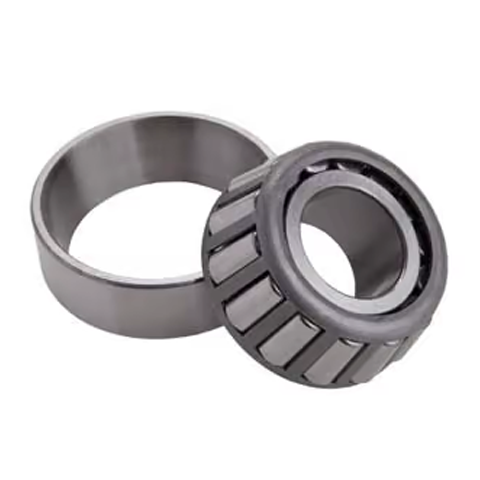
NTN NTN 32324U Single Row Tapered Roller Bearing, D=120mm
NTN 32324U Single Row Tapered Roller Bearing (Inside Dia - 120mm, Outside Dia - 260mm) SPECIFICATIONS Type of Product : Single Row Tapered Roller Bearing Inside Diameter (d) (mm) : 120 Outside Diameter D (mm) : 260 Width Dia mm : 86 Model No : 32324U 1. Types, design features, and characteristics Tapered roller bearings are designed so the tapered vertex of the raceway surfaces of the inner and outer rings and rollers converge at one point on the centerline of the bearing (see Fig. 1).The tapered rollers are guided by the compound force of the inner and outer raceway surfaces which keep the rollers pressed up against the large rib on the inner ring.A large variety of these bearings, including single, double, and four row arrangements, are available in both metric and inch series. Each type and associated characteristics are shown in Table 1. For four-row tapered roller bearings, see section “C. Special application bearings.” Table 1 Tapered roller bearing types and characteristics Type Characteristics Single row taperedroller bearings (1) There are both metric and inch series adhering to the standards shown in the following table. Dimension series *Dimension series previously not covered by 3XX are regulated under JIS B 1512; dimensions previously missing from 3XX will henceforth use the bearing number. (2) In addition to the standard design, there are also medium contact angle and large contact angle types, denoted by the contact angle codes at the end of the part numbers (C and D, respectively). (3) Subunits Tapered roller bearings can be disassembled into parts: the inner ring, rollers, and cage (collectively known as the “CONE”) and the outer ring (known as the “CUP”). These are the bearing’s “subunits”. Subunit dimensions are standardized under ISO or ABMA standards, and unified subunits are interchangeable within each dimensional standard. However, high precision grade bearings are generally not interchangeable, and these subunits must be used by assembling only subunits with identical manufacturing numbers.Aside from any cautionary notes that may appear, the single row tapered roller bearings listed in the dimension tables have subunits standardized for both metric and inch systems (including J series). (Refer to Fig. 2) Single row taperedroller bearings (4) These bearings are constructed to have a high capacity for radial loads, axial loads, and combined loads. The larger the contact angle, the greater the axial load capacity. When a pure radial load is applied to a tapered roller bearing, an induced load in the axial direction is also generated, so these bearings are generally used in pairs.(5) Single row tapered roller bearings are separable, so both the inner and outer rings can be used with tight fits. (6) Tapered roller bearings are also manufactured with flanges attached to the outer rings. For more details, contact NTN Engineering. (Refer to Fig. 3) Duplex tapered roller bearings (1) When two single-row tapered roller bearings are to be used in combination, the bearing clearance and preload are adjusted by the inner ring spacer or the outer ring spacer (see Fig. 4).(2) A product number and a combination code are indicated on inner rings, outer rings, and spacers. Parts displaying the same number and code must be used in combination.(3) See A-96 Table 8.14 for the axial internal clearance. Double row taperedroller bearings (1) Back-to-back arrangement (using double row outer rings) and face-to-face arrangement (using double row inner rings) are both available. The assemblies have been adjusted so that each type's internal clearance values are fixed. Only parts with identical manufacturing numbers can be used and they must be assembled according to their code numbers. (Refer to Fig. 5)(2) See A-96 Table 8.14 for the axial internal clearance of double-row and duplex bearings. 2. Standard cage type In general, pressed cages (see Fig. 6) are used in tapered roller bearings. For large sized bearings, machined or pin type cages may also be used, while resin cages may also be used for smaller sized bearings. 3. Allowable misalignment In order to avoid edge loading and potential for premature failure, the maximum allowable misalignment based on bearing series can be found below.The allowable misalignment of combined bearings is influenced by the load center position, so please consult NTN Engineering.• Single row (standard) …………… 1/ 2 000• Single row (ULTAGE) …………… 1/ 600 4. Precautions If bearing load is light during operation, or if the ratio of axial to radial load for duplex and double row bearings exceeds the value of e, slipping may develop between the rollers and raceway surface, sometimes resulting in smearing. The mass of rollers and cages particularly tends to be large for large tapered roller bearings. For additional details, please contact NTN Engineering.In tapered roller bearings, the cage may protrude beyond the inner and/or outer ring side faces. Care should be taken when designing the housing and shaft to ensure contact with the cage does not occur.
$726.68
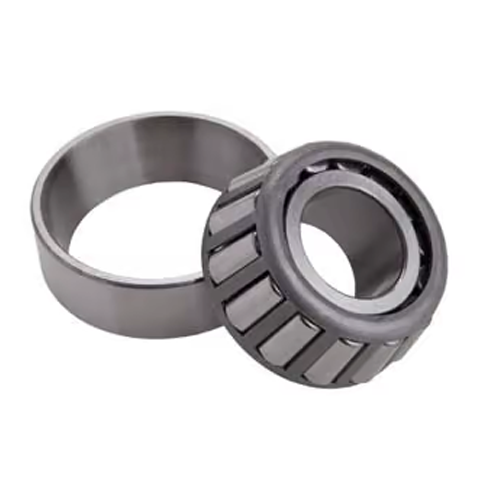
NTN NTN 32314U Single Row Tapered Roller Bearing, D=70mm
NTN 32314U Single Row Tapered Roller Bearing (Inside Dia - 70mm, Outside Dia - 150mm) SPECIFICATIONS Type of Product : Single Row Tapered Roller Bearing Inside Diameter (d) (mm) : 70 Outside Diameter D (mm) : 150 Width Dia mm : 51 Model No : 32314U 1. Types, design features, and characteristics Tapered roller bearings are designed so the tapered vertex of the raceway surfaces of the inner and outer rings and rollers converge at one point on the centerline of the bearing (see Fig. 1).The tapered rollers are guided by the compound force of the inner and outer raceway surfaces which keep the rollers pressed up against the large rib on the inner ring.A large variety of these bearings, including single, double, and four row arrangements, are available in both metric and inch series. Each type and associated characteristics are shown in Table 1. For four-row tapered roller bearings, see section “C. Special application bearings.” Table 1 Tapered roller bearing types and characteristics Type Characteristics Single row taperedroller bearings (1) There are both metric and inch series adhering to the standards shown in the following table. Dimension series *Dimension series previously not covered by 3XX are regulated under JIS B 1512; dimensions previously missing from 3XX will henceforth use the bearing number. (2) In addition to the standard design, there are also medium contact angle and large contact angle types, denoted by the contact angle codes at the end of the part numbers (C and D, respectively). (3) Subunits Tapered roller bearings can be disassembled into parts: the inner ring, rollers, and cage (collectively known as the “CONE”) and the outer ring (known as the “CUP”). These are the bearing’s “subunits”. Subunit dimensions are standardized under ISO or ABMA standards, and unified subunits are interchangeable within each dimensional standard. However, high precision grade bearings are generally not interchangeable, and these subunits must be used by assembling only subunits with identical manufacturing numbers.Aside from any cautionary notes that may appear, the single row tapered roller bearings listed in the dimension tables have subunits standardized for both metric and inch systems (including J series). (Refer to Fig. 2) Single row taperedroller bearings (4) These bearings are constructed to have a high capacity for radial loads, axial loads, and combined loads. The larger the contact angle, the greater the axial load capacity. When a pure radial load is applied to a tapered roller bearing, an induced load in the axial direction is also generated, so these bearings are generally used in pairs.(5) Single row tapered roller bearings are separable, so both the inner and outer rings can be used with tight fits. (6) Tapered roller bearings are also manufactured with flanges attached to the outer rings. For more details, contact NTN Engineering. (Refer to Fig. 3) Duplex tapered roller bearings (1) When two single-row tapered roller bearings are to be used in combination, the bearing clearance and preload are adjusted by the inner ring spacer or the outer ring spacer (see Fig. 4).(2) A product number and a combination code are indicated on inner rings, outer rings, and spacers. Parts displaying the same number and code must be used in combination.(3) See A-96 Table 8.14 for the axial internal clearance. Double row taperedroller bearings (1) Back-to-back arrangement (using double row outer rings) and face-to-face arrangement (using double row inner rings) are both available. The assemblies have been adjusted so that each type's internal clearance values are fixed. Only parts with identical manufacturing numbers can be used and they must be assembled according to their code numbers. (Refer to Fig. 5)(2) See A-96 Table 8.14 for the axial internal clearance of double-row and duplex bearings. 2. Standard cage type In general, pressed cages (see Fig. 6) are used in tapered roller bearings. For large sized bearings, machined or pin type cages may also be used, while resin cages may also be used for smaller sized bearings. 3. Allowable misalignment In order to avoid edge loading and potential for premature failure, the maximum allowable misalignment based on bearing series can be found below.The allowable misalignment of combined bearings is influenced by the load center position, so please consult NTN Engineering.• Single row (standard) …………… 1/ 2 000• Single row (ULTAGE) …………… 1/ 600 4. Precautions If bearing load is light during operation, or if the ratio of axial to radial load for duplex and double row bearings exceeds the value of e, slipping may develop between the rollers and raceway surface, sometimes resulting in smearing. The mass of rollers and cages particularly tends to be large for large tapered roller bearings. For additional details, please contact NTN Engineering.In tapered roller bearings, the cage may protrude beyond the inner and/or outer ring side faces. Care should be taken when designing the housing and shaft to ensure contact with the cage does not occur.
$114.26
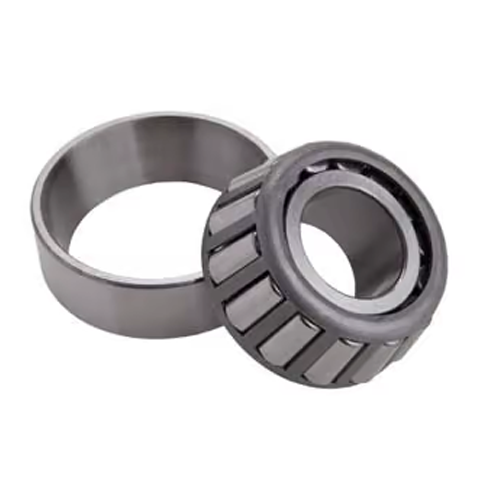
NTN NTN 32313U Single Row Tapered Roller Bearing, D=65mm
NTN 32313U Single Row Tapered Roller Bearing (Inside Dia - 65mm, Outside Dia - 140mm) SPECIFICATIONS Type of Product : Single Row Tapered Roller Bearing Inside Diameter (d) (mm) : 65 Outside Diameter D (mm) : 140 Width Dia mm : 48 Model No : 32313U 1. Types, design features, and characteristics Tapered roller bearings are designed so the tapered vertex of the raceway surfaces of the inner and outer rings and rollers converge at one point on the centerline of the bearing (see Fig. 1).The tapered rollers are guided by the compound force of the inner and outer raceway surfaces which keep the rollers pressed up against the large rib on the inner ring.A large variety of these bearings, including single, double, and four row arrangements, are available in both metric and inch series. Each type and associated characteristics are shown in Table 1. For four-row tapered roller bearings, see section “C. Special application bearings.” Table 1 Tapered roller bearing types and characteristics Type Characteristics Single row taperedroller bearings (1) There are both metric and inch series adhering to the standards shown in the following table. Dimension series *Dimension series previously not covered by 3XX are regulated under JIS B 1512; dimensions previously missing from 3XX will henceforth use the bearing number. (2) In addition to the standard design, there are also medium contact angle and large contact angle types, denoted by the contact angle codes at the end of the part numbers (C and D, respectively). (3) Subunits Tapered roller bearings can be disassembled into parts: the inner ring, rollers, and cage (collectively known as the “CONE”) and the outer ring (known as the “CUP”). These are the bearing’s “subunits”. Subunit dimensions are standardized under ISO or ABMA standards, and unified subunits are interchangeable within each dimensional standard. However, high precision grade bearings are generally not interchangeable, and these subunits must be used by assembling only subunits with identical manufacturing numbers.Aside from any cautionary notes that may appear, the single row tapered roller bearings listed in the dimension tables have subunits standardized for both metric and inch systems (including J series). (Refer to Fig. 2) Single row taperedroller bearings (4) These bearings are constructed to have a high capacity for radial loads, axial loads, and combined loads. The larger the contact angle, the greater the axial load capacity. When a pure radial load is applied to a tapered roller bearing, an induced load in the axial direction is also generated, so these bearings are generally used in pairs.(5) Single row tapered roller bearings are separable, so both the inner and outer rings can be used with tight fits. (6) Tapered roller bearings are also manufactured with flanges attached to the outer rings. For more details, contact NTN Engineering. (Refer to Fig. 3) Duplex tapered roller bearings (1) When two single-row tapered roller bearings are to be used in combination, the bearing clearance and preload are adjusted by the inner ring spacer or the outer ring spacer (see Fig. 4).(2) A product number and a combination code are indicated on inner rings, outer rings, and spacers. Parts displaying the same number and code must be used in combination.(3) See A-96 Table 8.14 for the axial internal clearance. Double row taperedroller bearings (1) Back-to-back arrangement (using double row outer rings) and face-to-face arrangement (using double row inner rings) are both available. The assemblies have been adjusted so that each type's internal clearance values are fixed. Only parts with identical manufacturing numbers can be used and they must be assembled according to their code numbers. (Refer to Fig. 5)(2) See A-96 Table 8.14 for the axial internal clearance of double-row and duplex bearings. 2. Standard cage type In general, pressed cages (see Fig. 6) are used in tapered roller bearings. For large sized bearings, machined or pin type cages may also be used, while resin cages may also be used for smaller sized bearings. 3. Allowable misalignment In order to avoid edge loading and potential for premature failure, the maximum allowable misalignment based on bearing series can be found below.The allowable misalignment of combined bearings is influenced by the load center position, so please consult NTN Engineering.• Single row (standard) …………… 1/ 2 000• Single row (ULTAGE) …………… 1/ 600 4. Precautions If bearing load is light during operation, or if the ratio of axial to radial load for duplex and double row bearings exceeds the value of e, slipping may develop between the rollers and raceway surface, sometimes resulting in smearing. The mass of rollers and cages particularly tends to be large for large tapered roller bearings. For additional details, please contact NTN Engineering.In tapered roller bearings, the cage may protrude beyond the inner and/or outer ring side faces. Care should be taken when designing the housing and shaft to ensure contact with the cage does not occur.
$88.50
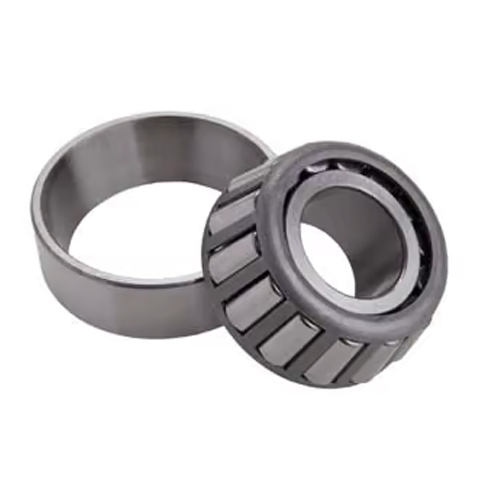
NTN NTN 32311U Single Row Tapered Roller Bearing, D=55mm
NTN 32311U Single Row Tapered Roller Bearing (Inside Dia - 55mm, Outside Dia - 120mm) SPECIFICATIONS Type of Product : Single Row Tapered Roller Bearing Inside Diameter (d) (mm) : 55 Outside Diameter D (mm) : 120 Width Dia mm : 43 Model No : 32311U 1. Types, design features, and characteristics Tapered roller bearings are designed so the tapered vertex of the raceway surfaces of the inner and outer rings and rollers converge at one point on the centerline of the bearing (see Fig. 1).The tapered rollers are guided by the compound force of the inner and outer raceway surfaces which keep the rollers pressed up against the large rib on the inner ring.A large variety of these bearings, including single, double, and four row arrangements, are available in both metric and inch series. Each type and associated characteristics are shown in Table 1. For four-row tapered roller bearings, see section “C. Special application bearings.” Table 1 Tapered roller bearing types and characteristics Type Characteristics Single row taperedroller bearings (1) There are both metric and inch series adhering to the standards shown in the following table. Dimension series *Dimension series previously not covered by 3XX are regulated under JIS B 1512; dimensions previously missing from 3XX will henceforth use the bearing number. (2) In addition to the standard design, there are also medium contact angle and large contact angle types, denoted by the contact angle codes at the end of the part numbers (C and D, respectively). (3) Subunits Tapered roller bearings can be disassembled into parts: the inner ring, rollers, and cage (collectively known as the “CONE”) and the outer ring (known as the “CUP”). These are the bearing’s “subunits”. Subunit dimensions are standardized under ISO or ABMA standards, and unified subunits are interchangeable within each dimensional standard. However, high precision grade bearings are generally not interchangeable, and these subunits must be used by assembling only subunits with identical manufacturing numbers.Aside from any cautionary notes that may appear, the single row tapered roller bearings listed in the dimension tables have subunits standardized for both metric and inch systems (including J series). (Refer to Fig. 2) Single row taperedroller bearings (4) These bearings are constructed to have a high capacity for radial loads, axial loads, and combined loads. The larger the contact angle, the greater the axial load capacity. When a pure radial load is applied to a tapered roller bearing, an induced load in the axial direction is also generated, so these bearings are generally used in pairs.(5) Single row tapered roller bearings are separable, so both the inner and outer rings can be used with tight fits. (6) Tapered roller bearings are also manufactured with flanges attached to the outer rings. For more details, contact NTN Engineering. (Refer to Fig. 3) Duplex tapered roller bearings (1) When two single-row tapered roller bearings are to be used in combination, the bearing clearance and preload are adjusted by the inner ring spacer or the outer ring spacer (see Fig. 4).(2) A product number and a combination code are indicated on inner rings, outer rings, and spacers. Parts displaying the same number and code must be used in combination.(3) See A-96 Table 8.14 for the axial internal clearance. Double row taperedroller bearings (1) Back-to-back arrangement (using double row outer rings) and face-to-face arrangement (using double row inner rings) are both available. The assemblies have been adjusted so that each type's internal clearance values are fixed. Only parts with identical manufacturing numbers can be used and they must be assembled according to their code numbers. (Refer to Fig. 5)(2) See A-96 Table 8.14 for the axial internal clearance of double-row and duplex bearings. 2. Standard cage type In general, pressed cages (see Fig. 6) are used in tapered roller bearings. For large sized bearings, machined or pin type cages may also be used, while resin cages may also be used for smaller sized bearings. 3. Allowable misalignment In order to avoid edge loading and potential for premature failure, the maximum allowable misalignment based on bearing series can be found below.The allowable misalignment of combined bearings is influenced by the load center position, so please consult NTN Engineering.• Single row (standard) …………… 1/ 2 000• Single row (ULTAGE) …………… 1/ 600 4. Precautions If bearing load is light during operation, or if the ratio of axial to radial load for duplex and double row bearings exceeds the value of e, slipping may develop between the rollers and raceway surface, sometimes resulting in smearing. The mass of rollers and cages particularly tends to be large for large tapered roller bearings. For additional details, please contact NTN Engineering.In tapered roller bearings, the cage may protrude beyond the inner and/or outer ring side faces. Care should be taken when designing the housing and shaft to ensure contact with the cage does not occur.
$55.30
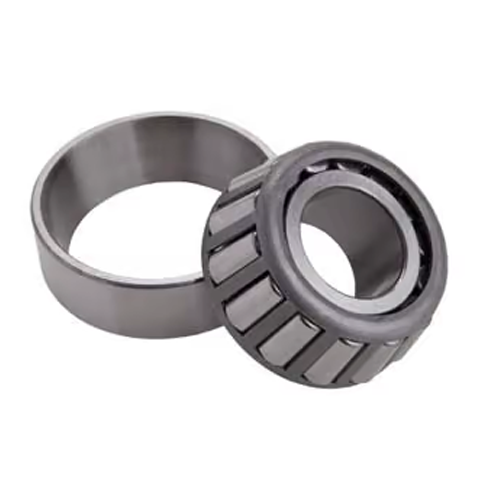
NTN NTN 32226U Single Row Tapered Roller Bearing, D=130mm
NTN 32226U Single Row Tapered Roller Bearing (Inside Dia - 130mm, Outside Dia - 230mm) SPECIFICATIONS Type of Product : Single Row Tapered Roller Bearing Inside Diameter (d) (mm) : 130 Outside Diameter D (mm) : 230 Width Dia mm : 64 Model No : 32226U 1. Types, design features, and characteristics Tapered roller bearings are designed so the tapered vertex of the raceway surfaces of the inner and outer rings and rollers converge at one point on the centerline of the bearing (see Fig. 1).The tapered rollers are guided by the compound force of the inner and outer raceway surfaces which keep the rollers pressed up against the large rib on the inner ring.A large variety of these bearings, including single, double, and four row arrangements, are available in both metric and inch series. Each type and associated characteristics are shown in Table 1. For four-row tapered roller bearings, see section “C. Special application bearings.” Table 1 Tapered roller bearing types and characteristics Type Characteristics Single row taperedroller bearings (1) There are both metric and inch series adhering to the standards shown in the following table. Dimension series *Dimension series previously not covered by 3XX are regulated under JIS B 1512; dimensions previously missing from 3XX will henceforth use the bearing number. (2) In addition to the standard design, there are also medium contact angle and large contact angle types, denoted by the contact angle codes at the end of the part numbers (C and D, respectively). (3) Subunits Tapered roller bearings can be disassembled into parts: the inner ring, rollers, and cage (collectively known as the “CONE”) and the outer ring (known as the “CUP”). These are the bearing’s “subunits”. Subunit dimensions are standardized under ISO or ABMA standards, and unified subunits are interchangeable within each dimensional standard. However, high precision grade bearings are generally not interchangeable, and these subunits must be used by assembling only subunits with identical manufacturing numbers.Aside from any cautionary notes that may appear, the single row tapered roller bearings listed in the dimension tables have subunits standardized for both metric and inch systems (including J series). (Refer to Fig. 2) Single row taperedroller bearings (4) These bearings are constructed to have a high capacity for radial loads, axial loads, and combined loads. The larger the contact angle, the greater the axial load capacity. When a pure radial load is applied to a tapered roller bearing, an induced load in the axial direction is also generated, so these bearings are generally used in pairs.(5) Single row tapered roller bearings are separable, so both the inner and outer rings can be used with tight fits. (6) Tapered roller bearings are also manufactured with flanges attached to the outer rings. For more details, contact NTN Engineering. (Refer to Fig. 3) Duplex tapered roller bearings (1) When two single-row tapered roller bearings are to be used in combination, the bearing clearance and preload are adjusted by the inner ring spacer or the outer ring spacer (see Fig. 4).(2) A product number and a combination code are indicated on inner rings, outer rings, and spacers. Parts displaying the same number and code must be used in combination.(3) See A-96 Table 8.14 for the axial internal clearance. Double row taperedroller bearings (1) Back-to-back arrangement (using double row outer rings) and face-to-face arrangement (using double row inner rings) are both available. The assemblies have been adjusted so that each type's internal clearance values are fixed. Only parts with identical manufacturing numbers can be used and they must be assembled according to their code numbers. (Refer to Fig. 5)(2) See A-96 Table 8.14 for the axial internal clearance of double-row and duplex bearings. 2. Standard cage type In general, pressed cages (see Fig. 6) are used in tapered roller bearings. For large sized bearings, machined or pin type cages may also be used, while resin cages may also be used for smaller sized bearings. 3. Allowable misalignment In order to avoid edge loading and potential for premature failure, the maximum allowable misalignment based on bearing series can be found below.The allowable misalignment of combined bearings is influenced by the load center position, so please consult NTN Engineering.• Single row (standard) …………… 1/ 2 000• Single row (ULTAGE) …………… 1/ 600 4. Precautions If bearing load is light during operation, or if the ratio of axial to radial load for duplex and double row bearings exceeds the value of e, slipping may develop between the rollers and raceway surface, sometimes resulting in smearing. The mass of rollers and cages particularly tends to be large for large tapered roller bearings. For additional details, please contact NTN Engineering.In tapered roller bearings, the cage may protrude beyond the inner and/or outer ring side faces. Care should be taken when designing the housing and shaft to ensure contact with the cage does not occur.
$461.89
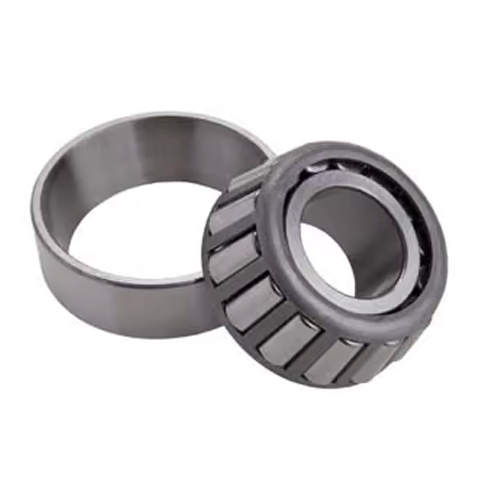
NTN NTN 32222U Single Row Tapered Roller Bearing, D=110mm
NTN 32222U Single Row Tapered Roller Bearing (Inside Dia - 110mm, Outside Dia - 200mm) SPECIFICATIONS Type of Product : Single Row Tapered Roller Bearing Inside Diameter (d) (mm) : 110 Outside Diameter D (mm) : 200 Width Dia mm : 53 Model No : 32222U 1. Types, design features, and characteristics Tapered roller bearings are designed so the tapered vertex of the raceway surfaces of the inner and outer rings and rollers converge at one point on the centerline of the bearing (see Fig. 1).The tapered rollers are guided by the compound force of the inner and outer raceway surfaces which keep the rollers pressed up against the large rib on the inner ring.A large variety of these bearings, including single, double, and four row arrangements, are available in both metric and inch series. Each type and associated characteristics are shown in Table 1. For four-row tapered roller bearings, see section “C. Special application bearings.” Table 1 Tapered roller bearing types and characteristics Type Characteristics Single row taperedroller bearings (1) There are both metric and inch series adhering to the standards shown in the following table. Dimension series *Dimension series previously not covered by 3XX are regulated under JIS B 1512; dimensions previously missing from 3XX will henceforth use the bearing number. (2) In addition to the standard design, there are also medium contact angle and large contact angle types, denoted by the contact angle codes at the end of the part numbers (C and D, respectively). (3) Subunits Tapered roller bearings can be disassembled into parts: the inner ring, rollers, and cage (collectively known as the “CONE”) and the outer ring (known as the “CUP”). These are the bearing’s “subunits”. Subunit dimensions are standardized under ISO or ABMA standards, and unified subunits are interchangeable within each dimensional standard. However, high precision grade bearings are generally not interchangeable, and these subunits must be used by assembling only subunits with identical manufacturing numbers.Aside from any cautionary notes that may appear, the single row tapered roller bearings listed in the dimension tables have subunits standardized for both metric and inch systems (including J series). (Refer to Fig. 2) Single row taperedroller bearings (4) These bearings are constructed to have a high capacity for radial loads, axial loads, and combined loads. The larger the contact angle, the greater the axial load capacity. When a pure radial load is applied to a tapered roller bearing, an induced load in the axial direction is also generated, so these bearings are generally used in pairs.(5) Single row tapered roller bearings are separable, so both the inner and outer rings can be used with tight fits. (6) Tapered roller bearings are also manufactured with flanges attached to the outer rings. For more details, contact NTN Engineering. (Refer to Fig. 3) Duplex tapered roller bearings (1) When two single-row tapered roller bearings are to be used in combination, the bearing clearance and preload are adjusted by the inner ring spacer or the outer ring spacer (see Fig. 4).(2) A product number and a combination code are indicated on inner rings, outer rings, and spacers. Parts displaying the same number and code must be used in combination.(3) See A-96 Table 8.14 for the axial internal clearance. Double row taperedroller bearings (1) Back-to-back arrangement (using double row outer rings) and face-to-face arrangement (using double row inner rings) are both available. The assemblies have been adjusted so that each type's internal clearance values are fixed. Only parts with identical manufacturing numbers can be used and they must be assembled according to their code numbers. (Refer to Fig. 5)(2) See A-96 Table 8.14 for the axial internal clearance of double-row and duplex bearings. 2. Standard cage type In general, pressed cages (see Fig. 6) are used in tapered roller bearings. For large sized bearings, machined or pin type cages may also be used, while resin cages may also be used for smaller sized bearings. 3. Allowable misalignment In order to avoid edge loading and potential for premature failure, the maximum allowable misalignment based on bearing series can be found below.The allowable misalignment of combined bearings is influenced by the load center position, so please consult NTN Engineering.• Single row (standard) …………… 1/ 2 000• Single row (ULTAGE) …………… 1/ 600 4. Precautions If bearing load is light during operation, or if the ratio of axial to radial load for duplex and double row bearings exceeds the value of e, slipping may develop between the rollers and raceway surface, sometimes resulting in smearing. The mass of rollers and cages particularly tends to be large for large tapered roller bearings. For additional details, please contact NTN Engineering.In tapered roller bearings, the cage may protrude beyond the inner and/or outer ring side faces. Care should be taken when designing the housing and shaft to ensure contact with the cage does not occur.
$211.82
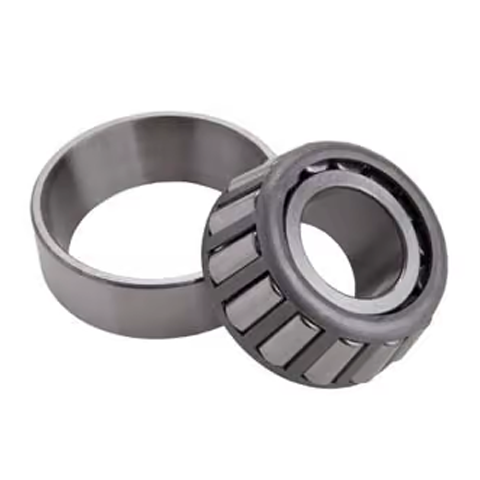
NTN NTN 32218U Single Row Tapered Roller Bearing, D=90mm
NTN 32218U Single Row Tapered Roller Bearing (Inside Dia - 90mm, Outside Dia - 160mm) SPECIFICATIONS Type of Product : Single Row Tapered Roller Bearing Inside Diameter (d) (mm) : 90 Outside Diameter D (mm) : 160 Width Dia mm : 40 Model No : 32218U 1. Types, design features, and characteristics Tapered roller bearings are designed so the tapered vertex of the raceway surfaces of the inner and outer rings and rollers converge at one point on the centerline of the bearing (see Fig. 1).The tapered rollers are guided by the compound force of the inner and outer raceway surfaces which keep the rollers pressed up against the large rib on the inner ring.A large variety of these bearings, including single, double, and four row arrangements, are available in both metric and inch series. Each type and associated characteristics are shown in Table 1. For four-row tapered roller bearings, see section “C. Special application bearings.” Table 1 Tapered roller bearing types and characteristics Type Characteristics Single row taperedroller bearings (1) There are both metric and inch series adhering to the standards shown in the following table. Dimension series *Dimension series previously not covered by 3XX are regulated under JIS B 1512; dimensions previously missing from 3XX will henceforth use the bearing number. (2) In addition to the standard design, there are also medium contact angle and large contact angle types, denoted by the contact angle codes at the end of the part numbers (C and D, respectively). (3) Subunits Tapered roller bearings can be disassembled into parts: the inner ring, rollers, and cage (collectively known as the “CONE”) and the outer ring (known as the “CUP”). These are the bearing’s “subunits”. Subunit dimensions are standardized under ISO or ABMA standards, and unified subunits are interchangeable within each dimensional standard. However, high precision grade bearings are generally not interchangeable, and these subunits must be used by assembling only subunits with identical manufacturing numbers.Aside from any cautionary notes that may appear, the single row tapered roller bearings listed in the dimension tables have subunits standardized for both metric and inch systems (including J series). (Refer to Fig. 2) Single row taperedroller bearings (4) These bearings are constructed to have a high capacity for radial loads, axial loads, and combined loads. The larger the contact angle, the greater the axial load capacity. When a pure radial load is applied to a tapered roller bearing, an induced load in the axial direction is also generated, so these bearings are generally used in pairs.(5) Single row tapered roller bearings are separable, so both the inner and outer rings can be used with tight fits. (6) Tapered roller bearings are also manufactured with flanges attached to the outer rings. For more details, contact NTN Engineering. (Refer to Fig. 3) Duplex tapered roller bearings (1) When two single-row tapered roller bearings are to be used in combination, the bearing clearance and preload are adjusted by the inner ring spacer or the outer ring spacer (see Fig. 4).(2) A product number and a combination code are indicated on inner rings, outer rings, and spacers. Parts displaying the same number and code must be used in combination.(3) See A-96 Table 8.14 for the axial internal clearance. Double row taperedroller bearings (1) Back-to-back arrangement (using double row outer rings) and face-to-face arrangement (using double row inner rings) are both available. The assemblies have been adjusted so that each type's internal clearance values are fixed. Only parts with identical manufacturing numbers can be used and they must be assembled according to their code numbers. (Refer to Fig. 5)(2) See A-96 Table 8.14 for the axial internal clearance of double-row and duplex bearings. 2. Standard cage type In general, pressed cages (see Fig. 6) are used in tapered roller bearings. For large sized bearings, machined or pin type cages may also be used, while resin cages may also be used for smaller sized bearings. 3. Allowable misalignment In order to avoid edge loading and potential for premature failure, the maximum allowable misalignment based on bearing series can be found below.The allowable misalignment of combined bearings is influenced by the load center position, so please consult NTN Engineering.• Single row (standard) …………… 1/ 2 000• Single row (ULTAGE) …………… 1/ 600 4. Precautions If bearing load is light during operation, or if the ratio of axial to radial load for duplex and double row bearings exceeds the value of e, slipping may develop between the rollers and raceway surface, sometimes resulting in smearing. The mass of rollers and cages particularly tends to be large for large tapered roller bearings. For additional details, please contact NTN Engineering.In tapered roller bearings, the cage may protrude beyond the inner and/or outer ring side faces. Care should be taken when designing the housing and shaft to ensure contact with the cage does not occur.
$76.48
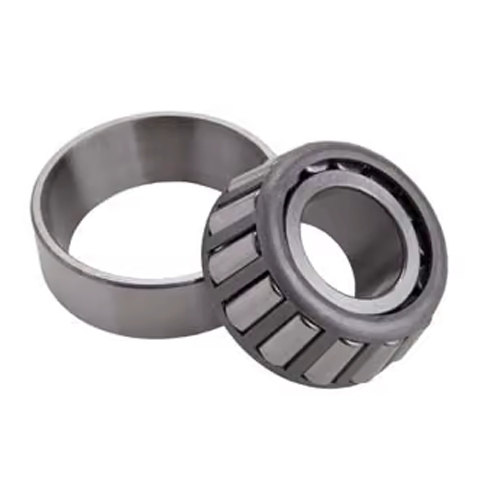
NTN NTN 32217U Single Row Tapered Roller Bearing, D=85mm
NTN 32217U Single Row Tapered Roller Bearing (Inside Dia - 85mm, Outside Dia - 150mm) SPECIFICATIONS Type of Product : Single Row Tapered Roller Bearing Inside Diameter (d) (mm) : 85 Outside Diameter D (mm) : 150 Width Dia mm : 36 Model No : 32217U 1. Types, design features, and characteristics Tapered roller bearings are designed so the tapered vertex of the raceway surfaces of the inner and outer rings and rollers converge at one point on the centerline of the bearing (see Fig. 1).The tapered rollers are guided by the compound force of the inner and outer raceway surfaces which keep the rollers pressed up against the large rib on the inner ring.A large variety of these bearings, including single, double, and four row arrangements, are available in both metric and inch series. Each type and associated characteristics are shown in Table 1. For four-row tapered roller bearings, see section “C. Special application bearings.” Table 1 Tapered roller bearing types and characteristics Type Characteristics Single row taperedroller bearings (1) There are both metric and inch series adhering to the standards shown in the following table. Dimension series *Dimension series previously not covered by 3XX are regulated under JIS B 1512; dimensions previously missing from 3XX will henceforth use the bearing number. (2) In addition to the standard design, there are also medium contact angle and large contact angle types, denoted by the contact angle codes at the end of the part numbers (C and D, respectively). (3) Subunits Tapered roller bearings can be disassembled into parts: the inner ring, rollers, and cage (collectively known as the “CONE”) and the outer ring (known as the “CUP”). These are the bearing’s “subunits”. Subunit dimensions are standardized under ISO or ABMA standards, and unified subunits are interchangeable within each dimensional standard. However, high precision grade bearings are generally not interchangeable, and these subunits must be used by assembling only subunits with identical manufacturing numbers.Aside from any cautionary notes that may appear, the single row tapered roller bearings listed in the dimension tables have subunits standardized for both metric and inch systems (including J series). (Refer to Fig. 2) Single row taperedroller bearings (4) These bearings are constructed to have a high capacity for radial loads, axial loads, and combined loads. The larger the contact angle, the greater the axial load capacity. When a pure radial load is applied to a tapered roller bearing, an induced load in the axial direction is also generated, so these bearings are generally used in pairs.(5) Single row tapered roller bearings are separable, so both the inner and outer rings can be used with tight fits. (6) Tapered roller bearings are also manufactured with flanges attached to the outer rings. For more details, contact NTN Engineering. (Refer to Fig. 3) Duplex tapered roller bearings (1) When two single-row tapered roller bearings are to be used in combination, the bearing clearance and preload are adjusted by the inner ring spacer or the outer ring spacer (see Fig. 4).(2) A product number and a combination code are indicated on inner rings, outer rings, and spacers. Parts displaying the same number and code must be used in combination.(3) See A-96 Table 8.14 for the axial internal clearance. Double row taperedroller bearings (1) Back-to-back arrangement (using double row outer rings) and face-to-face arrangement (using double row inner rings) are both available. The assemblies have been adjusted so that each type's internal clearance values are fixed. Only parts with identical manufacturing numbers can be used and they must be assembled according to their code numbers. (Refer to Fig. 5)(2) See A-96 Table 8.14 for the axial internal clearance of double-row and duplex bearings. 2. Standard cage type In general, pressed cages (see Fig. 6) are used in tapered roller bearings. For large sized bearings, machined or pin type cages may also be used, while resin cages may also be used for smaller sized bearings. 3. Allowable misalignment In order to avoid edge loading and potential for premature failure, the maximum allowable misalignment based on bearing series can be found below.The allowable misalignment of combined bearings is influenced by the load center position, so please consult NTN Engineering.• Single row (standard) …………… 1/ 2 000• Single row (ULTAGE) …………… 1/ 600 4. Precautions If bearing load is light during operation, or if the ratio of axial to radial load for duplex and double row bearings exceeds the value of e, slipping may develop between the rollers and raceway surface, sometimes resulting in smearing. The mass of rollers and cages particularly tends to be large for large tapered roller bearings. For additional details, please contact NTN Engineering.In tapered roller bearings, the cage may protrude beyond the inner and/or outer ring side faces. Care should be taken when designing the housing and shaft to ensure contact with the cage does not occur.
$59.92
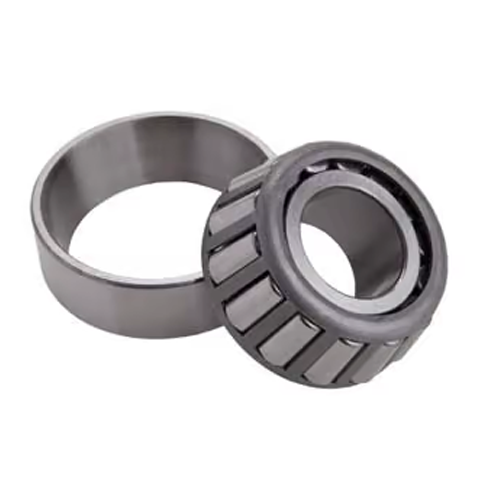
NTN NTN 32216U Single Row Tapered Roller Bearing, D=80mm
NTN 32216U Single Row Tapered Roller Bearing (Inside Dia - 80mm, Outside Dia - 140mm) SPECIFICATIONS Type of Product : Single Row Tapered Roller Bearing Inside Diameter (d) (mm) : 80 Outside Diameter D (mm) : 140 Width Dia mm : 33 Model No : 32216U 1. Types, design features, and characteristics Tapered roller bearings are designed so the tapered vertex of the raceway surfaces of the inner and outer rings and rollers converge at one point on the centerline of the bearing (see Fig. 1).The tapered rollers are guided by the compound force of the inner and outer raceway surfaces which keep the rollers pressed up against the large rib on the inner ring.A large variety of these bearings, including single, double, and four row arrangements, are available in both metric and inch series. Each type and associated characteristics are shown in Table 1. For four-row tapered roller bearings, see section “C. Special application bearings.” Table 1 Tapered roller bearing types and characteristics Type Characteristics Single row taperedroller bearings (1) There are both metric and inch series adhering to the standards shown in the following table. Dimension series *Dimension series previously not covered by 3XX are regulated under JIS B 1512; dimensions previously missing from 3XX will henceforth use the bearing number. (2) In addition to the standard design, there are also medium contact angle and large contact angle types, denoted by the contact angle codes at the end of the part numbers (C and D, respectively). (3) Subunits Tapered roller bearings can be disassembled into parts: the inner ring, rollers, and cage (collectively known as the “CONE”) and the outer ring (known as the “CUP”). These are the bearing’s “subunits”. Subunit dimensions are standardized under ISO or ABMA standards, and unified subunits are interchangeable within each dimensional standard. However, high precision grade bearings are generally not interchangeable, and these subunits must be used by assembling only subunits with identical manufacturing numbers.Aside from any cautionary notes that may appear, the single row tapered roller bearings listed in the dimension tables have subunits standardized for both metric and inch systems (including J series). (Refer to Fig. 2) Single row taperedroller bearings (4) These bearings are constructed to have a high capacity for radial loads, axial loads, and combined loads. The larger the contact angle, the greater the axial load capacity. When a pure radial load is applied to a tapered roller bearing, an induced load in the axial direction is also generated, so these bearings are generally used in pairs.(5) Single row tapered roller bearings are separable, so both the inner and outer rings can be used with tight fits. (6) Tapered roller bearings are also manufactured with flanges attached to the outer rings. For more details, contact NTN Engineering. (Refer to Fig. 3) Duplex tapered roller bearings (1) When two single-row tapered roller bearings are to be used in combination, the bearing clearance and preload are adjusted by the inner ring spacer or the outer ring spacer (see Fig. 4).(2) A product number and a combination code are indicated on inner rings, outer rings, and spacers. Parts displaying the same number and code must be used in combination.(3) See A-96 Table 8.14 for the axial internal clearance. Double row taperedroller bearings (1) Back-to-back arrangement (using double row outer rings) and face-to-face arrangement (using double row inner rings) are both available. The assemblies have been adjusted so that each type's internal clearance values are fixed. Only parts with identical manufacturing numbers can be used and they must be assembled according to their code numbers. (Refer to Fig. 5)(2) See A-96 Table 8.14 for the axial internal clearance of double-row and duplex bearings. 2. Standard cage type In general, pressed cages (see Fig. 6) are used in tapered roller bearings. For large sized bearings, machined or pin type cages may also be used, while resin cages may also be used for smaller sized bearings. 3. Allowable misalignment In order to avoid edge loading and potential for premature failure, the maximum allowable misalignment based on bearing series can be found below.The allowable misalignment of combined bearings is influenced by the load center position, so please consult NTN Engineering.• Single row (standard) …………… 1/ 2 000• Single row (ULTAGE) …………… 1/ 600 4. Precautions If bearing load is light during operation, or if the ratio of axial to radial load for duplex and double row bearings exceeds the value of e, slipping may develop between the rollers and raceway surface, sometimes resulting in smearing. The mass of rollers and cages particularly tends to be large for large tapered roller bearings. For additional details, please contact NTN Engineering.In tapered roller bearings, the cage may protrude beyond the inner and/or outer ring side faces. Care should be taken when designing the housing and shaft to ensure contact with the cage does not occur.
$47.83
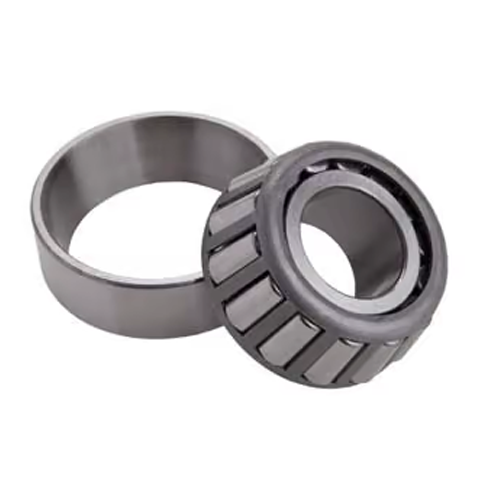
NTN NTN 32034XU Single Row Tapered Roller Bearing, D=170mm
NTN 32034XU Single Row Tapered Roller Bearing (Inside Dia - 170mm, Outside Dia - 260mm) SPECIFICATIONS Type of Product : Single Row Tapered Roller Bearing Inside Diameter (d) (mm) : 170 Outside Diameter D (mm) : 260 Width Dia mm : 57 Model No : 32034XU 1. Types, design features, and characteristics Tapered roller bearings are designed so the tapered vertex of the raceway surfaces of the inner and outer rings and rollers converge at one point on the centerline of the bearing (see Fig. 1).The tapered rollers are guided by the compound force of the inner and outer raceway surfaces which keep the rollers pressed up against the large rib on the inner ring.A large variety of these bearings, including single, double, and four row arrangements, are available in both metric and inch series. Each type and associated characteristics are shown in Table 1. For four-row tapered roller bearings, see section “C. Special application bearings.” Table 1 Tapered roller bearing types and characteristics Type Characteristics Single row taperedroller bearings (1) There are both metric and inch series adhering to the standards shown in the following table. Dimension series *Dimension series previously not covered by 3XX are regulated under JIS B 1512; dimensions previously missing from 3XX will henceforth use the bearing number. (2) In addition to the standard design, there are also medium contact angle and large contact angle types, denoted by the contact angle codes at the end of the part numbers (C and D, respectively). (3) Subunits Tapered roller bearings can be disassembled into parts: the inner ring, rollers, and cage (collectively known as the “CONE”) and the outer ring (known as the “CUP”). These are the bearing’s “subunits”. Subunit dimensions are standardized under ISO or ABMA standards, and unified subunits are interchangeable within each dimensional standard. However, high precision grade bearings are generally not interchangeable, and these subunits must be used by assembling only subunits with identical manufacturing numbers.Aside from any cautionary notes that may appear, the single row tapered roller bearings listed in the dimension tables have subunits standardized for both metric and inch systems (including J series). (Refer to Fig. 2) Single row taperedroller bearings (4) These bearings are constructed to have a high capacity for radial loads, axial loads, and combined loads. The larger the contact angle, the greater the axial load capacity. When a pure radial load is applied to a tapered roller bearing, an induced load in the axial direction is also generated, so these bearings are generally used in pairs.(5) Single row tapered roller bearings are separable, so both the inner and outer rings can be used with tight fits. (6) Tapered roller bearings are also manufactured with flanges attached to the outer rings. For more details, contact NTN Engineering. (Refer to Fig. 3) Duplex tapered roller bearings (1) When two single-row tapered roller bearings are to be used in combination, the bearing clearance and preload are adjusted by the inner ring spacer or the outer ring spacer (see Fig. 4).(2) A product number and a combination code are indicated on inner rings, outer rings, and spacers. Parts displaying the same number and code must be used in combination.(3) See A-96 Table 8.14 for the axial internal clearance. Double row taperedroller bearings (1) Back-to-back arrangement (using double row outer rings) and face-to-face arrangement (using double row inner rings) are both available. The assemblies have been adjusted so that each type's internal clearance values are fixed. Only parts with identical manufacturing numbers can be used and they must be assembled according to their code numbers. (Refer to Fig. 5)(2) See A-96 Table 8.14 for the axial internal clearance of double-row and duplex bearings. 2. Standard cage type In general, pressed cages (see Fig. 6) are used in tapered roller bearings. For large sized bearings, machined or pin type cages may also be used, while resin cages may also be used for smaller sized bearings. 3. Allowable misalignment In order to avoid edge loading and potential for premature failure, the maximum allowable misalignment based on bearing series can be found below.The allowable misalignment of combined bearings is influenced by the load center position, so please consult NTN Engineering.• Single row (standard) …………… 1/ 2 000• Single row (ULTAGE) …………… 1/ 600 4. Precautions If bearing load is light during operation, or if the ratio of axial to radial load for duplex and double row bearings exceeds the value of e, slipping may develop between the rollers and raceway surface, sometimes resulting in smearing. The mass of rollers and cages particularly tends to be large for large tapered roller bearings. For additional details, please contact NTN Engineering.In tapered roller bearings, the cage may protrude beyond the inner and/or outer ring side faces. Care should be taken when designing the housing and shaft to ensure contact with the cage does not occur.
$460.96
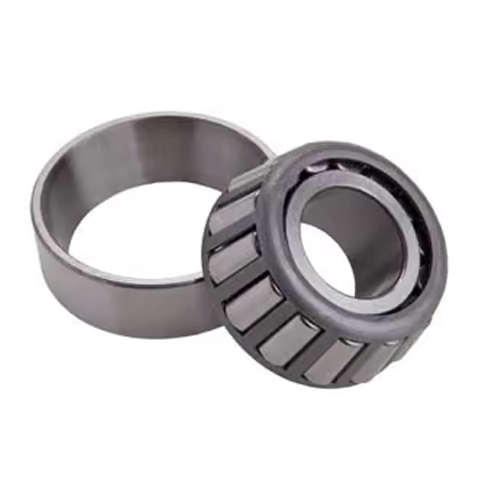
NTN NTN 32028XU Single Row Tapered Roller Bearing, D=140mm
NTN 32028XU Single Row Tapered Roller Bearing (Inside Dia - 140mm, Outside Dia - 210mm) SPECIFICATIONS Type of Product : Single Row Tapered Roller Bearing Inside Diameter (d) (mm) : 140 Outside Diameter D (mm) : 210 Width Dia mm : 45 Model No : 32028XU 1. Types, design features, and characteristics Tapered roller bearings are designed so the tapered vertex of the raceway surfaces of the inner and outer rings and rollers converge at one point on the centerline of the bearing (see Fig. 1).The tapered rollers are guided by the compound force of the inner and outer raceway surfaces which keep the rollers pressed up against the large rib on the inner ring.A large variety of these bearings, including single, double, and four row arrangements, are available in both metric and inch series. Each type and associated characteristics are shown in Table 1. For four-row tapered roller bearings, see section “C. Special application bearings.” Table 1 Tapered roller bearing types and characteristics Type Characteristics Single row taperedroller bearings (1) There are both metric and inch series adhering to the standards shown in the following table. Dimension series *Dimension series previously not covered by 3XX are regulated under JIS B 1512; dimensions previously missing from 3XX will henceforth use the bearing number. (2) In addition to the standard design, there are also medium contact angle and large contact angle types, denoted by the contact angle codes at the end of the part numbers (C and D, respectively). (3) Subunits Tapered roller bearings can be disassembled into parts: the inner ring, rollers, and cage (collectively known as the “CONE”) and the outer ring (known as the “CUP”). These are the bearing’s “subunits”. Subunit dimensions are standardized under ISO or ABMA standards, and unified subunits are interchangeable within each dimensional standard. However, high precision grade bearings are generally not interchangeable, and these subunits must be used by assembling only subunits with identical manufacturing numbers.Aside from any cautionary notes that may appear, the single row tapered roller bearings listed in the dimension tables have subunits standardized for both metric and inch systems (including J series). (Refer to Fig. 2) Single row taperedroller bearings (4) These bearings are constructed to have a high capacity for radial loads, axial loads, and combined loads. The larger the contact angle, the greater the axial load capacity. When a pure radial load is applied to a tapered roller bearing, an induced load in the axial direction is also generated, so these bearings are generally used in pairs.(5) Single row tapered roller bearings are separable, so both the inner and outer rings can be used with tight fits. (6) Tapered roller bearings are also manufactured with flanges attached to the outer rings. For more details, contact NTN Engineering. (Refer to Fig. 3) Duplex tapered roller bearings (1) When two single-row tapered roller bearings are to be used in combination, the bearing clearance and preload are adjusted by the inner ring spacer or the outer ring spacer (see Fig. 4).(2) A product number and a combination code are indicated on inner rings, outer rings, and spacers. Parts displaying the same number and code must be used in combination.(3) See A-96 Table 8.14 for the axial internal clearance. Double row taperedroller bearings (1) Back-to-back arrangement (using double row outer rings) and face-to-face arrangement (using double row inner rings) are both available. The assemblies have been adjusted so that each type's internal clearance values are fixed. Only parts with identical manufacturing numbers can be used and they must be assembled according to their code numbers. (Refer to Fig. 5)(2) See A-96 Table 8.14 for the axial internal clearance of double-row and duplex bearings. 2. Standard cage type In general, pressed cages (see Fig. 6) are used in tapered roller bearings. For large sized bearings, machined or pin type cages may also be used, while resin cages may also be used for smaller sized bearings. 3. Allowable misalignment In order to avoid edge loading and potential for premature failure, the maximum allowable misalignment based on bearing series can be found below.The allowable misalignment of combined bearings is influenced by the load center position, so please consult NTN Engineering.• Single row (standard) …………… 1/ 2 000• Single row (ULTAGE) …………… 1/ 600 4. Precautions If bearing load is light during operation, or if the ratio of axial to radial load for duplex and double row bearings exceeds the value of e, slipping may develop between the rollers and raceway surface, sometimes resulting in smearing. The mass of rollers and cages particularly tends to be large for large tapered roller bearings. For additional details, please contact NTN Engineering.In tapered roller bearings, the cage may protrude beyond the inner and/or outer ring side faces. Care should be taken when designing the housing and shaft to ensure contact with the cage does not occur.
$255.81
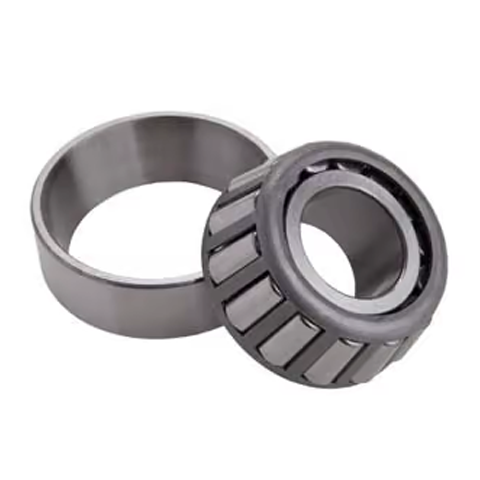
NTN NTN 32020XU Single Row Tapered Roller Bearing, D=100mm
NTN 32020XU Single Row Tapered Roller Bearing (Inside Dia - 100mm, Outside Dia - 150mm) SPECIFICATIONS Type of Product : Single Row Tapered Roller Bearing Inside Diameter (d) (mm) : 100 Outside Diameter D (mm) : 150 Width Dia mm : 32 Model No : 32020XU 1. Types, design features, and characteristics Tapered roller bearings are designed so the tapered vertex of the raceway surfaces of the inner and outer rings and rollers converge at one point on the centerline of the bearing (see Fig. 1).The tapered rollers are guided by the compound force of the inner and outer raceway surfaces which keep the rollers pressed up against the large rib on the inner ring.A large variety of these bearings, including single, double, and four row arrangements, are available in both metric and inch series. Each type and associated characteristics are shown in Table 1. For four-row tapered roller bearings, see section “C. Special application bearings.” Table 1 Tapered roller bearing types and characteristics Type Characteristics Single row taperedroller bearings (1) There are both metric and inch series adhering to the standards shown in the following table. Dimension series *Dimension series previously not covered by 3XX are regulated under JIS B 1512; dimensions previously missing from 3XX will henceforth use the bearing number. (2) In addition to the standard design, there are also medium contact angle and large contact angle types, denoted by the contact angle codes at the end of the part numbers (C and D, respectively). (3) Subunits Tapered roller bearings can be disassembled into parts: the inner ring, rollers, and cage (collectively known as the “CONE”) and the outer ring (known as the “CUP”). These are the bearing’s “subunits”. Subunit dimensions are standardized under ISO or ABMA standards, and unified subunits are interchangeable within each dimensional standard. However, high precision grade bearings are generally not interchangeable, and these subunits must be used by assembling only subunits with identical manufacturing numbers.Aside from any cautionary notes that may appear, the single row tapered roller bearings listed in the dimension tables have subunits standardized for both metric and inch systems (including J series). (Refer to Fig. 2) Single row taperedroller bearings (4) These bearings are constructed to have a high capacity for radial loads, axial loads, and combined loads. The larger the contact angle, the greater the axial load capacity. When a pure radial load is applied to a tapered roller bearing, an induced load in the axial direction is also generated, so these bearings are generally used in pairs.(5) Single row tapered roller bearings are separable, so both the inner and outer rings can be used with tight fits. (6) Tapered roller bearings are also manufactured with flanges attached to the outer rings. For more details, contact NTN Engineering. (Refer to Fig. 3) Duplex tapered roller bearings (1) When two single-row tapered roller bearings are to be used in combination, the bearing clearance and preload are adjusted by the inner ring spacer or the outer ring spacer (see Fig. 4).(2) A product number and a combination code are indicated on inner rings, outer rings, and spacers. Parts displaying the same number and code must be used in combination.(3) See A-96 Table 8.14 for the axial internal clearance. Double row taperedroller bearings (1) Back-to-back arrangement (using double row outer rings) and face-to-face arrangement (using double row inner rings) are both available. The assemblies have been adjusted so that each type's internal clearance values are fixed. Only parts with identical manufacturing numbers can be used and they must be assembled according to their code numbers. (Refer to Fig. 5)(2) See A-96 Table 8.14 for the axial internal clearance of double-row and duplex bearings. 2. Standard cage type In general, pressed cages (see Fig. 6) are used in tapered roller bearings. For large sized bearings, machined or pin type cages may also be used, while resin cages may also be used for smaller sized bearings. 3. Allowable misalignment In order to avoid edge loading and potential for premature failure, the maximum allowable misalignment based on bearing series can be found below.The allowable misalignment of combined bearings is influenced by the load center position, so please consult NTN Engineering.• Single row (standard) …………… 1/ 2 000• Single row (ULTAGE) …………… 1/ 600 4. Precautions If bearing load is light during operation, or if the ratio of axial to radial load for duplex and double row bearings exceeds the value of e, slipping may develop between the rollers and raceway surface, sometimes resulting in smearing. The mass of rollers and cages particularly tends to be large for large tapered roller bearings. For additional details, please contact NTN Engineering.In tapered roller bearings, the cage may protrude beyond the inner and/or outer ring side faces. Care should be taken when designing the housing and shaft to ensure contact with the cage does not occur.
$69.83
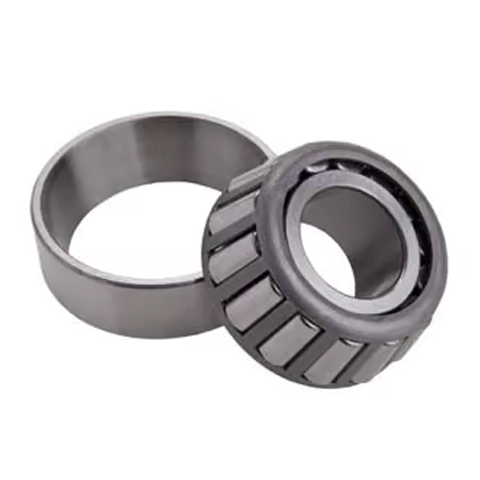
NTN NTN 32019XU Single Row Tapered Roller Bearing, D=95mm
NTN 32019XU Single Row Tapered Roller Bearing (Inside Dia - 95mm, Outside Dia - 145mm) SPECIFICATIONS Type of Product : Single Row Tapered Roller Bearing Inside Diameter (d) (mm) : 95 Outside Diameter D (mm) : 145 Width Dia mm : 32 Model No : 32019XU 1. Types, design features, and characteristics Tapered roller bearings are designed so the tapered vertex of the raceway surfaces of the inner and outer rings and rollers converge at one point on the centerline of the bearing (see Fig. 1).The tapered rollers are guided by the compound force of the inner and outer raceway surfaces which keep the rollers pressed up against the large rib on the inner ring.A large variety of these bearings, including single, double, and four row arrangements, are available in both metric and inch series. Each type and associated characteristics are shown in Table 1. For four-row tapered roller bearings, see section “C. Special application bearings.” Table 1 Tapered roller bearing types and characteristics Type Characteristics Single row taperedroller bearings (1) There are both metric and inch series adhering to the standards shown in the following table. Dimension series *Dimension series previously not covered by 3XX are regulated under JIS B 1512; dimensions previously missing from 3XX will henceforth use the bearing number. (2) In addition to the standard design, there are also medium contact angle and large contact angle types, denoted by the contact angle codes at the end of the part numbers (C and D, respectively). (3) Subunits Tapered roller bearings can be disassembled into parts: the inner ring, rollers, and cage (collectively known as the “CONE”) and the outer ring (known as the “CUP”). These are the bearing’s “subunits”. Subunit dimensions are standardized under ISO or ABMA standards, and unified subunits are interchangeable within each dimensional standard. However, high precision grade bearings are generally not interchangeable, and these subunits must be used by assembling only subunits with identical manufacturing numbers.Aside from any cautionary notes that may appear, the single row tapered roller bearings listed in the dimension tables have subunits standardized for both metric and inch systems (including J series). (Refer to Fig. 2) Single row taperedroller bearings (4) These bearings are constructed to have a high capacity for radial loads, axial loads, and combined loads. The larger the contact angle, the greater the axial load capacity. When a pure radial load is applied to a tapered roller bearing, an induced load in the axial direction is also generated, so these bearings are generally used in pairs.(5) Single row tapered roller bearings are separable, so both the inner and outer rings can be used with tight fits. (6) Tapered roller bearings are also manufactured with flanges attached to the outer rings. For more details, contact NTN Engineering. (Refer to Fig. 3) Duplex tapered roller bearings (1) When two single-row tapered roller bearings are to be used in combination, the bearing clearance and preload are adjusted by the inner ring spacer or the outer ring spacer (see Fig. 4).(2) A product number and a combination code are indicated on inner rings, outer rings, and spacers. Parts displaying the same number and code must be used in combination.(3) See A-96 Table 8.14 for the axial internal clearance. Double row taperedroller bearings (1) Back-to-back arrangement (using double row outer rings) and face-to-face arrangement (using double row inner rings) are both available. The assemblies have been adjusted so that each type's internal clearance values are fixed. Only parts with identical manufacturing numbers can be used and they must be assembled according to their code numbers. (Refer to Fig. 5)(2) See A-96 Table 8.14 for the axial internal clearance of double-row and duplex bearings. 2. Standard cage type In general, pressed cages (see Fig. 6) are used in tapered roller bearings. For large sized bearings, machined or pin type cages may also be used, while resin cages may also be used for smaller sized bearings. 3. Allowable misalignment In order to avoid edge loading and potential for premature failure, the maximum allowable misalignment based on bearing series can be found below.The allowable misalignment of combined bearings is influenced by the load center position, so please consult NTN Engineering.• Single row (standard) …………… 1/ 2 000• Single row (ULTAGE) …………… 1/ 600 4. Precautions If bearing load is light during operation, or if the ratio of axial to radial load for duplex and double row bearings exceeds the value of e, slipping may develop between the rollers and raceway surface, sometimes resulting in smearing. The mass of rollers and cages particularly tends to be large for large tapered roller bearings. For additional details, please contact NTN Engineering.In tapered roller bearings, the cage may protrude beyond the inner and/or outer ring side faces. Care should be taken when designing the housing and shaft to ensure contact with the cage does not occur.
$58.74
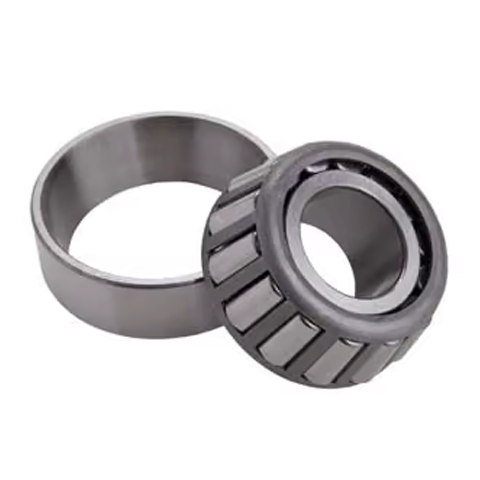
NTN NTN 32016XU Single Row Tapered Roller Bearing, D=80mm
NTN 32016XU Single Row Tapered Roller Bearing (Inside Dia - 80mm, Outside Dia - 125mm) SPECIFICATIONS Type of Product : Single Row Tapered Roller Bearing Inside Diameter (d) (mm) : 80 Outside Diameter D (mm) : 125 Width Dia mm : 29 Model No : 32016XU 1. Types, design features, and characteristics Tapered roller bearings are designed so the tapered vertex of the raceway surfaces of the inner and outer rings and rollers converge at one point on the centerline of the bearing (see Fig. 1).The tapered rollers are guided by the compound force of the inner and outer raceway surfaces which keep the rollers pressed up against the large rib on the inner ring.A large variety of these bearings, including single, double, and four row arrangements, are available in both metric and inch series. Each type and associated characteristics are shown in Table 1. For four-row tapered roller bearings, see section “C. Special application bearings.” Table 1 Tapered roller bearing types and characteristics Type Characteristics Single row taperedroller bearings (1) There are both metric and inch series adhering to the standards shown in the following table. Dimension series *Dimension series previously not covered by 3XX are regulated under JIS B 1512; dimensions previously missing from 3XX will henceforth use the bearing number. (2) In addition to the standard design, there are also medium contact angle and large contact angle types, denoted by the contact angle codes at the end of the part numbers (C and D, respectively). (3) Subunits Tapered roller bearings can be disassembled into parts: the inner ring, rollers, and cage (collectively known as the “CONE”) and the outer ring (known as the “CUP”). These are the bearing’s “subunits”. Subunit dimensions are standardized under ISO or ABMA standards, and unified subunits are interchangeable within each dimensional standard. However, high precision grade bearings are generally not interchangeable, and these subunits must be used by assembling only subunits with identical manufacturing numbers.Aside from any cautionary notes that may appear, the single row tapered roller bearings listed in the dimension tables have subunits standardized for both metric and inch systems (including J series). (Refer to Fig. 2) Single row taperedroller bearings (4) These bearings are constructed to have a high capacity for radial loads, axial loads, and combined loads. The larger the contact angle, the greater the axial load capacity. When a pure radial load is applied to a tapered roller bearing, an induced load in the axial direction is also generated, so these bearings are generally used in pairs.(5) Single row tapered roller bearings are separable, so both the inner and outer rings can be used with tight fits. (6) Tapered roller bearings are also manufactured with flanges attached to the outer rings. For more details, contact NTN Engineering. (Refer to Fig. 3) Duplex tapered roller bearings (1) When two single-row tapered roller bearings are to be used in combination, the bearing clearance and preload are adjusted by the inner ring spacer or the outer ring spacer (see Fig. 4).(2) A product number and a combination code are indicated on inner rings, outer rings, and spacers. Parts displaying the same number and code must be used in combination.(3) See A-96 Table 8.14 for the axial internal clearance. Double row taperedroller bearings (1) Back-to-back arrangement (using double row outer rings) and face-to-face arrangement (using double row inner rings) are both available. The assemblies have been adjusted so that each type's internal clearance values are fixed. Only parts with identical manufacturing numbers can be used and they must be assembled according to their code numbers. (Refer to Fig. 5)(2) See A-96 Table 8.14 for the axial internal clearance of double-row and duplex bearings. 2. Standard cage type In general, pressed cages (see Fig. 6) are used in tapered roller bearings. For large sized bearings, machined or pin type cages may also be used, while resin cages may also be used for smaller sized bearings. 3. Allowable misalignment In order to avoid edge loading and potential for premature failure, the maximum allowable misalignment based on bearing series can be found below.The allowable misalignment of combined bearings is influenced by the load center position, so please consult NTN Engineering.• Single row (standard) …………… 1/ 2 000• Single row (ULTAGE) …………… 1/ 600 4. Precautions If bearing load is light during operation, or if the ratio of axial to radial load for duplex and double row bearings exceeds the value of e, slipping may develop between the rollers and raceway surface, sometimes resulting in smearing. The mass of rollers and cages particularly tends to be large for large tapered roller bearings. For additional details, please contact NTN Engineering.In tapered roller bearings, the cage may protrude beyond the inner and/or outer ring side faces. Care should be taken when designing the housing and shaft to ensure contact with the cage does not occur.
$42.71















































